

What is the Customer Value Journey: The Roadmap to Inbound Marketing Strategy
- October 25, 2023
- By Vlad Kuryatnik
- The Customer Value Journey is a roadmap that enhances our inbound marketing strategies by building authentic and meaningful customer relationships, turning them into our biggest fans and advocates. It consists of six key steps: Awareness, Engagement, Conversion, Experience, Loyalty Loop, and Advocacy, each utilizing unique Digital Marketing tactics like Digital Advertising, Content Marketing, and Email Marketing to nurture and guide customers through the sales funnel.
- This approach attracts prospects and nurtures them into loyal customers excited to advocate for the brand. Centered around fostering meaningful relationships, this strategy leads to sustainable growth, enhanced customer loyalty, and a robust bottom line, highlighting the long-term benefits of a customer-centric inbound marketing strategy .
In today’s business landscape, building genuine relationships with customers is the gateway to success, and for business owners, embracing the “Customer Value Journey” presents a straightforward yet potent inbound marketing strategy to realize this goal.
Imagine Inbound Marketing not as a one-off effort but as a friendly journey where every step you take with your customers helps them feel more connected to your business.
What is the Customer Value Journey?
Imagine it as a roadmap, guiding your customers from the point they discover your business to the stage where they become your biggest fans. It’s a six-step journey about creating valuable interactions that feel personalized and engaging, not pushy.
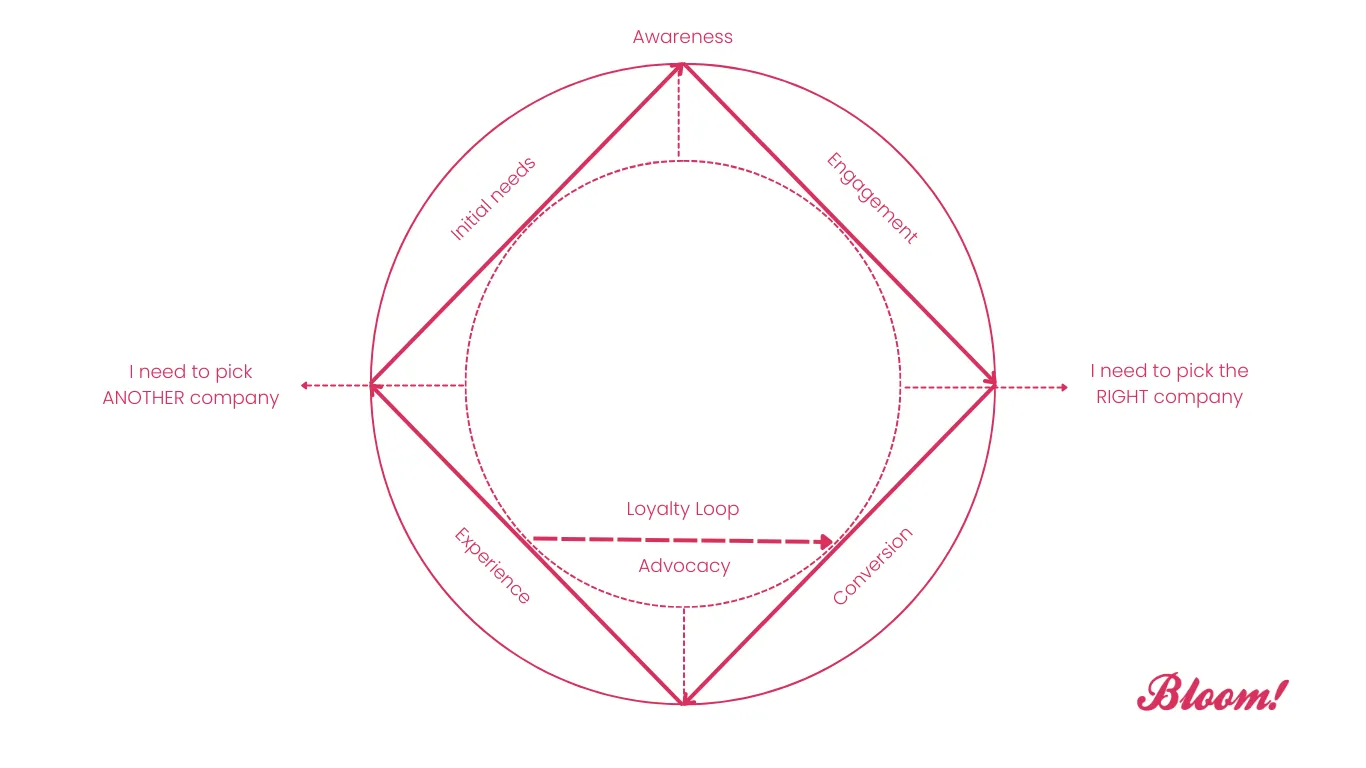
This inbound marketing strategy enhances the customer experience by adding value to every content piece and interaction.
This article breaks down this journey into simple, actionable steps, showing how to apply this approach to your inbound marketing efforts. Understanding and utilizing the Customer Value Journey will set your business toward lasting success and a community of customers excited to champion your brand.
Now, let’s explore these six steps.
Step 1: Awareness
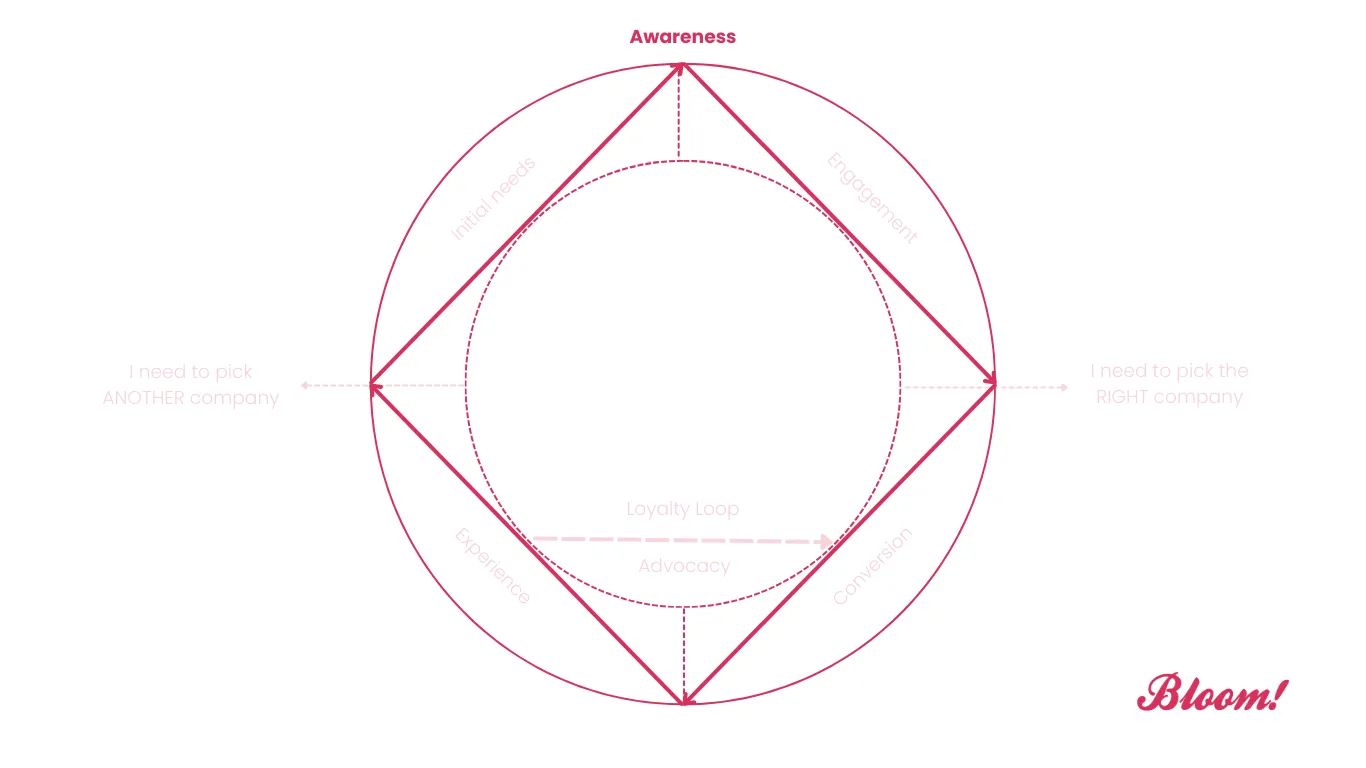
It’s the stage where your future client becomes aware of your brand, much like how people become aware of major players like Google or Microsoft.
For example:
- An IT company owner sees a LinkedIn advertisement for a new Inbound Marketing Agency (sounds familiar, huh?);
- A startup CEO searches Google and finds an article about a new project management tool.
To generate awareness, we use the following Inbound Marketing Tactics:
- Digital Advertising;
- Search Marketing;
- Content Marketing;
- Social Media Marketing.
Step 2: Engagement
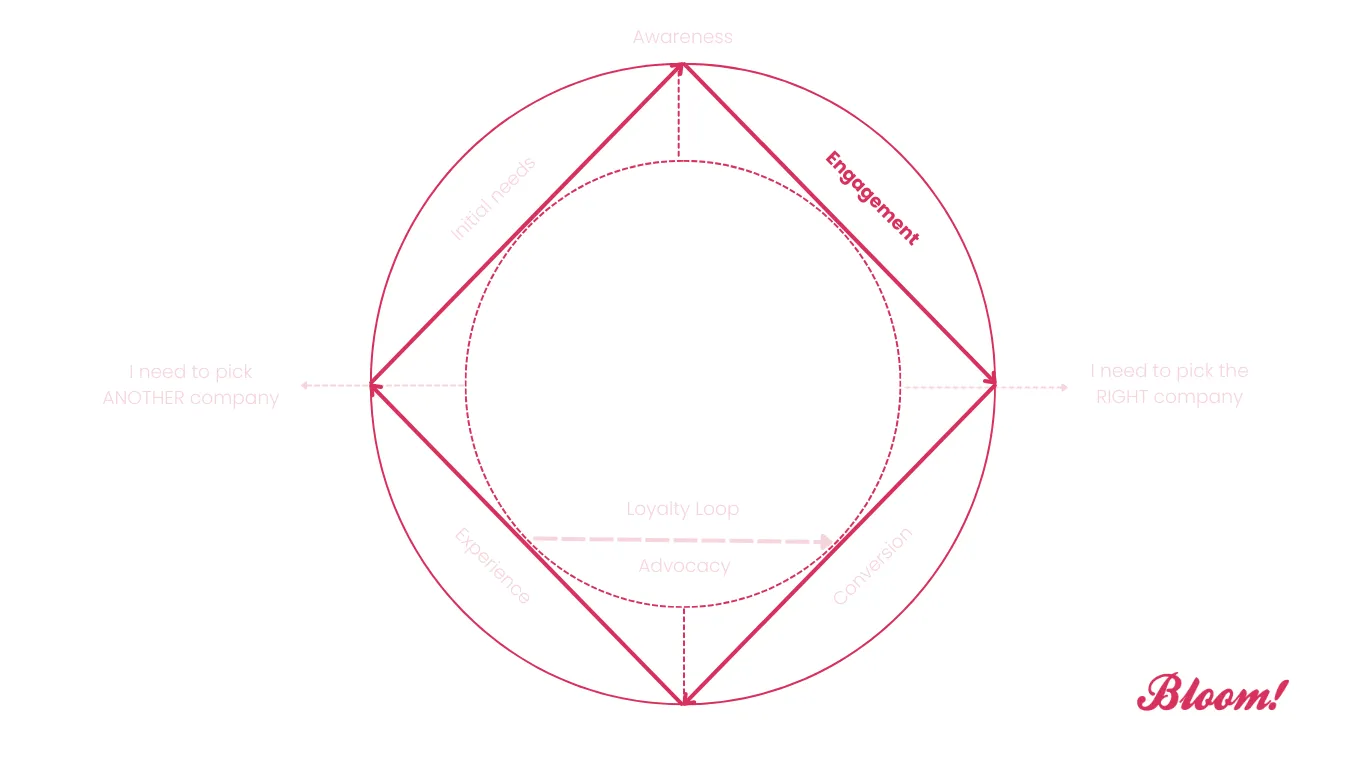
This is where relationships begin, through engaging content that provides value, entertainment, information, and so on.
- The owner of a car parts store becomes active in a Facebook community for other retailers;
- An entrepreneur watches a YouTube video from ManyChat showing him how to use chatbots to get a higher open rate.
To create engagement, we use the following Inbound Marketing Tactics:
- Email Marketing;
Understanding the customer value journey is key for IT companies striving to maximize their market impact. A key aspect of this journey is leveraging the immense Benefits of Digital Marketing for IT Companies . Effective digital marketing strategies enhance brand visibility and drive meaningful engagement with your target audience. It’s about creating a narrative that resonates with your clients, showcasing your technical prowess, and transforming complex IT solutions into relatable, client-centered stories. This approach can significantly elevate your company’s online presence, strengthening customer relationships and sustaining business growth.
Step 3: Conversion
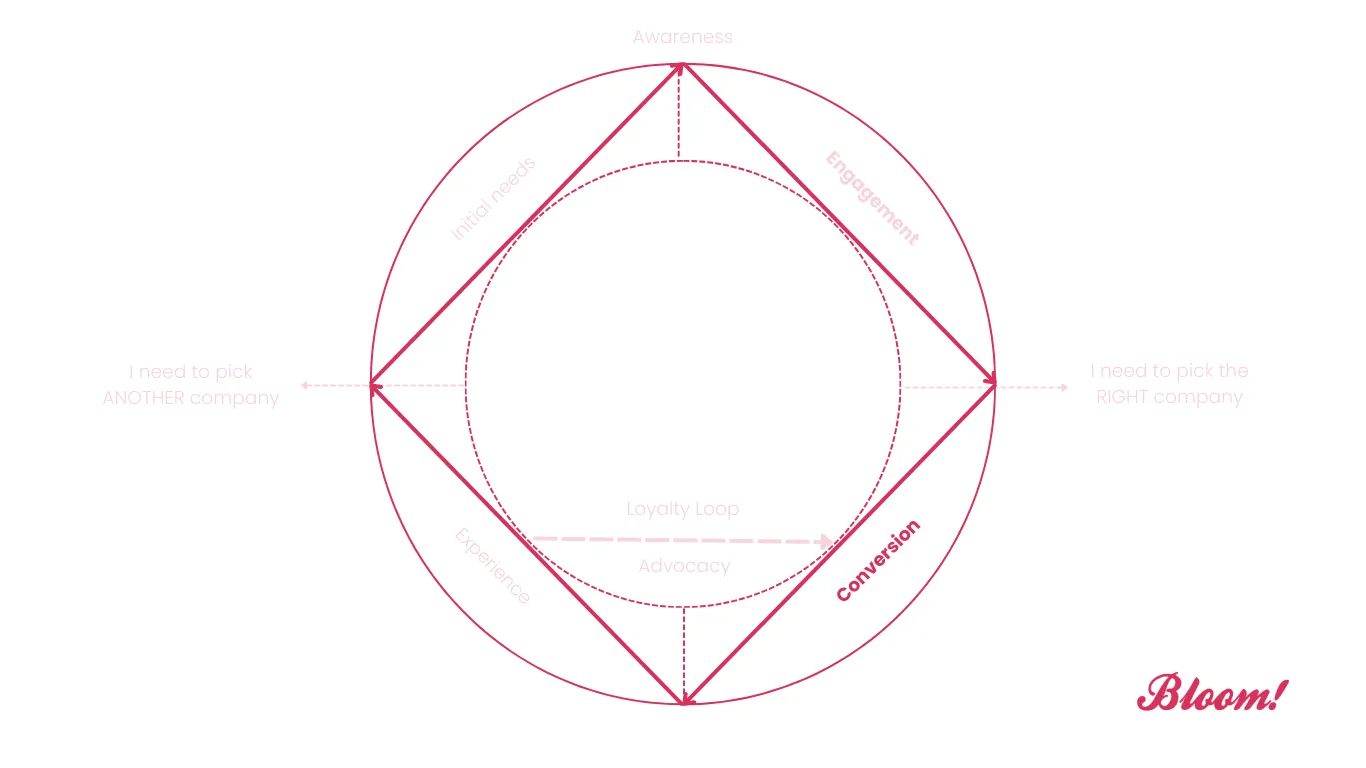
It’s where you acquire clients or raise the engagement level of your current leads.
- Someone purchased a cup of coffee and a cupcake at the coffee shop;
- Business owner hires an Inbound Marketing Agency to enhance online visibility, boost customer engagement, and increase conversions.
To generate conversions, we use the following Inbound Marketing Tactics:
- Copywriting;
- Search Marketing.
Step 4: Experience
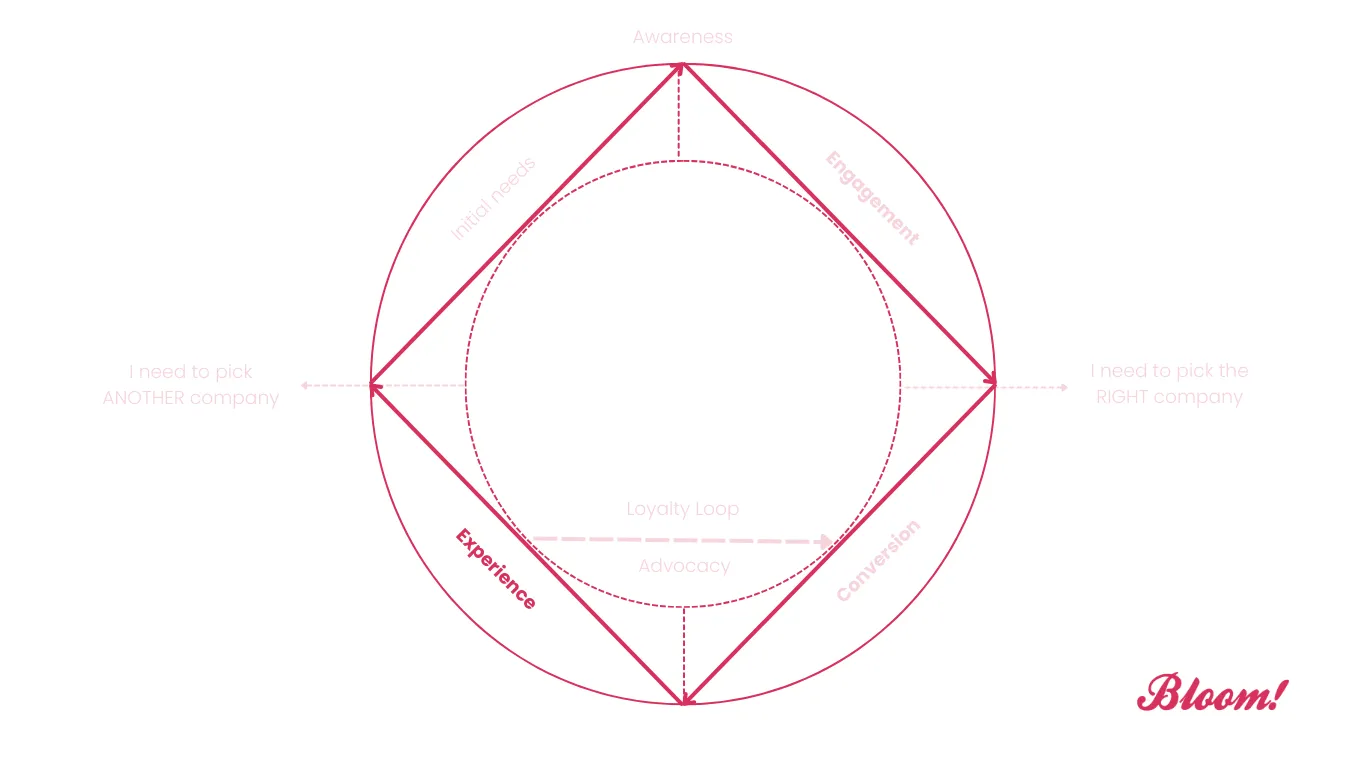
It’s about creating offerings that attract clients and encourage repeat business, ensuring customers derive value from each transaction.
- An onboarding campaign, which helps customers understand your product or service better;
- Free post-purchase support or next-purchase discount.
To create excitement, we use the following Inbound Marketing Tactics:
- Copywriting.
Step 5: Loyalty Loop
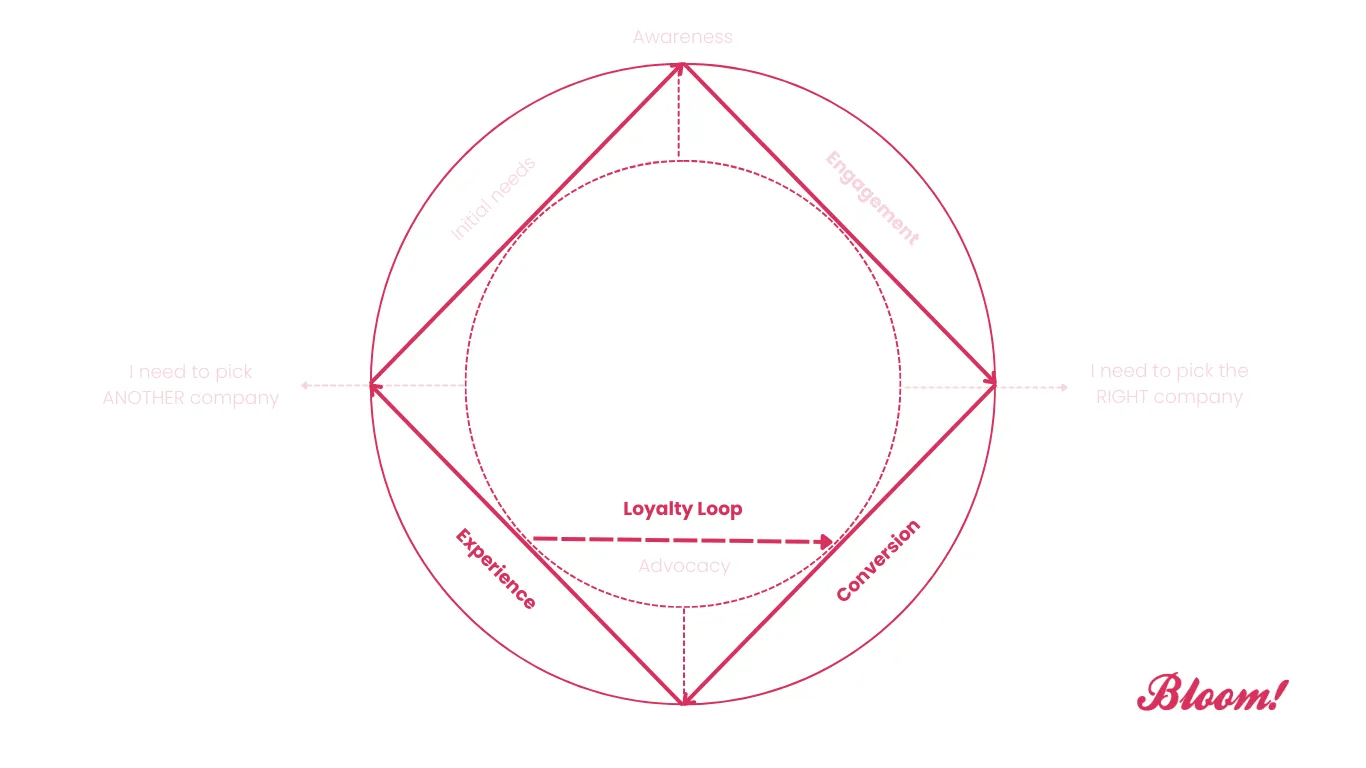
It’s where your clients will be ready to purchase more often.
- A man rents a car and pays extra for an extended support package;
- A couple buys a Netflix subscription for $119.88 annually instead of monthly payments.
To create ascension, we use the following Inbound Marketing Tactics:
Step 6: Advocacy
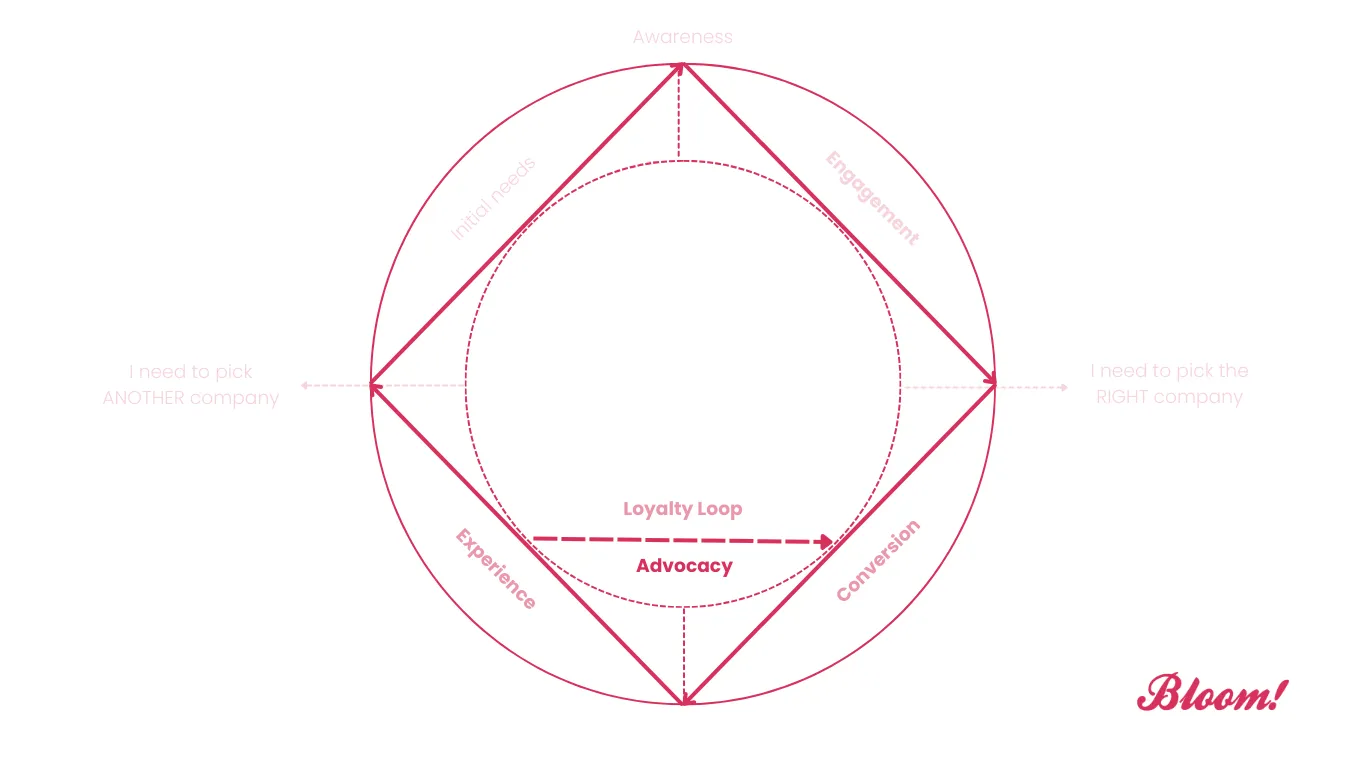
It’s where your loyal clients are ready to advocate for you.
- A girl takes part in a contest to win a new Apple iPad from a coffee shop by uploading a video review telling how much she loves their coffee and cupcakes;
- The VP of Marketing writes a detailed evaluation of the Inbound Marketing Agency he uses in small marketing projects.
To generate advocates, we use the following Inbound Marketing Tactics:
- Email marketing;
Inbound Marketing is not just a strategy; it’s a philosophy centered around fostering meaningful relationships with customers at every phase of their journey. By understanding and implementing the Customer Value Journey Map, businesses can transition from merely pushing products to creating a value-driven narrative that resonates with customers.
Implementing the tactics discussed in this article can help you create a holistic Inbound Marketing Strategy that attracts prospects and nurtures them into loyal customers excited to share your brand with the world. By embracing this customer-centric approach, you invest in sustainable growth and a community of advocates who will propel your business forward in the long term.
Engaging a skilled inbound marketing agency can simplify your journey in connecting with customers. Such agencies help create strategies that match each stage of your customer’s journey with your business. They help create engaging content and build genuine relationships with your audience, making the journey from a potential to a loyal customer smoother and more effective for your business.
This journey towards a successful inbound marketing strategy may require a shift in perspective. Still, the results—enhanced customer loyalty, improved reputation, and a robust bottom line—are worth the effort.
How can I measure the effectiveness of each stage of the Customer Value Journey?
The Customer Value Journey (CVJ) involves several stages, and measuring their effectiveness is crucial for optimizing your marketing efforts. Here’s how:
- Awareness : Track metrics like website visits, social media reach, and brand mentions. Use tools like Google Analytics or social media analytics to assess awareness growth.
- Engagement : Monitor engagement metrics such as time spent on your website, interaction with content (likes, shares, comments), and email open rates.
- Subscription : Measure the conversion rate from visitors to subscribers (e.g., newsletter sign-ups and app downloads).
- Conversion : Evaluate conversion rates for specific actions (e.g., form submissions, purchases). Understand which touchpoints contribute most to conversions.
- Excitement : Assess customer satisfaction, Net Promoter Score (NPS), and post-purchase engagement.
- Growth : Track customer lifetime value (CLV), repeat purchases, and upsells.
- Advocate : Measure customer referrals, reviews, and testimonials.
- Promote : Analyze the impact of customer advocacy on new customer acquisition.
How can I customize the Customer Value Journey to fit my business goals and audience needs?
- Segmentation : Tailor each stage based on audience segments (e.g., new customers, existing clients, high-value prospects).
- Content Personalization : Create relevant content for different stages – educational content for awareness, case studies for conversion, and loyalty programs for growth.
- Touchpoint Optimization : Optimize touchpoints (website, social media, emails) to align with audience preferences and behaviors.
- Feedback Loop : Continuously gather feedback from customers to refine the journey. Use surveys, reviews, and direct interactions.
- Iterate and Test : Regularly review and adjust your CVJ based on performance data. A/B tests different approaches to find what resonates best.
The Customer Value Journey is a strategic framework that guides customers from their first interaction with a brand to becoming loyal advocates. It focuses on creating a step-by-step roadmap for nurturing customer relationships effectively.
Why is the Customer Value Journey important in marketing?
Understanding the Customer Value Journey is vital for crafting marketing strategies that align with customer needs and preferences, leading to higher engagement, conversion, and retention rates.
How can businesses implement the Customer Value Journey?
Businesses can implement the Customer Value Journey by analyzing each stage – from awareness to advocacy – and creating targeted strategies that engage customers at every point, enhancing their overall experience.
What are the critical stages of the Customer Value Journey?
The key stages include awareness, engagement, subscription, conversion, excitement, ascension, and advocacy, each playing a crucial role in turning prospects into loyal customers.
Can the Customer Value Journey be applied to all types of businesses?
The Customer Value Journey is a versatile framework that can be tailored to fit various business models and industries, making it a universal tool for customer-centric marketing.
Keep Learning

We’re a digital marketing agency in Maine that builds marketing strategy, campaigns, websites, content, and creative for good-fit clients near and far. We’re 100% employee-owned and fully integrated with Ethos, a full-service, multi-platform branding agency.
A full-service multiplatform branding agency with which we are fully integrated in our offices by the beautiful Presumpscot River.
We work in many different fields but have developed specialties in a few key industries:
a full service branding agency
Inbound Marketing 101 (Part 3): Customer Journey Mapping – What Is It and How Can It Make You a Smarter Marketer?
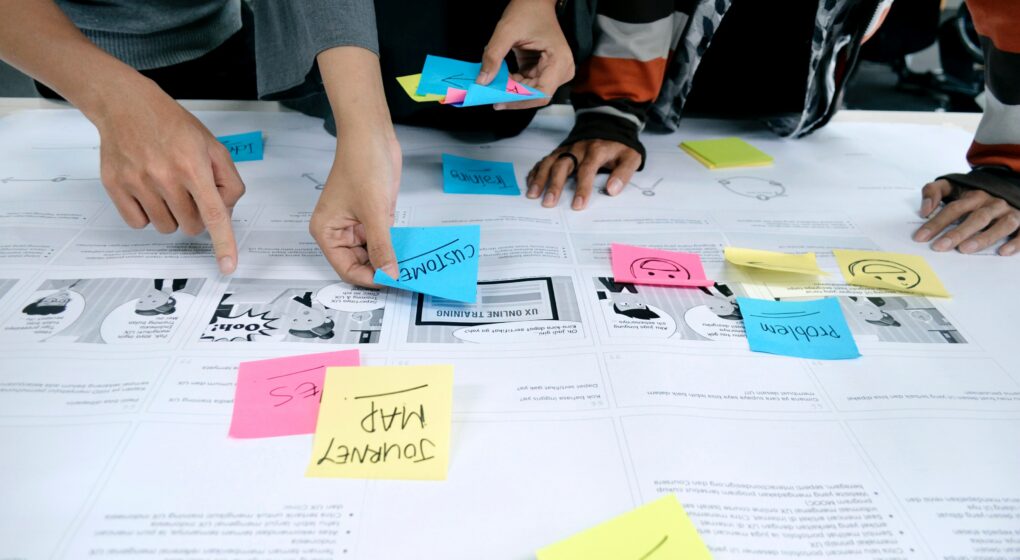
As a marketer, you’re about as close to your brand as anyone can be. You know the ins and outs of what works for your brand and what doesn’t. On the flip side, you probably also know that this close perspective can sometimes make it difficult to look at your marketing and branding efforts with a critical eye. If you’re asking yourself, how can I ensure that my efforts are really working for my prospects and customers? Well, cue customer journey mapping – one of the best ways to not only take stock of your marketing efforts at every marketing funnel stage, but also to analyze how your prospects and customers are feeling at every touch point. Customer journey mapping is a great way to put yourself in your customers’ shoes, understand their emotions and feelings, look out for pain points, and truly understand how to optimize your marketing campaign(s).
We’ll take you through our approach to customer journey mapping and show you exactly how it can help you streamline your marketing plans and reveal your tactical priorities.
What is the Customer Journey?
Put simply, the customer journey is the process through which a lead or customer interacts with a brand in order to achieve a specific goal (e.g., a conversion). Your conversion goal for your customer journey could range from gaining blog subscribers or newsletter signups, to customers actually making a purchase on your site.
As you start to consider this process, think about the many ways you engage with customers when they’re on your site, social media, or interacting with your brand. Your brand undoubtedly has several touch points with the lead or customer throughout the customer journey, including:
- Landing pages
- Email newsletters
- Organic or promoted social media posts
- Paid advertising
- Blog articles
- Search engine listings
Now that we have a general understanding of the touch points with a customer (a.k.a. the customer journey), let’s dive into the mapping…
What is a Customer Journey Map?
A customer journey map is a visual representation of the customer journey that maps out all the touch points between your brand and your leads/customers.
It’s important to note that you can use customer journey maps to track just one part of the customer journey, or can use them to look at the entire journey holistically. For example, you can simply look at the journey a customer takes between an awareness stage tactic such as a search engine marketing and when they sign up for emails from your business, or you can look at their entire interaction with your brand from awareness through to actually making a purchase and (hopefully) becoming a loyal customer.
Using Customer Personas in Journey Maps
Last month, we reviewed how to create and use customer personas for your inbound marketing and content marketing strategies. Well, customer personas can also help increase the accuracy of your customer journey maps. See? There’s a method to our madness.
Looking at the customer journey as it specifically relates to your different customers and their unique preferences and needs is extremely valuable, so you should consider creating separate journey maps for each persona. As you do this, think about the customers’ demographics, motivations, needs, frustrations, and goals (all of which you noted in your customer personas) and incorporate those into your journey map to get a more detailed view of the journey for your key customer groups.
Now let’s move away from the “how it works” to the “how on earth do I do this?” We’ve got you covered.
How to Create a Customer Journey Map
A better understanding of your customers’ experiences with your brand sounds great, right? But how do you actually go about creating an accurate and detailed customer journey map? Well, we’re kind of pros at this, so let us help!
Customer journey mapping is a complex process that takes some time to execute and should always be rooted in real data and structured around very specific goals. Similar to customer personas, there may be moments where you have to make some educated guesses about the journey or your customers’ emotions, but those guesses should always be based on what you do know concretely – for example, if you can see that one of your key web pages has a high bounce rate, it’s likely that there is something thorny about the page experience, layout, or content that needs improvement.
So let’s get into it and start journey mapping!
Step 1: Gather your team
Customer journey mapping starts with assembling the right team of internal stakeholders from your business. You’ll want to involve all key marketing personnel in the process, and you’ll also want to bring in representatives from your sales and/or customer service teams. These are the people who interact with your customers regularly and hear tons of feedback, receive questions, and troubleshoot problems with them. You’ll also want to involve your in-house web development and/or UX (user experience) stakeholders. These are the people who know your website like the back of their hand and can help you dive into what is or isn’t working about your website.
Step 2: Set your goals
If you’re going to make the investment in customer journey mapping, you should have very clear goals for what you want to achieve with the journey map. Are you looking to increase lead capture? Do you want to improve your customer service experience? Do you want to sign members up for a loyalty program? Do you want to increase product sales? There are so many things you can learn from a journey map, so spend some time thinking your goals over with your journey mapping team, and outline four or five goals that will help structure the mapping process from start-to-finish.
Step 3: Make a list of your touch points
Sit down with your team and list out all of the touch points in the customer journey at the awareness, consideration, decision, and loyalty stages. Make sure not to leave any touch points out, no matter how small or insignificant it may seem. The devil truly is in the details when it comes to customer journey mapping.
Step 4: Gather data for each touch point
Data you’ve collected from your various touch points will be key to understanding performance within the customer journey. Here are a few examples of data sources for some common touch points:
- Email Marketing: Performance data from your marketing CRM (customer relationship management system) or email platform such as open rates, click-through-rates, conversion rates from emails, popularity of certain links or calls-to-action, subscriptions, unsubscribes, etc., will help you understand how well your email content resonates with your audience and what generates the most engagement.
- Website Performance/Search Engine Optimization (SEO): Google Analytics is a powerful tool for marketers. It provides data that dives a little deeper into your website traffic, content performance, and conversion goals, while also giving you some great insights into your audience . You can learn about their demographics, interests, behavior, and their flow through your website, meaning that you can dial in your analysis to look at something as niche as how well your content performs or how high your conversion rates are for people in a particular age group, gender group, and interest category. This is valuable information when it comes to mapping the customer journey and understanding customers’ reactions to/with your digital touch points.
- Social Media: It’s 2022 – so that means that if you have a business, chances are you have one or multiple social media profiles promoting the work you’re doing. Not only do large numbers of people turn to social media as a source of news and information, but they also interact with social media content in ways that allow you, as a marketer, to get a unique picture of their needs, preferences, and behaviors. Before you start journey mapping, take a look at your social media metrics and look at things like engagement, number of followers over a defined time period, content click-through-rates, impressions and reach, and referral traffic from social. It’s also a good idea to take an audit of comments and reactions to your social media content and see if you can identify any patterns in customer feedback.
Pro Tip: You can also audit Google reviews in the same way you audit social media engagement to identify trends in your customers’ experiences.
Step 5: Gather anecdotal feedback from your team members
Anecdotal feedback is just as important as hard data from your digital touch points, as it lets you get to know more about your customers and their experiences from the members of your team who regularly interact with them. Set up some time to sit down with your Customer Service or Sales teams and ask them if they’ve noticed any trends in their conversations with customers, or if they get the same questions time and time again across your customer base. Are there any pieces of feedback or commonplace paint points that your team is identifying? If yes, then that’s a good thing to add to the data you’ve already gathered. Please note that if you don’t have a sales or customer service team, you can use your own knowledge about your customers combined with social media or Google reviews.
Step 6: Make it visual
You’ve come a long way by doing a lot of front end research and data collection – now for the fun part: actually drawing out your customer journey map. There are a variety of different ways you can create it. You can do this by hand on a whiteboard or piece of paper (be sure to take a photo or store in a safe place so you don’t lose your work!), use a spreadsheet, or borrow a premade template like these from Hubspot . We prefer to use editable templates from Figma to lay ours out according to the stages of the marketing funnel. At the top of your map, list out all of the stages of the funnel from left to right, and then list out all the corresponding touch points below each stage. Then, use your data to surmise what actions users are taking at each touch point and note them on your journey map. Next, and again using your data, note the customers’ general emotions as they interact with and take action at each touch point. You can also use this step to highlight the most helpful pieces of feedback you’ve collected from customer reviews or from your customer service or sales team. Be sure to look for and highlight all pain points and areas of delight customers experience along the journey.
Now you have an accurate representation of the customer journey as it stands currently. Next, you’ll need to figure out what opportunities there are to improve it and create your “ideal” customer journey. On your map, create another row below your customer reactions and work with your team to list out opportunities and tactics that will help ease the pain points and delight your customers. This final step will serve as your guide for marketing planning and journey optimization.
If you want to go one step further – and we recommend this if you have the resources and want to focus on holistic optimization of the journey – you can create an entirely separate map that represents the ideal journey. It will look similar to your initial map but won’t include any of the pain points or areas of confusion that exist in the current journey. Think about what strategies and tactics you’ll need to utilize in order to ease the pain points and how they can be applied to the journey realistically depending on your resources. This “ideal journey” will serve as a guide for the implementation of your ongoing marketing strategies.
The Takeaways on Customer Journey Mapping
Customer journey mapping is beneficial because it allows you to approach your marketing planning in an informed way, guided by robust data, an accurate representation of what is and isn’t working for your customers, and a step-by-step plan for mitigating any pain points in your journey. It takes quite a bit of effort to map the customer journey, but ultimately it will make you a much smarter marketer.
If you are curious about inbound marketing and its benefits for your business, check out these previous blog posts that give an inside look at what inbound is and how it could be useful to your business:
- Everything You Ever Wanted to Know About Inbound Marketing – Why Inbound?
- Inbound Marketing 101: Customer Personas and Business Use Cases
And, if you want to map your customers’ journeys but need some assistance or advice, the inbound marketing team at VONT will be glad to help you out, so give us a shout!
About VONT Performance Digital Marketing
At VONT we believe that change is the only constant in the digital world – and that excites us. When tools and environments are constantly changing, new opportunities to help our clients achieve success are constantly arising. Each new advertising technology, social platform, or design approach allows us to improve on the results we achieve for our clients.We believe in this idea of continual fine-tuning so much that we named our company VONT, which means to achieve exponential improvement in incremental steps. It is our core belief, and the reason why we are not simply a web design company or simply a digital advertising agency , but rather a long-term, single source partner providing a comprehensive array of web development and digital marketing capabilities.

Categories:
BROWSE ALL CATEGORIES
Let’s chat.
We work with all kinds of clients (and all kinds of budgets). Say hi for a friendly, free chat.
Inbound Marketing #4: How to Use Customer Journey Mapping for Competitive Advantage
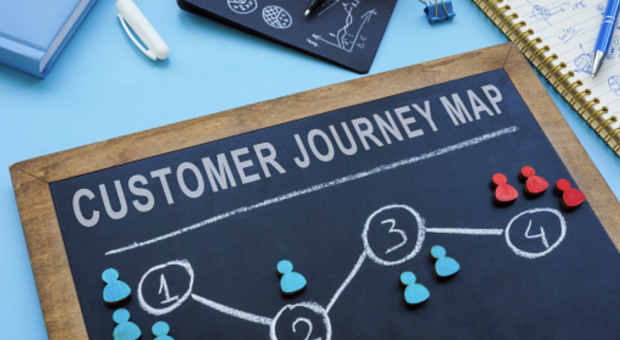
Inbound Marketing 101 (Part 2): Customer Personas and Business Use Cases
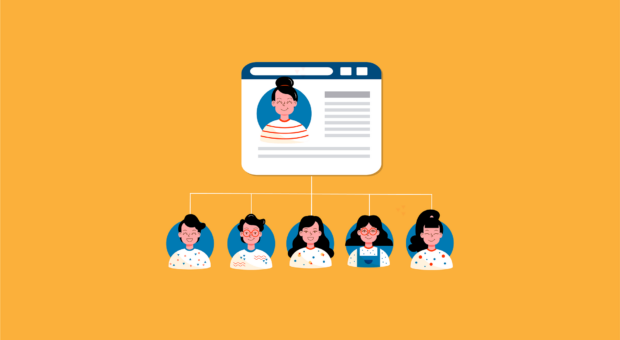
We’re on the list! We’re thrilled to share that our consistent, strong growth over the years has earned us the honor of being a member of the Inc. 5000 Class of 2023 !
Inbound Marketing and the Customer Journey: 2 Buzzwords Worth Paying Attention To
Marketing automation. Micro-moments. Native storytelling. There are plenty of buzzwords swirling around the digital universe right now. Two absolutely worth paying attention to are inbound marketing and the customer journey .
Chances are good that you’ve already heard these and may even use them. At OBI Creative , we incorporate inbound marketing and the customer journey into every project we tackle for our clients because we understand that proper execution of them is essential to marketing success.
Here, we break down the benefits of inbound marketing, share some of the best inbound marketing strategies and make the case for including inbound marketing and the customer journey in your business vocabulary.
Where are your ideal audiences why should you care about the customer journey?
Around the lunch table the other day, we overheard part of a conversation about the best sci-fi series on television. The semi-serious debate turned hilarious when one person said to the other, “It’s Star Trek! Not Star Track! They’re on a journey, not a treadmill!”
Whether you’re a sci-fi fan or not, that line is super helpful in understanding what approach you’re taking to marketing to your customers. If you realize that every interaction your customers have with your brand is part of a journey they are on that moves them from having no relationship with your business to arriving as a loyal advocate, then you believe in and practice the idea of customer journey.
If you believe instead that you can broadcast your message to your customers who will statically receive it and act accordingly, in practice, you’re thinking of them as being on a treadmill instead of a journey.
Customer journey is the new reality . The Internet saw to that when it dealt brand loyalty a death blow. Brands cannot expect customers to stay with them today because they delighted them yesterday. The consumer sentiment is largely, ‘what have you done for me lately’ and not ‘I love what you did for me two years ago.’
Inbound marketing is better than broadcasting and here’s why.
Even if your brand doesn’t run TV commercials, buy outdoor billboards or purchase air time on satellite radio, you might be guilty of designing your marketing strategy with a broadcast mindset instead of an inbound marketing mindset.
What’s the difference?
Let’s answer that question with a quick and painless quiz. Think about the most recent campaign you ran.
- How many of your messages were about your products or services?
- Did your display ads talk about product benefits or features?
- Do your last five blog posts talk more about your customers’ problems or your brand’s solutions?
If your marketing messages talk largely about your products and services, you may be approaching marketing from a broadcast mindset. Inbound marketing is different because it appreciates that customers interact with your brand at different points in the buying process.
It understands that customers are on a journey, not a treadmill.
Inbound marketing and customer journey go together like peanut butter and jelly.
We practice inbound marketing religiously, and not just because we’re a Hubspot-certified agency . It’s because our roots are in research and it, along with strategy, underpins everything we do for our clients. It’s why we developed the O’Brien Voice of the Customer (o.VOC), our study of the experience or interaction between a company and its customers from their perspective.
Inbound marketing presumes that the goal of marketing is to delight your customers. The better you understand your customers — what makes them tick and what ticks them off , the more leads (and sales) your marketing efforts will generate. Delight is not only how you define inbound marketing, it is central to how to do inbound marketing.
Just as important as understanding your customers’ pain points, is knowing what stage of the buying process they are in and then tailoring your marketing messages to that stage.
Defining the Three Stages of the Customer Journey
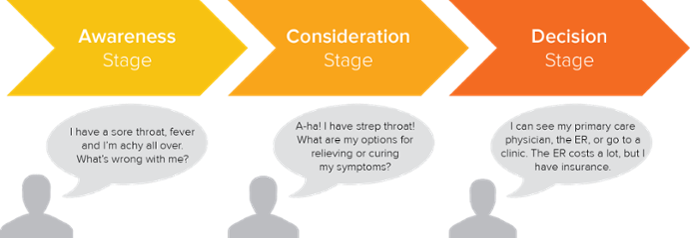
The Buyer’s Journey Example via Hubspot .
Inbound marketing leverages awareness of the customer journey in its four-step methodology:
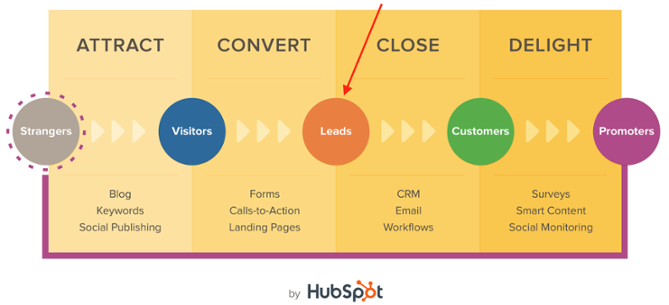
The Hubspot Inbound Methodology via Hubspot .
Knowing where your contacts and clients are in the customer journey helps you send the right messages to the right people at the right time, which results in marketing success for you AND your customers! This is how inbound marketing and the customer journey fit together.
Attract the Right People
In the awareness consideration stage, you want to attract your audience with information that addresses their problems. Since people at this stage are just realizing they have a problem, keep your content focused around that and keep your solutions out of it.
Convert Leads into Customers
In the consideration stage of the customer journey, people have defined their problems and are actively researching ways to solve them. Forms, calls to action and landing pages can all be tools to help you provide your prospects with information about the benefits and features of products or services that can help meet their needs or solve their problems. Think of your brand as a helpful resource, providing the information they need to make an informed decision.
Close Sales with Timely Content
In the decision stage, your audience is finally ready for your sales pitch because they now know what their problem is, what solution they want and are ready to buy. If you’ve built trust and delighted them along the way, they will naturally turn to you, their trusted resource, for their purchase.
Delight Your Base
After the sale, continue to market to your new customers with information that delights them. The best inbound marketing strategies include surveys, smart content and social monitoring because all are helpful ways to nurture the relationship you enjoy and keep customers coming back to you for their ongoing needs.
What questions do you have about the benefits of inbound marketing? Do you use buyer personas as part of your inbound marketing strategies? How do you do inbound marketing at your agency or business?
Share this article
Navigating Your Post-Pandemic Marketing Strategy
The world of marketing and advertising was shaken by the pandemic. The sudden cease of nearly all public gatherings pushed the industry into a new age of digital marketing, and companies had to adapt to succeed. With the pandemic winding down, how many of the changes are here to stay? And how can the industry adapt to a post-pandemic landscape?
Read the story
How To Build an Integrated Marketing Plan
Everywhere you look, you find messages that resonate with you and complement what you’ve already heard about a brand. Every message is different, but consistent. Every engagement moves you further through the marketing funnel until you purchase. This kind of marketing doesn’t just happen. Integrated marketing follows a proven formula.
Thought Leadership Marketing: The Power of Your Personal Brand
The terms “thought leadership” and “personal brand” occur in conversations across both business and social […]
Hey there! Free trials are available for Standard and Essentials plans. Start for free today.
What Is Inbound Marketing?
Inbound marketing is a great way to draw customers to your business. But what is inbound marketing?
Successful inbound marketing happens when you create high-quality content that keeps visitors to your site engaged. You need to generate interesting content across all of your platforms. You can choose to promote it, but it'll also generate unpaid, organic traffic through search.
While inbound marketing is about sales, it isn't just about turning a profit. It's about helping people. It's a powerful sales technique that works best when combined with a more traditional approach like outbound marketing.
Understanding inbound marketing
There's a methodology for successful inbound marketing. You use inbound marketing to drive sales and increase revenues by building long-term relationships with your customers. You empower consumers, prospects, and repeat clients with the information they want and need at every stage of their journey with your brand. Inbound marketing pulls customers to your site with relevant content and valuable information that visitors find helpful.
You become partners in their success. Or, put another way, when your customers experience success and satisfaction, your site revenue increases.
Most marketers identify 4 key activities in inbound marketing:
You attract strangers, convert visitors, close leads, and delight customers.
Let's take a look at these four activities in more detail.

Attracting customers sounds like a simple concept. But there's more to drawing in customers than optimizing your on-page SEO and blasting out new content.
Before you even think about your content strategy or invest endless hours studying how search engines work , you must decide who your ideal customer is. Spend some time developing a buyer persona, an avatar of the kind of customer who will keep coming to your site for information and will think of you first when they're in the market for the types of products you sell.
Consider the kinds of content that you can provide that match what your ideal customer is looking for on the internet. That's the point at which you perform search engine optimization (SEO). When assigning a ranking to your page, Google isn't limited to your keywords, but frequently searched keyword phrases give you a great way to expand your reach. Then, you can build unique content that provides value.
Once you have attracted a visitor to your site, you want to convert them to a lead. A lead is someone who wants more details about your brand and who gives you information (like their name, email address, and content preferences) in return.
How do site visitors become leads?
You can convert visitors into leads with a call-to-action, also known as the CTA. The CTA can be "Buy now!" But it can also be a request to be added to your marketing email list, download an ebook, or schedule a demo. Quality leads also include enough information to power your outbound marketing efforts. Visitors who give you their email addresses and ask to be added to your email lists are interested in what you have to offer.
The whole idea of digital marketing is digital sales, right? Once you have attracted your ideal customer and converted them into a lead, it's time for your sales team (or just you, if you are a sole proprietor working alone) to close the sale.
Keep in mind that you may have to move a prospect through your sales funnel. Many leads won't be ready to become paying customers at first. But polite persistence pays off.
There will usually be a back and forth process until your lead closes the deal and becomes a paying customer. Congratulations! You made a sale!
However, you need to continue delighting them to encourage them to buy more in the future.
The delight stage is where the fun of digital marketing starts. You have successfully guided your customer through the buyer's journey. Now it's up to your content marketing team to keep in touch and give them more information about the solutions they need. Your sales team must make sure your products are meeting their expectations.
Inbound marketing vs. outbound marketing
Inbound marketing is a sales tool that draws customers to your site with content and curated experiences that you have tailored to their preferences.
On the other hand, outbound marketing interrupts your customers with information they don't necessarily want. Inbound marketing matches your content to the intent of an internet search. With the right inbound marketing strategy, your site provides the information potential customers believe they need and the experiences they find satisfying.
There was a time when outbound marketing was all you needed. All you had to do, at least in theory, was buy a list of targeted email addresses and bombard potential customers with sales letters and offers.
Modern spam filters make email marketing without an opt-in process a thing of the past. However, this kind of push marketing was never particularly effective.
Other traditional tools of reaching customers, such as mass media campaigns, conferences, seminars, and print ads, are similarly outdated. Customers don't have to wait for you to come to them. They can actively search for you on the internet. But you can attract, convert, close, and delight your customers with the power of inbound marketing.

Benefits of inbound marketing
When done right, inbound marketing can help you:
- Grow your audience
- Control your costs
- Deepen trust
- Generate qualified leads
Keeping customers delighted with their purchases makes growing your target audience easy. Your customers spread the word about your site through the digital equivalent of word of mouth. They post reviews and comment about your expertise, products, and service on social media.
Gen Z customers may post on Instagram about your products, while Millennials and Gen Xers may comment on Facebook. Older consumers may support your customer retention strategy with old-fashioned face-to-face recommendations. Whether you're working with blogs, whitepapers, or infographics, your inbound marketing strategy can help you meet all of your marketing and revenue goals.
How to create an inbound marketing strategy
To create an inbound marketing strategy, you will:
- Determine your goals . It's a good idea to align your business goals with your marketing goals. Make sure to use SMART goals when setting your objectives.
- Identify marketing triggers . Marketing triggers are moments in which a site visitor behaves in a desired way, thus prompting an action to occur. For example, when they sign up for your newsletter or provide their contact information for a free ebook.
- Outline the buyer's journey . Outlining the buyer’s journey, or sales funnel, can help you determine when to make contact with potential clients.
- Invest in the right tools . The right tools can help your team become more efficient and speed up workflows.
- Create valuable content . Optimized content that brings value to the reader can attract visitors to your website and eventually turn them into customers.
- Use different channels . By using different channels, you can distribute your content and maximize your reach.
- Review and optimize . It’s a good idea to regularly review and optimize your content to make sure that it’s the best.

If you’re looking to use inbound marketing at your business, here are a few examples of content you can create to help you get started:
- Whitepapers
- Email newsletters
- Infographics
10 inbound marketing strategies
Now let's discuss some of the pieces of an effective inbound marketing strategy.
Segment your audience
Divide your audience into categories based on their shared interests. Remember, meaningful audience segmentation relates to your content, not just to the many ways you could classify the visitors you attract to your site in groups.
Conduct surveys
Building surveys and analyzing survey data doesn't have to be complicated. Mailchimp can provide a web link collector that aggregates responses and displays data summaries on a console.
Establish customer personas
We recommend creating an avatar for your ideal customer as the very first step of your inbound marketing campaign. That doesn't mean your ideal customer will stay the same as you grow your company, add new products, and explore new markets. Creating customer personas for all your product pages needs to be a periodic task that you update regularly.
In the digital age, search engine optimization is essential for online success. Keep in mind that Google matches your content to its metrics based on the search intent. As masses of people look for different things, Google will evaluate different aspects of your page for its ranking. SEO is something you keep doing even after you publish your page.
Create great content
Make sure your content is easy to read. Your pages need to be accessible, which means you must add descriptions to images for people who can't see them, and summaries of audio content for people who can't hear it. Make sure your pages are sized for the devices consumers use. Your content should be readable on every kind of screen.
Stay active on social media
Social media isn't just Facebook anymore. Keep up with Instagram, TikTok, and all the new social platforms.
Build email campaigns
Once you have an inbound marketing strategy, then you can make effective use of outbound marketing. Mailchimp has a complete suite of tools for building email campaigns.
Enhance your website
Focus on U/X. User experience keeps leads coming back, allowing you to convert them to customers.
Perform A/B testing
Not sure what works? Don't guess; test! Run A/B testing before you commit to a single strategy for your pages.
Get backlinks
Backlinks are a form of marketing. Backlinks anchored to relevant keywords from quality sites helps Google find and index your pages.
Enhance your inbound marketing efforts with Mailchimp
Inbound marketing can help your business in many ways. Not only is it a cost-effective tactic that can expand your reach, but it can also allow you to build trust and ensure you attract the right type of customer to your brand. To create a successful inbound marketing campaign, think carefully about your goals and segment your audience to ensure you’re targeting effectively.
If you want to enhance your inbound marketing efforts, we’re here to help. With our collection of marketing, automation, and email tools, you can generate more engagement and revenue. Plus, our Customer Journey Builder allows you to easily create trigger emails based on where people are in your sales funnel.
What is Inbound Marketing? The Ultimate Guide & Strategy
Inbound marketing is a marketing strategy focusing on attracting customers to a business rather than using traditional methods of interruption marketing
Inbound marketing is a powerful business methodology that prioritises building trust and long-term relationships with customers. Instead of using aggressive sales tactics, inbound marketing attracts, engages, and delights customers by providing valuable and relevant information. By aligning content with the interests of their target audience, businesses position themselves as experts in their field and organically attract visitors to their website, whom they can convert into loyal customers over time.
Inbound marketing encompasses various tactics, including search engine optimisation, content marketing, social media marketing, and email marketing. By creating a plan that outlines their target audience, content types, and engagement tactics, businesses can effectively implement an inbound marketing strategy that attracts and retains customers in a natural and cost-effective way.
In this guide, we will provide an introduction to the basics of inbound marketing and how it can help businesses of all sizes grow. We will also offer resources to help businesses get started with their own inbound marketing strategy and track and measure the effectiveness of their efforts. Whether you are just starting or looking to improve your existing strategy, this guide will provide valuable insights into the world of inbound marketing.
What is Inbound Marketing?
Inbound marketing is a strategy used by businesses to attract potential customers by creating valuable content and experiences that address their needs and interests. This approach focuses on attracting customers through various channels such as social media, blogging, search engine optimization (SEO), email marketing, and more. Unlike traditional outbound marketing techniques that aim to push messages out to a large audience in hopes of attracting a few potential customers, inbound marketing is all about creating meaningful relationships with customers. By providing relevant and helpful content, businesses can build trust with their audience and ultimately convert them into loyal customers. The inbound marketing methodology follows a four-stage process: attract, convert, close, and delight. Attracting potential customers involves creating content that addresses their needs and interests and distributing that content across relevant channels. Converting these leads into customers involves offering them something of value in exchange for their contact information, such as an e-book or whitepaper. The next stage, closing, involves nurturing these leads and guiding them towards a purchasing decision. Finally, the delight stage involves creating a positive customer experience that leads to repeat business and advocacy. Inbound marketing is a cost-effective and measurable way for businesses to grow their customer base and build lasting relationships with their audience. By providing valuable content and experiences, businesses can create a loyal following and ultimately drive revenue growth.
Why Should My Business Use Inbound Marketing?
The inbound methodology is a customer-centric approach to marketing. It's based on the idea that if you help people, they will ultimately do business with you.
In contrast, outbound marketing interrupts strangers and customers with irrelevant ads and cold calls, hoping to convert them into leads. Outbound marketing is often seen as more invasive and less effective than inbound because it doesn't take the customer's needs into account.
Inbound marketing is a more effective way to market because it aligns with the way people actually shop and buy. With inbound, you attract strangers and customers to your website and blog with relevant and helpful content, which leads them to take action by subscribing to your email list or filling out a form to request more information. From there, you can close them into customers with targeted email campaigns and forms, and delight them with ongoing engagement and excellent customer service.
There are many benefits of using inbound marketing to grow your business.
Inbound marketing is cost-effective: Inbound marketing tactics are typically less expensive than traditional outbound marketing methods such as cold-calling or advertising.
Inbound marketing helps to build trust: By providing valuable and relevant information to potential customers, businesses can build trust and establish themselves as experts in their field.
Inbound marketing attracts the right customers: By creating content that is aligned with the interests and needs of the target audience, businesses can attract the right customers to their website and convert them into long-term, loyal customers.
Inbound marketing generates leads: By creating valuable content and using tactics such as search engine optimisation and email marketing, businesses can generate leads and increase their sales. Inbound marketing generates leads organically, which means that you're not paying for advertising space in order to reach your target audience. In addition, inbound leads tend to be higher quality than outbound leads, because people who find you through an internet search or social media are already interested in what you have to say.
Inbound marketing helps to improve the customer experience: By providing helpful and relevant information, businesses can improve the customer experience and build long-term relationships with customers.
Inbound marketing is measurable: It is easy to track and measure the effectiveness of inbound marketing tactics, allowing businesses to make necessary adjustments to their strategy and ensure that their efforts are successful.
Inbound marketing is scalable: As a business grows, inbound marketing can be easily scaled up to meet the increasing demand.
Increase Website Traffic: Inbound marketing tactics such as search engine optimisation (SEO) and content marketing can help to drive more traffic to a company's website.
More sales: By attracting the right customers to their website and providing a positive customer experience, businesses can increase their sales through inbound marketing.
Gain more customers: By providing valuable and relevant information to potential customers, businesses can attract and retain more customers through inbound marketing.
Get promoters: By delighting customers with a positive experience, businesses can turn them into promoters of their brand and increase word-of-mouth marketing to build a flywheel that your customers accelerate.
Build Customers: Finally, inbound marketing helps you build relationships with your customers over time, rather than simply making a one-time sale. By providing valuable content and resources, you can turn first-time buyers into lifelong fans of your brand.
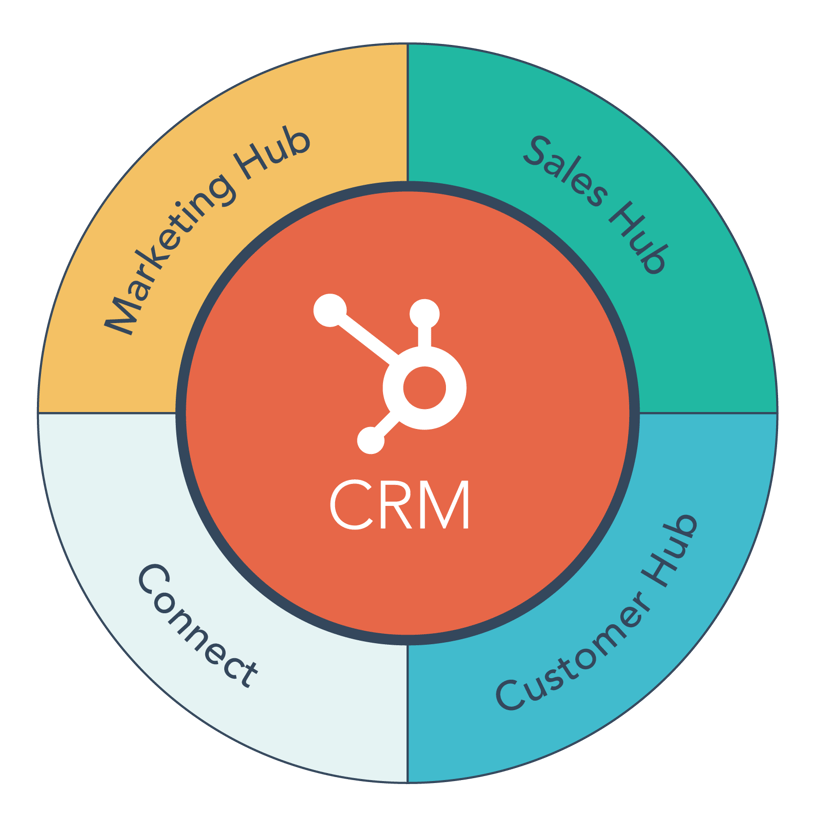
The Inbound Marketing Methodology: A Step-by-Step Guide
Inbound marketing is a customer-centric approach to marketing that attracts strangers and turns them into delighted customers.
The inbound method relies on creating quality content that pulls people toward your company and product, rather than pushing sales messages at them. By aligning the content you publish with your customer's interests, you naturally attract inbound traffic that you can then convert, close, and delight over time. An inbound marketing methodology is a customer-centric approach to attracting, engaging, and delighting customers. It is based on the idea of attracting potential customers to a business through relevant and helpful content, rather than using traditional methods of interruption marketing such as cold-calling or advertising.
Getting Started
Inbound marketing strategies are focused on attracting, engaging, and delighting customers through relevant and valuable content. These strategies include tactics such as content creation, search engine optimisation (SEO), and social media marketing.
Attract: The first step in the inbound marketing methodology is to attract potential customers to your business through relevant and valuable content. This helps to establish your business as a trusted advisor and encourages people to engage with you. Attract strangers and turn them into visitors with compelling content. This can be done through tactics such as search engine optimisation (SEO), content marketing, and social media marketing. To attract potential customers, businesses should create and publish content that provides value to their target audience. This may include blog articles, content offers, customer testimonials, and information about promotions or discounts. To ensure that this content is easily found by potential customers, businesses should also optimise it for SEO by targeting specific keywords and phrases related to their products or services. To attract potential customers to your website, you should use relevant content and targeted marketing efforts to reach the right audience at the right time. Use content strategy tools to build your authority and rank for important topics and publish content across social networks. Create ads to increase brand awareness among your target audience and analyse your efforts to identify areas for improvement.
Engage: The next step is to engage with potential customers by presenting insights and solutions that align with their pain points and goals. This makes them more likely to consider purchasing from your business. To engage with potential customers, businesses should focus on building long-term relationships by providing value and solution-selling rather than product-selling. This may include managing inbound sales calls and providing excellent customer service. To engage with potential customers, use tools such as live chat, email, and messaging apps to create lasting relationships with prospects. Use conversion tools like HubSpot forms and CTA s to capture information from website visitors, and use the customer relationship management (CRM) system to personalise the website experience and the entire buyer's journey through email and workflows . Target specific audiences with social content or ads to build brand loyalty.
Delight: The final step is to delight customers by providing helpful and supportive resources that empower them to find success with their purchases. This helps to build long-term relationships with customers and turn them into promoters of your brand. Delight customers, so they become promoters of your business by providing excellent customer service and support. This can help to build long-term relationships with customers and turn them into promoters of your brand. To delight customers, businesses should provide ongoing support and assistance to ensure that they are happy and satisfied with their purchases. This may include chatbots, surveys, social media listening , and responding to customer interactions in a helpful and supportive manner. Delighted customers are more likely to become brand advocates and promoters, which can help to drive more business. To delight customers, use email and marketing automation in conjunction with conversational tools to deliver the right information to the right person at the right time. Use the conversational inbox to align with your sales and service team and create contextual conversations with customers. Create shareable content in a variety of formats that your prospects prefer, and use a range of integrations to add additional tools and features to fit your business's unique needs.
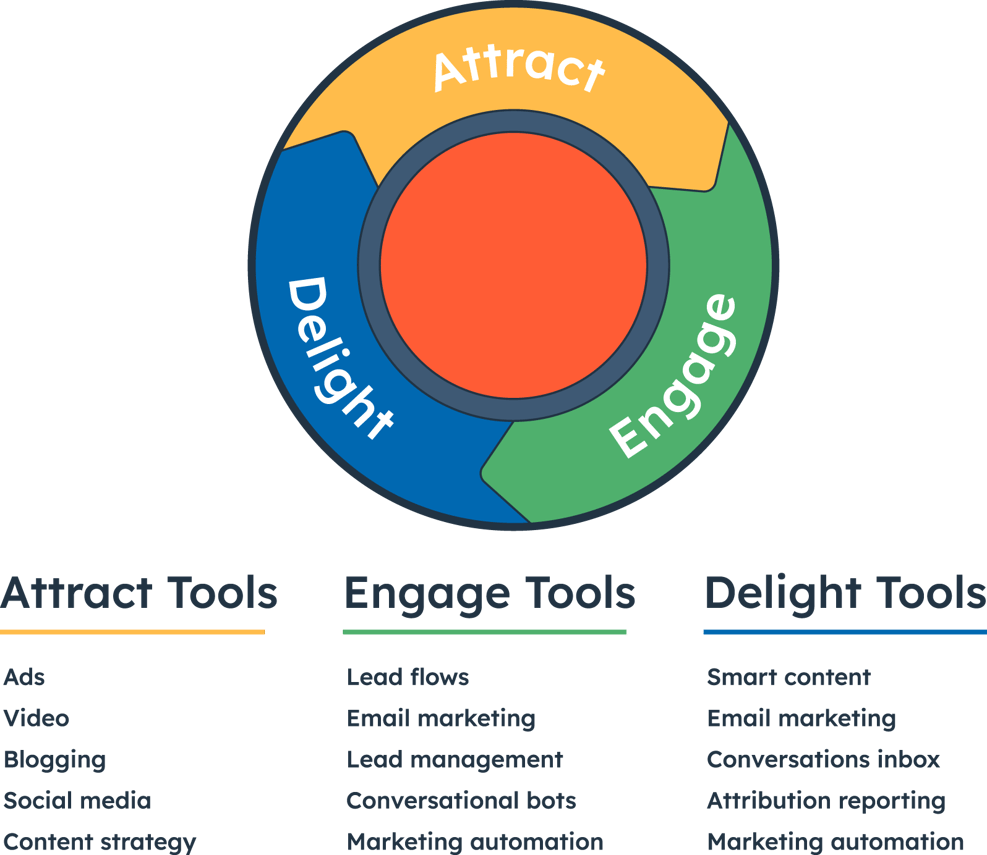
Inbound Tips
Define your target audience: It is important to clearly define your target audience so that you can create relevant and valuable content that will attract the right customers to your business.
Create valuable and relevant content: To attract potential customers, you should create content that is valuable and relevant to your target audience. This may include blog articles, ebooks, infographics, and videos.
Optimise your content for search engines: To ensure that your content is easily found by potential customers, you should optimise it for search engines by using targeted keywords and phrases.
Use social media to promote your content: Social media tools like HubSpot can be an effective way to promote your content and reach a wider audience.
Utilise email marketing: Email marketing can be a powerful tool for engaging with potential customers and building long-term relationships.
Measure and analyse your results: It is important to track and measure the effectiveness of your inbound marketing efforts so that you can make necessary adjustments and ensure that your strategy is successful.
Prioritise customer experience: Providing a positive customer experience is crucial for building trust and retaining customers. Make sure to focus on providing helpful and relevant information to customers throughout their journey.
Foster relationships with customers: Inbound marketing is all about building long-term relationships with customers. Make sure to engage with customers and provide ongoing support to keep them happy and satisfied.
Don't be afraid to try new things: Inbound marketing is an ever-evolving field, so don't be afraid to experiment with new tactics and technologies to see what works for your business.
- Use customer feedback to improve: Encourage customers to provide feedback and use this information to make improvements to your products, services, and overall customer experience.
Align your marketing and sales efforts: It is important to align your marketing and sales efforts to ensure that customers are receiving a consistent experience throughout the entire journey.
Use customer data to personalise the experience: Leverage customer data to personalise the experience and tailor your marketing efforts to individual customers.
Incorporate automation: Automation can help to streamline your inbound marketing efforts and free up time for more high-level tasks.
Don't neglect the power of word-of-mouth: Word-of-mouth marketing can be incredibly powerful, so make sure to delight your customers and encourage them to spread the word about your business.
Continuously refine and improve your strategy: Inbound marketing is a continuous process, so make sure to regularly review and refine your strategy to ensure that it is effective and aligned with your business goals.
Inbound Mistakes to Avoid
Not defining your target audience: One of the biggest mistakes businesses make with inbound marketing is not clearly defining their target audience. Without a clear understanding of who you are trying to reach, it is difficult to create relevant and valuable content that will attract the right customers to your business.
Not creating valuable content: Another common mistake is not putting enough effort into creating valuable and relevant content. It is important to provide value to your audience through your content, rather than just promoting your products or services.
Failing to optimise for search engines: To ensure that your content is easily found by potential customers, it is important to optimise it for search engines by using targeted keywords and phrases. Failing to do so can make it more difficult for people to find your content.
Not promoting your content effectively: Simply creating content is not enough - you also need to make sure that it is being promoted effectively. Utilise social media, email marketing, and other tactics to get your content in front of the right people.
Not measuring and analysing your results: It is important to track and measure the effectiveness of your inbound marketing efforts so that you can make necessary adjustments and ensure that your strategy is successful. Failing to do so can make it difficult to determine what is working and what needs to be improved.
Neglecting the customer experience: Providing a positive customer experience is crucial for building trust and retaining customers. Make sure to focus on providing helpful and relevant information to customers throughout their journey.
Failing to align marketing and sales efforts: Inbound marketing is a collaborative effort, and it is important to align your marketing and sales efforts to ensure that customers are receiving a consistent experience throughout the entire journey. Without alignment, there may be confusion or inconsistency in messaging, which can lead to lost opportunities.
Not using customer data to personalise the experience: Leveraging customer data to personalise the experience and tailor your marketing efforts to individual customers can be incredibly effective. Failing to do so can lead to a generic and impersonal experience for customers.
Not utilising automation: Automation can help to streamline your inbound marketing efforts and free up time for more high-level tasks. Neglecting to use automation can lead to a more time-consuming and less efficient marketing process.
Underestimating the power of word-of-mouth: Word-of-mouth marketing can be incredibly powerful, so make sure to delight your customers and encourage them to spread the word about your business. Ignoring the potential of word-of-mouth marketing can lead to missed opportunities.
Failing to continuously refine and improve your strategy: Inbound marketing is a continuous process, and it is important to regularly review and refine your strategy to ensure that it is effective and aligned with your business goals. Failing to do so can lead to stagnation and a lack of progress in your marketing efforts.
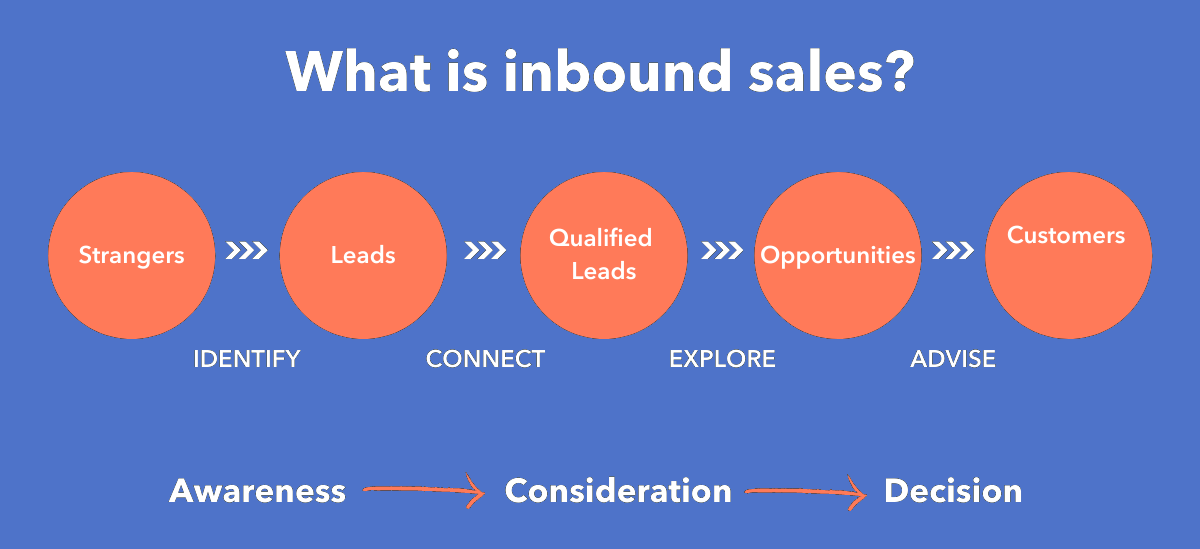
What is Inbound Sales?
Inbound sales is a customer-centric approach to sales that focuses on attracting potential customers to a business through relevant and valuable content, rather than using traditional methods of interruption sales such as cold-calling or traditional advertising. It is a process that involves attracting strangers to a website, engaging them with personalised experiences, and then converting them into customers with effective calls to action. Inbound sales is a powerful tool for growing a business and building long-term relationships with customers.
What is Inbound Services?
Inbound services refer to the support and assistance provided by a business to its customers, with the goal of delighting and retaining them. Inbound services can include a wide range of activities, such as customer service, technical support, and product training. The focus of inbound services is on proactively helping and supporting customers, rather than simply reacting to their needs or complaints. Inbound services can help to build trust and loyalty among customers, and can be an important part of a company's overall inbound marketing strategy.
What is a Flywheel?
The flywheel is a visual representation of the inbound methodology, which is a customer-centric approach to attracting, engaging, and delighting customers. It is based on the idea that if you help people, they will ultimately do business with you.
In the context of inbound, the flywheel represents the entire customer journey, from the moment a potential customer is attracted to your business through relevant and valuable content, to the point where they become a delighted customer and advocate for your brand. The flywheel is powered by the efforts of your marketing, sales, and service teams, who work together to attract, engage, and delight customers at each stage of the journey.
The flywheel model emphasizes the importance of building long-term relationships with customers and focusing on providing value at every touchpoint. It also highlights the idea that it is the collective efforts of all teams within a business that drive success, rather than any single department or individual.
How does a flywheel differ from a funnel?
A flywheel and a funnel are two different visual models that are used to represent different aspects of the customer journey.
A funnel represents the steps that a potential customer goes through as they move closer to making a purchase. It typically consists of multiple stages, such as awareness, consideration, and decision, and it is designed to narrow down the number of potential customers as they progress through each stage. The funnel is often used to represent the marketing and sales process, and it is focused on converting leads into customers.
A flywheel, on the other hand, represents the entire customer journey, from the moment a potential customer is attracted to your business through relevant and valuable content, to the point where they become a delighted customer and advocate for your brand. It is powered by the efforts of your marketing, sales, and service teams, who work together to attract, engage, and delight customers at each stage of the journey. The flywheel model emphasizes the importance of building long-term relationships with customers and focusing on providing value at every touchpoint.
So, while the funnel is primarily focused on the marketing and sales process and converting leads into customers, the flywheel represents the entire customer journey and the collective efforts of all teams within a business to attract, engage, and delight customers.
Where do Revenue Operations fit into Inbound?
Revenue operations, also known as RevOps, is the alignment and optimisation of a company's sales, marketing, and customer success functions. It is focused on driving revenue growth and improving efficiency across these departments. Revenue operations, or RevOps, play a crucial role in supporting and aligning the efforts of the marketing, sales, and service teams in an inbound strategy. It helps to ensure that all teams are working towards a common goal and that the customer experience is consistent throughout the entire journey. By aligning and optimising the efforts of marketing, sales, and customer success, revenue operations can help a business to attract, engage, and delight customers more effectively and drive revenue growth
In the context of inbound, revenue operations play a crucial role in supporting and aligning the efforts of the marketing, sales, and service teams. This includes coordinating the planning and execution of inbound campaigns, analysing data and metrics to inform decision-making, and ensuring that all teams have the tools and resources they need to be successful.
Some final points on Inbound
Some other important aspects of inbound marketing that we have not yet covered include:
Lead generation: Inbound marketing is focused on generating leads, or potential customers who have expressed interest in your business. Lead generation techniques include creating valuable content offers such as eBooks, webinars, and whitepapers, and using forms and calls-to-action to capture contact information from website visitors.
Lead nurturing: Once you have generated leads, it is important to nurture them and guide them through the buyer's journey until they are ready to make a purchase. This can involve sending targeted emails, creating personalised landing pages , and using workflows to automate the lead nurturing process.
Measurement and analysis: Inbound marketing is data-driven, and it is important to track and analyse metrics such as website traffic, leads generated, and customer conversions in order to continually improve your strategy and ROI. Tools such as Google Analytics and a marketing automation platform can help you to track and analyse key metrics.
Marketing automation: Marketing automation refers to the use of software to automate marketing tasks and processes. In the context of inbound, marketing automation can be used to streamline lead generation, lead nurturing, and other repetitive tasks, freeing up time for more high-level strategy and planning.
- Customer service and support: Providing excellent customer service and support is an important part of inbound marketing and can help to delight and retain customers. This can include responding to customer inquiries and complaints through channels such as email, social media, and phone, as well as providing product training and support.
- Personalisation: Personalising the customer experience is a key aspect of inbound marketing. This can involve using customer data to create personalised content, emails, and landing pages, as well as using tools such as chatbots and smart content to provide a personalised experience on your website.
Collaboration: Inbound marketing is a team effort and requires collaboration among the marketing, sales, and service teams. It is important to establish clear communication and roles and to work together to achieve common goals.
Content creation: Creating valuable and relevant content is a crucial part of inbound marketing. This can include blog posts, eBooks, whitepapers, webinars, and more. It is important to create a variety of content types that will appeal to your target audience and to regularly publish new content in order to attract and engage visitors.
SEO: Optimising your website and content for search engines is an important part of inbound marketing. This includes using targeted keywords, creating quality backlinks, and ensuring that your website is mobile-friendly and has a fast loading speed.
Integrated marketing: Inbound marketing is most effective when it is integrated with other marketing channels and tactics, such as social media, email marketing, and content marketing. Integrating inbound with other marketing efforts can help to amplify your message and reach a wider audience.
In this blog post, we discussed the basics of inbound marketing and how it can help a business grow. We defined inbound marketing as a methodology based on attracting customers by providing them with valuable content and personalised experiences. We also discussed the inbound methodology, which involves attracting strangers to a website, engaging them with personalised experiences, and converting them into customers with effective calls to action. We explained that inbound marketing is powered by the efforts of a business's marketing, sales, and service teams, and is focused on building long-term relationships with customers. Finally, we talked about revenue operations, or RevOps, and how it supports and aligns the efforts of the marketing, sales, and service teams in an inbound strategy.
Inbound marketing is a powerful tool for growing your business. By following the steps outlined above, you can attract strangers, engage them with personalised experiences, convert them into leads, and delight them so they become promoters of your business.
If you need help getting started with inbound marketing, contact us today. Our team of experts can help you attract visitors, engage them with personalised experiences, and convert them into customers.
Similar posts
The benefits of hubspot’s analytics tools.
HubSpot Analytics is a data-driven marketing and sales platform that provides users with powerful marketing, sales, and service reporting.
How to do ABM (Account-Based Marketing) with HubSpot
Using HubSpot Account-based marketing to combine marketing & sales efforts and maximise results.
Content Marketing - Using HubSpot to Improve Your Authority
You can use HubSpot for content marketing by taking advantage of the platform's vast array of tools and features to manage, optimise and report on.
Get notified on new marketing insights
Be the first to know about new B2B SaaS Marketing insights to build or refine your marketing function with the tools and knowledge of today’s industry.
Why Your Customer Journey Matters In Inbound Marketing
Customer Journey Mapping is used in marketing and customer service to identify how a person navigates the process of moving from being a complete stranger to becoming a loyal customer. It helps organisations look at all the important touchpoints in that journey that can help or hinder progress towards the end goal.

As an inbound marketing agency we focus on communication with the primary goal of generating leads . We also look at keeping customers once we have converted them. The inbound journey focuses on attracting attention and moving those people through to making an enquiry, using your website as the main asset.
Understand Each Customer Journey
While most journeys are loosely based on the traditional AIDA model (Attention, Interest, Desire, Action), each business will have its own variation that they have to understand in depth.
Type of Decision

Depending on the product or service involved, the length of the decision making process can be very different. If it is a simple decision, like buying a sandwich, then it's all very quick - you might briefly research the local sandwich shops, pick one, walk down the road, and spend a few seconds choosing your filling. The whole process takes less than half an hour.
However, if you are choosing a new IT supplier, you will figure out what you actually need, research the options, look at the different suppliers, have meetings, get references, negotiate prices and then, finally choose the most suitable company. The whole process can take months.
Buyer Personas
As with all marketing, the first step is to understand your potential customers, and develop a clear picture of how they make decisions. You are likely to have more than one ideal customer, so make sure you identify your priority personas and look at their journeys first. By understanding their challenges and aspirations you can provide information that hits the nail on the head and encourages them to engage with you.
Content for Each Stage
As part of your inbound marketing efforts you will be creating lots and lots of useful, helpful content. The key to making it work for you, is to make sure that for each persona, you produce content for each stage of their journey.
- The first stage is awareness - you are attracting people who haven't heard of you before, so you need to grab their attention by talking about the immediate problem they are experiencing.
- Next you move them to actually being interested in your products or services, considering what you offer as a potential solution to their problem. Your job here is to offer lots of really useful information so that they can start to consider the best approach.
- If they take that step you really want to entice them to get in touch with you so that you can convince them that you are the right person for the job with detailed information about what's it's like to use your services.
- If they decide to buy from you, it doesn't stop there. You want to keep in touch so that they remember to come back again, and recommend you to their friends and colleagues.
Map out the specific journeys that your customers take and make sure that you have the right content available for each step.

Move at Their Pace
By having content available on your website for each stage of the journey, you never need to be pushy. You let visitors move along, step by step, at their own speed. If they are just browsing then that's fine but make sure you show them what's next so that they can choose to move forward if they are ready. By having clear calls to action on each page of your website it is easy for visitors to move closer to becoming customers.
If they are not yet ready to move along, you want the information you have provided to be sufficiently memorable to encourage them to come back to you later. If you have content that is valuable enough that visitors will give you their contact details in order to obtain it, you have the opportunity to keep in touch and nurture those leads until they are ready to take the next step. Assuming you have provided them with something helpful you stand a good chance of being their preferred supplier when it comes to making the next move.

Inbound tips in your inbox
To get more great inbound marketing tips sign up to our blog and follow us on Twitter or Facebook.

The Multi-Disciplinary Marketing Strategy
Marketing is constantly evolving and marketing departments need to be aware of all new...
Getting Great Search Rankings Is A Slog, It Just Is.
In this video Red Evolution's Dave Robinson talks about getting to the top of the search engine...
How Mercedes Are Failing and How Not To Follow Suit
I'm a fan of Mercedes-Benz cars but my experience with them as a company over the last few months...
Call us, email us or just click here to book a meeting
- 01224 443 551
- [email protected]
- 0208 004 7428
- [email protected]
- 0131 378 5777
- [email protected]
The Complete Guide to B2B Customer Journey Mapping

Modern B2B marketing is customer-focused. While that statement might not come as much of a surprise, implementing it can prove to be difficult. It requires both a close understanding of, and commitment to, customer experience strategy.
Put simply, a strong customer experience strategy in the B2B realm means ensuring that every touchpoint along the buyer's journey results in positive audience experiences. With each touchpoint, brand credibility rises, value clarifies, and the potential customer becomes more likely to convert.

Especially in B2B industries, where 6+ touchpoints are necessary to generate a qualified sales lead, taking charge of each touchpoint as part of the larger audience experience is vital. It requires shifting your POV from the messages you want to push to the points where your audience encounters your business, brand, and product.
A well-planned customer experience strategy can significantly increase not just your lead generation efforts, but also your customer and revenue generation. It allows your business to set more sustainable and realistic marketing goals, changing the focus to the customer in a way that allows every organizational level to realize the need for a customer-centric culture shift. One study found that 87% of U.S. and U.K. business executives view it as a top growth engine.

Take the rapid rise of the ride-sharing industry as an example. For decades, taxi companies were entrenched in a self-contained industry as the only option offering on-demand rides to consumers not able or willing to wait for more scheduled forms of public transportation. But within the last decade, ride-sharing alternatives like Uber and Lyft were able to completely disrupt this industry with a more customer-driven business model that aimed to focus on audience experience above all.
Of course, following the example of Uber and Lyft is easier said than done. The same study finding UX strategy to be a top growth engine also discovered that only 1 in 3 business executives felt fully prepared to address and implement it. That's where customer journey mapping enters the equation.

What is Customer Journey Mapping?
As the name suggests, a B2B customer journey map is a visual collection of the typical road your target audience takes on their way to becoming a customer. Typically presented in a linear fashion, it outlines not just their current relationship with your brand and business but also their needs, perceptions, and feelings at each stage of the journey.
Once completed, this visual tool can go a long way toward providing context and reasoning behind individual sales initiatives. It also allows organizational leadership and everyone else connected to your marketing efforts to recognize just how important a shift to a customer-centric promotional strategy truly is. The resulting breakdown of organizational silos can lead to a more collaborative, cross-functional marketing effort that ultimately improves both customer acquisition and retention.
Most customer journey maps are divided into 5 distinct stages, aligning closely with the traditional B2B sales funnel:

- Awareness – in which audience members first discover the brand through initial pain point recognition and research into potential solutions. Touchpoints here tend to be about making a positive first brand and product impression.
- Consideration – in which audience members are beginning to compare potential solutions to their problems or pain points. Touchpoints at this stage succeed when creating strong differentiation and social proof, like case studies that showcase product success.
- Decision – in which audience members make their buying decision either individually or as part of a buying group . Successful touchpoints at this stage reinforce core product benefits and offer glimpses into the product through demos or trials.
- Loyalty – in which new customers first experience the product and form impressions that will inform their decision to remain customers long-term. Successful touchpoints at this stage foster trust, improve product onboarding, and solicit customer feedback in order to build long-term engagement.
- Advocacy – in which loyal customers turn into brand and product advocates that spread the word about their positive experiences to peers and colleagues. Successful touchpoints at this stage encourage testimonials and product reviews or mine repeat customers for potential case studies.
Companies that take an active role in mapping their typical customer journey can build their entire marketing and sales strategy around these stages. With a close understanding of the audience's mindset and needs at each stage, they can design touchpoints specifically designed to create a positive customer experience and move prospects through the sales funnel.
B2B Customer Journey vs. B2C Customer Journey: Similarities and Differences
Regardless of industry, every potential customer undergoes a journey from awareness to purchase and beyond. Just what that journey looks like, though, can differ significantly.
Most importantly, B2B customer journeys tend to be more complex, due to longer sales cycles and more stakeholders involved in the decision-making process. Individual pain points turn into organizational needs, with potential buyers representing a goal that extends beyond themselves. Understanding just who you are talking to, and what role that audience member plays in the purchasing process, can influence your messaging, content, and choice of channel.
The more complex journey also means accounting for individual stages that are more nuanced and require more specific touchpoints specifically designed to account for buyer needs:
- At the awareness stage, buyers may interact with brands through high-level web pages, third-party review and comparison sites like G2 and Capterra , or industry groups on social media.
- At the information searching stage, buyers may seek more specific product information on deeper-level web pages, through case studies, or via live chat support.
- At the supplier shortlisting stage, buyers look to comparative content that specifically pits potential products against each other, delivered via long-form channels like blog posts or webinars.
- At the quotes, pricing, and negotiation stage, buyers often seek personal contact with suppliers that go beyond the standard pricing tiers listed on the supplier's web page.
- At the ordering stage, buyers look for specificity in terms of ordering details, quantity, shipping estimates, and more. Email and one-to-one communications are the most common touchpoints.
- At the delivery stage, buyers receive the order as a touchpoint on its own, with onboarding and other opportunities to ensure its successful use.
- At the post-sales support stage, buyers expect companies to proactively reach out to ensure long-term success, both via standardized surveys and one-to-one communication.
- At the finance and invoicing stage, buyers expect clarity in payments both via physical touchpoints like direct mail and electronic alternatives.
Each stage in the B2B journey, in other words, is tailored towards the more complex sales process. Note that touchpoints follow buyer needs and expectations, not vice versa - which is what makes building a successful B2B customer journey map such an important step in creating the larger CX strategy.

A Comprehensive Guide to Creating a Successful B2B Customer Journey Map
So far, we've covered in-depth the ins and outs of a finished customer journey map. Of course, a generalized version with the potential to apply to all B2B industries and niches only has limited appeal to a business looking to map the journey of their own target audience on the way to becoming customers and brand loyalists.
Creating that unique, customized journey map requires 6 steps that all work together to build the finished product. Let's dig deeper into the nuances for each of these steps to create your own B2B customer journey map.
Step 1: Define Your Buyer Personas
Successful journey mapping is only possible with an in-depth understanding of your target audience that reaches beyond demographics and into the interests, behaviors, and pain points of your audience. Through buyer personas, you can create a clear picture of the audience segments that you will map in this process.
You might be familiar with buyer personas , which are snapshot profiles of hypothetical, idealized customers. They take your audience research and turn it into unique segments that outline the segment's position in the company, role in the buying process, pain points, preferred channels, and more.
Look to create a buyer persona for each core member of the typical buying group within your industry. Then, analyze their involvement in each stage of the customer journey. Depending on the differences, you might need a uniquely mapped customer journey for each persona.
Step 2: Break Down the Stages of Your Customer Journey
Using the above breakdown of general stages as a guide, analyze the typical buying process for your own product or service. You may or may not need to include each stage, or you may need to add a new stage unique to your industry.
For example, SaaS providers often define a distinct onboarding step separate from the purchase decision that includes tutorials or guided training as soon as a software purchase is complete. Similarly, manufacturing clients may include a distinct 'site visit' stage in which a potential supplier's factory is examined by internal experts before the purchase of any goods is confirmed.
Generally speaking, it helps to start simple and follow a template. But if your audience tends to always follow a step that isn't already outlined, add it to increase the accuracy of your journey map.
Step 3: Evaluate the Buying Process and Pain Points at Each Stage
For each stage you have defined, put yourself into your audience's shoes. What are they looking for at this stage? What problems are they trying to solve, and where do they look to solve those problems?
You might have solid, educated guesses at the answers to these questions. However, it's always best to rely on research to get more specific and accurate, truly reflecting your customer experience. Many user experience experts use a "jobs to be done" framework to outline needs and actions taken for each stage.
Step 4: List and Evaluate Existing Customer Touchpoints With Your Brand
At each stage, your marketing and sales messaging is likely already reaching your audience. Now, it's time to map those existing touchpoints to the stage in question, allowing you to see exactly where your blog posts, social media efforts, paid campaigns, sales calls, etc. are hitting your audience.
This step especially benefits from collaboration. Ask members of your sales and marketing team for any touchpoints they can think of, and where those touchpoints may fit. Being comprehensive here is a benefit, not a drawback. A content gap analysis , for example, can go a long way into building that content roadmap and mapping it to the customer journey.
Once all touchpoints have been outlined, it's time to evaluate them. You might find, for example, that many of your existing marketing efforts focus on the awareness stage, allowing you to shift some to the decision stage. Similarly, you can ensure that the messaging in each touchpoint aligns with your audience's needs and pain points at the stage towards which it is targeted.

Step 5: Create a Visual Customer Journey Map
So far, our efforts have focused largely on collecting data points. Turn those data points into a visual system for evaluation and future guidance using a visual customer journey map template.
Here, you can draw on plenty of software and app providers looking to sell their platforms. Sketch, Adobe XD, Smaply, and Miro are just some of the countless options available for marketers . Many of them offer a free trial; compare them to each other before choosing the one that works best for your needs.
Step 6: Regularly Evaluate Your Journey Map Against Real-World Data and Trends
The final step in customer journey mapping begins when the map is complete. Customer experience strategy is an ongoing process, and much of it depends on making sure that your map remains both accurate and optimized.
At a regular interval of at least every 6 months, review the journey map using a few simple steps:
- Walk through each of the steps in this guide again to ensure the buyer personas, touchpoints, audience needs, etc. are still accurate for your audience.
- Review any current audience research to see how the insights gained from it may change your map moving forward.
- Review the analytics and KPIs for each core touchpoint in each stage to determine whether it is performing as expected, or needs improvements down the road.
Once again, collaboration is key in this step. Everyone using the customer journey map, from marketing to sales and even senior leadership, should be involved in making sure that it remains accurate and actionable over time.
Leveraging Your Journey Map for an Omnichannel Customer Experience
Mapping your journey-spanning customer touchpoints also allows you to take one step further towards omnichannel marketing, in which the customer experience is optimized regardless of the channels through which the touchpoints occur. As the logical next step beyond multi-channel marketing, omnichannel approaches leverage all relevant channels in ways that are both interchangeable and build on each other for a better, more comprehensive experience.
In this approach customer data is stored across channels to be leveraged at a moment's notice. An eCommerce brand, for instance, is able to personalize the website experience while at the same time allowing purchases through its online store, mobile app, or social media store. At its best, omnichannel eCommerce experiences even allow customers to begin their purchasing journey on one channel while completing it on another.
Research from Google shows that 98% of American internet users switch between devices in the same day, even as they interact with the same brand. A comprehensive customer journey map allows you to optimize your channels to account for those switches, creating a positive experience that both accounts for your audience's preferred channels and allows them to engage with you and continue their buying journey with you regardless of channel.
Uncovering Sustainable Benefits of Successful B2B Customer Journey Mapping
Beyond the potential to create a true omnichannel marketing strategy, customer journey mapping also comes with a few other advantages that are important to consider as you look to implement the process.
Most importantly, it shifts the company's focus to the consumer, turning customer acquisition and retention into an organization-wide, cross-functional effort in which everyone is involved. That shift is essential to ensuring that the customer experience is at the center of all marketing, sales, and promotional efforts.
With that focus in mind, some of the most critical benefits of journey mapping include:
- Setting more realistic and sustainable goals for each journey stage, along with the ability to measure those goals in the long-term.
- A visual tool that allows internal stakeholders to better understand the context and reasoning behind individual marketing and sales deliverables.
- A change in perspective to customer-centric marketing and sales efforts that is easier for all internal stakeholders to buy into.
- More streamlined channel and messaging strategies that have a higher potential of successfully addressing audience needs and pain points.
- Improved inbound marketing efforts that focus resources only on content and lead magnets most likely to convert leads.
- The ability to define existing gaps in the customer experience that can lead to business adjustments to better focus marketing and sales efforts.
- A breakdown of organizational silos that can instead focus on internal collaboration with the goal of enhancing the customer experience.
- Increased retention rates , thanks to the ability to attract more loyal customers and a strategic consideration of post-purchase messaging.
Put differently, building a B2B customer journey map has both tangible and intangible, and both strategic and tactical benefits for your organization. Its implementation can go a long way towards building more sustainable, successful, and efficient marketing campaigns.
From Journey Mapping to Successful CX Strategy
Above all, customer journey mapping allows you to take a step back. Especially for organizations with long-established marketing practices, it forces experts to consider all of their efforts from a customer-centric perspective, allowing for a comprehensive review and evaluation of all existing tactics as well as ongoing optimization of future campaigns and strategic planning. On a broader scale, it requires a culture shift to considering customer needs and preferences first.
This ability to build more strategic and differentiated marketing efforts, of course, comes with a price. In this case, that price is the need to re-think existing efforts, instead leveraging comprehensive audience research and insights to change the point of view. Getting started requires both buy-in to this shift, and the research necessary to build personas, journey stages, and pain points.
Fortunately, you don't have to do it on your own. Steel Croissant is ready to help you build a customer journey map that can ultimately shape your entire marketing efforts. Ready to get started? Contact us today to start the conversation.
This post needs more time in the oven.
Sign up to be notified with it is done.
Frequently Asked Questions
B2B Customer Journey Mapping is a strategic process of visualizing and understanding the end-to-end experience a business customer has with a B2B brand. It involves tracking every touchpoint, interaction, and decision-making stage throughout the customer lifecycle. This comprehensive mapping is crucial for businesses as it provides insights into customer behavior, pain points, and opportunities for engagement. By understanding the complete journey, B2B companies can optimize their strategies to meet customer expectations at every stage and enhance overall satisfaction.
To create a B2B Customer Journey Map, companies can start by identifying customer personas, mapping out the various stages of the buyer's journey, and pinpointing key touchpoints and interactions. Utilizing data from customer feedback, analytics, and sales teams, businesses can gain a deeper understanding of customer needs and preferences at each stage. Collaborative workshops involving cross-functional teams can help compile insights and create a visual representation of the customer journey that aligns with the company's goals and objectives.
A comprehensive B2B Customer Journey Map includes key components such as buyer personas, touchpoints, customer emotions, pain points, and opportunities for engagement. It should cover the entire customer lifecycle, from the awareness stage through the purchase decision to post-purchase interactions. By integrating these components, businesses can develop a holistic view of the customer experience, allowing for targeted improvements and strategies to enhance satisfaction and loyalty.
B2B companies can use customer journey maps to improve CX by identifying pain points, optimizing touchpoints, and aligning internal processes with customer needs. These maps serve as valuable tools for understanding the customer's perspective and uncovering areas of improvement. By addressing pain points and enhancing positive interactions, businesses can create a more seamless and satisfying customer experience, ultimately leading to increased customer loyalty and advocacy.
Personalization is integral to B2B Customer Journey Mapping as it involves tailoring the experience to the unique needs and preferences of individual customers. By incorporating personalized content, communication, and offers at various touchpoints, businesses can create a more engaging and relevant journey. Personalization fosters a deeper connection with customers, increases the likelihood of successful interactions, and contributes to a positive perception of the brand throughout the B2B customer journey.

Enjoying our blog? Well, we also curate a rundown of the hottest B2B marketing news every week. Subscribe to have our newsletter delivered directly to your inbox!
.png)
April 2024 Social Media Holidays for B2B Brands + ChatGPT Prompts
March 29, 2024
.png)
Elevating Web Security: Mastering TLS Protocols, SSL Certificates, and Beyond
March 27, 2024
.png)
What Can My Brand Do for Women’s History Month?
March 15, 2024
Inbound Marketing Funnel Strategies: Optimizing Your Customer Journey
Inbound marketing funnels are a strategic approach to guide potential customers through the journey of becoming aware of a company or product to taking the desired action such as making a purchase or subscribing. This methodology focuses on creating valuable content and tailored experiences aimed at attracting individuals organically, rather than pursuing them through traditional outbound tactics. As the digital landscape evolves, this consumer-centric funnel adapts to incorporate new techniques for engaging audiences effectively.
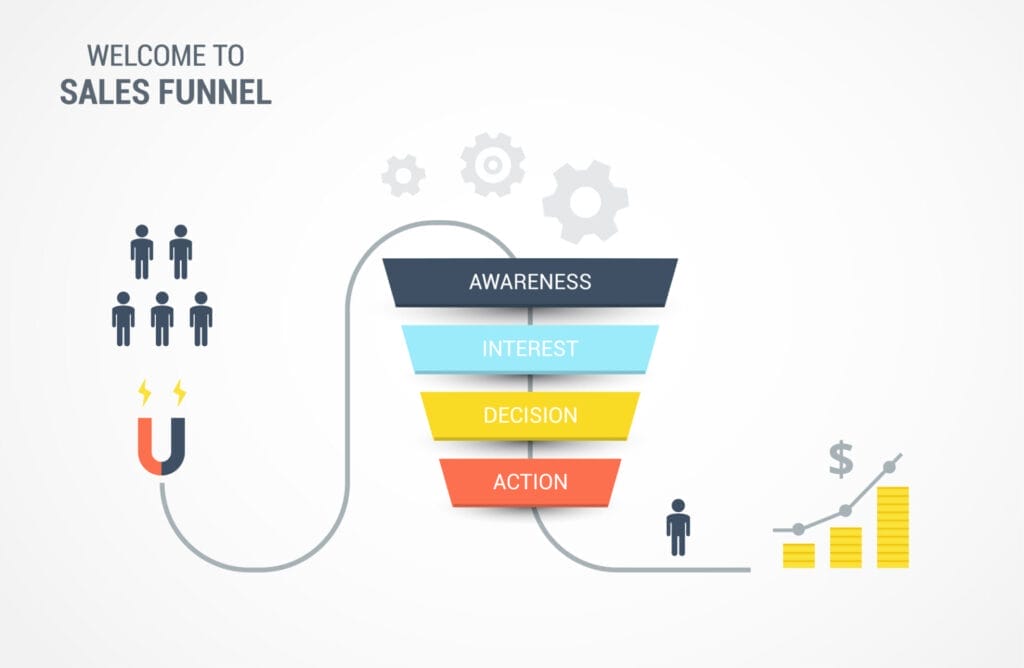
The funnel begins by drawing the right visitors to a company’s digital assets, then efficiently converting these visitors into leads by understanding their needs and offering solutions. The process involves nurturing these leads with relevant information and support until they are ready to make a decision. Once a purchase is completed, the relationship is not viewed as transactional; efforts are made to ensure customers are delighted and retained, forming the basis for advocacy and sustained growth. Ultimately, leveraging technology and detailed analysis plays a crucial role in continuously refining the inbound marketing strategy.
Key Takeaways
- Inbound marketing funnels focus on attracting and nurturing leads through targeted content.
- A successful inbound strategy involves understanding consumer needs and optimizing interactions.
- Technology and analytics are essential for refining inbound efforts and driving business growth.
Understanding Inbound Marketing
Inbound marketing is a strategic approach focused on attracting customers through relevant and helpful content, adding value at every stage in the customer’s buying journey. With the digital landscape shifting how consumers interact with businesses, inbound marketing channels have become essential in a company’s strategy.
Defining Inbound Marketing
Inbound marketing is the method by which businesses draw customers in by creating valuable content tailored to them. Unlike outbound marketing, which interrupts the audience with content they don’t always want, inbound marketing creates the types of connections and solves problems that potential customers are actively searching for on search engines and via social media .
Evolution in the Digital Age
The digital age has transformed how consumers obtain information and make commercial transactions. Search engines and social media platforms have provided unprecedented access to content, making SEO practices and shareable content critical components of any inbound marketing strategy . Companies must adapt to these changes by crafting high-quality content that leverages SEO to improve visibility and engagement.
Inbound vs. Traditional Marketing
Inbound marketing differs from traditional marketing in that it involves a pull rather than a push strategy. Traditional marketing relies on broad-reaching tactics, while inbound targets individuals through inbound marketing channels like blogs, search engines, and social media. Inbound marketing engages audiences with content that they find organically when seeking information or solutions, establishing a relationship premised on value and trust.
Developing an Inbound Marketing Strategy
When creating an inbound marketing strategy, it’s imperative to understand your target audience, set measurable goals, and craft valuable content tailored to those you seek to engage. A well-structured strategy lays the groundwork for attracting, engaging, and delighting potential customers throughout their buyer’s journey.
Buyer Personas and Target Audience
Defining buyer personas is crucial as they represent ideal customers based on real data and educated speculation about customer demographics, behavior patterns, motivations, and goals. They provide a detailed portrait of the target audience and help tailor the strategy to meet their specific needs and solve their unique problems. Creating buyer personas involves gathering insights from existing customer data, market research, and direct feedback.
Goals and ROI Measurement
Clear, achievable goals are the backbone of an effective inbound marketing strategy. Goals should align with broader business objectives and might include increasing website traffic, generating leads, or boosting customer engagement. To measure return on investment (ROI), they must identify key performance indicators (KPIs) such as lead conversion rates, website traffic growth, or customer acquisition cost. Tracking these metrics over time allows for a robust evaluation of the strategy’s effectiveness.
Content Strategy Formation
A content strategy forms the essence of inbound marketing, requiring consistent production of valuable content that addresses the needs and interests of the target audience. Content marketing elements include blog posts, social media updates, ebooks, and webinars, curated to provide solutions and establish the brand as a thought leader. The development of a content calendar ensures a steady stream of content, while SEO tactics enhance visibility and draw organic traffic.
To effectively engage an audience, the content should be personalized and relevant, guiding potential customers through each stage of the funnel, from awareness to consideration and finally to decision-making. High-quality content fosters trust and encourages conversions, turning visitors into leads and leads into customers. Through informed content strategy formation , brands position themselves to successfully attract and retain customers in a competitive digital landscape.
Attracting Your Audience
To effectively attract an audience, it is imperative to focus on creating valuable content, enhancing search engine visibility, and engaging users on social media platforms.
Creating Quality Content
They begin by crafting compelling content that resonates with their target audience. This may include blog posts , informational articles, video tutorials , or infographics that address specific needs or interests. By providing solutions or insights, companies establish credibility and draw in readers who are seeking to learn and solve their problems.
- Blog Posts: Regular blogging can position a brand as an industry thought leader and go-to resource.
- Video Tutorials: These serve as visual guides that can simplify complex topics and increase understanding.
- Infographics: They often distill information into an easy-to-digest format that is shareable and visually appealing.
Optimizing for Search Engines
The purpose of search engine optimization (SEO) is to increase traffic to a website by enhancing its visibility when potential customers search for relevant terms. They implement on-page SEO, such as keyword integration and meta descriptions, and off-page SEO, like backlinking from reputable sites.
- Keywords: Strategic placement of relevant keywords in content and headings.
- Backlinks: Quality backlinks from authoritative sites to improve domain authority.
Leveraging Social Media
They utilize social media platforms to promote content and engage with the audience. Platforms like Facebook, Twitter, LinkedIn, and Instagram allow them to share content, interact with followers, and participate in industry conversations, thus expanding their reach and drawing in more prospects.
- Regular Posts: Sharing content regularly keeps the audience engaged and informed.
- Community Interaction: Responding to comments and messages fosters community and encourages dialogue.
Converting Visitors into Leads
In the realm of inbound marketing, transforming visitors into leads is a crucial step that embodies the strategic placement of forms and the persuasive power of calls-to-action coupled with landing pages.
Effective Use of Forms
Forms serve as a pivotal point of interaction on a website, effectively bridging the gap between visitors and leads . A strategic form design solicits essential information without demanding too much at once, thus avoiding visitor fatigue. To boost lead generation , forms should be succinct and contextually placed within compelling content offers . For example, a visitor immersed in an article about gardening might be enticed to submit a form when offered a downloadable planting guide—this is a prime example of gated content that secures a lead in exchange for valuable information.
Calls-to-Action and Landing Pages
A call-to-action (CTA) is the catalyst urging a visitor to take the desired step. Effective CTAs are usually bold and clear, offering visitors straightforward directions on what to do next, such as “Download the Free Guide!” or “Get Your Free Quote Today!” When clicking a CTA, visitors are directed to a landing page , which is meticulously designed to continue the narrative presented by the CTA and complete the conversion process. An impactful landing page focuses on value proposition and encourages a visitor to fill out a form, turning them into a lead. The congruence between the CTA and the landing page content is crucial; it reassures visitors they’ve arrived at the right place to receive what was promised.
Nurturing Leads through the Funnel
Proper lead nurturing is critical for moving prospects through the inbound marketing funnel towards a sale. It involves consistent, targeted communication and strategic use of data to increase engagement and conversion rates.
Email Marketing
Email marketing serves as a powerful tool in lead nurturing, offering a direct line of communication with prospects. Organizations can send personalized newsletters and drip campaigns to educate and engage leads, responding to their interactions and guiding them down the funnel. Relevant content delivery is essential, ensuring each email adds value to the lead’s decision-making process.
Lead Scoring and CRM
A Customer Relationship Management (CRM) system is indispensable for lead nurturing . Through lead scoring , which assesses a prospect’s actions and engagement levels, a company can identify who is more likely to convert and prioritize follow-up. CRM integration aligns sales and marketing efforts by funneling critical lead information into targeted campaigns efficiently.
Marketing Automation
Marketing automation streamlines the nurturing process, allowing for the timely and relevant delivery of content to prospects. Automated workflows can trigger actions like sending a follow-up email when a lead downloads a resource, ensuring no opportunity for engagement is missed. This automation should align with overall lead generation strategies to facilitate a unified approach across all stages of the funnel .
Closing and Creating Customers
The closing phase in the inbound marketing funnel is critical, as it is where leads are converted into customers. This transformation hinges on strategic alignment between sales and marketing and the effective use of CRM systems to track and foster lead engagement.
Sales Alignment Strategies
Sales and marketing teams must operate in tandem to ensure a consistent message and a smooth transition for the lead through the sales funnel . CRM platforms play an integral role by providing a shared view of a lead’s activity and readiness to buy. They align marketing activities with sales objectives , enabling salespersons to tailor their closing strategies based on a lead’s individual journey.
- Data Sharing : Proactive sharing ensures that sales understand the lead’s interactions with marketing content.
- Lead Scoring : Assigning values to leads based on their activities helps to prioritize and tailor sales efforts.
Lead to Customer Conversion
Converting leads to customers requires a nuanced approach that acknowledges the unique concerns and needs of each lead. By the time leads reach the closing stage, they should be well-nourished with relevant information, making them ready for the final sales pitch.
- Personalized Communication : Salespeople should use data from the CRM to personalize conversations and address specific pain points.
- Promotions and Closing Offers : Timed discounts or special offers can incentivize leads on the cusp of making a decision.
Structured communication and a deep understanding of the leads’ prior interactions are indispensable for fine-tuning the sales approach and successfully closing the deal, ultimately creating loyal customers .
Delighting and Retaining Customers
After the purchase, a customer’s experience with a brand can turn them into a repeat buyer and even a brand advocate. This stage of the inbound marketing funnel focuses on post-sale activities that drive customer satisfaction and loyalty.
Post-Sale Customer Engagement
Customers should receive continued attention even after a sale is completed. Brands can engage clients post-sale by offering exclusive content, product usage guides, and tailored communications. Engaging customers keeps the brand at the forefront of their minds and encourages repeat business.
Customer Feedback and Improvement
Actively soliciting and responding to customer feedback demonstrates that a brand values its customers and is committed to improvement. Timely resolutions to issues and consideration of customer suggestions can transform average service into exceptional experiences, and regular opportunities for feedback can foster trust and credibility.
Building Long-Term Relationships
Lasting relationships are built on consistent and positive interactions. They contribute to customers becoming enthusiastic promoters who are inclined to leave glowing reviews and testimonials . Regular check-ins, personalized messages, and loyalty programs are strategies to maintain connections and demonstrate continued appreciation for their business.
Optimizing the Marketing Funnel
Optimizing the marketing funnel involves careful analysis, a responsive approach to shifting customer behaviors, and a commitment to continuous refinement. Effectiveness in these areas increases the likelihood of transforming prospects into paying customers.
Analyzing Funnel Performance
The optimization process begins with a thorough analysis of the funnel’s performance . It’s critical to identify at which stages prospects drop off and which touchpoints yield the highest conversion rates. For example, companies should evaluate metrics such as page views, click-through rates, and lead-to-customer conversion percentages. By mapping out the buyer’s journey , organizations can pinpoint areas of friction and create targeted strategies to enhance the purchasing journey .
Adapting to Customer Behavior
Successful marketing funnels are dynamic, evolving with the customer journey . It’s essential to adapt to customer behavior , which can shift due to external factors like market trends or internal changes in preferences. Continual A/B testing of landing pages, emails, and call-to-action buttons provides insight into what resonates with customers, which in turn informs the marketing strategy.
Continuous Improvement Process
The inbound marketing sales funnel isn’t static; it requires a continuous improvement process . Soliciting customer feedback can highlight gaps between the expected and actual customer experience. Companies should refine their content and strategies regularly to align with the ongoing evaluation of their target audience’s needs. This iterative process not only optimizes the funnel but also builds deeper relationships with customers over time.
Key Inbound Marketing Tactics
To effectively attract and convert leads, it’s imperative for marketers to employ a variety of inbound marketing tactics. Each of these methods is designed to engage potential customers at different stages of their buyer’s journey.
Content Offerings and Ebooks
Content offerings and ebooks serve as an instrumental part of any inbound marketing strategy. Ebooks, rich in quality content , can address specific topics in-depth, positioning a brand as a thought leader. By providing these valuable resources in exchange for contact details, companies can effectively generate leads.
Webinars and Podcasts
They are dynamic tools for delivering relevant content . Live webinars engage audiences with real-time interaction, while podcasts offer convenience, allowing listeners to tune in on their own schedule. Both formats are excellent for establishing a rapport with listeners and nurturing leads.
Case Studies and Testimonials
Case studies and testimonials lend credibility through real-world examples of a company’s success. They underscore the trustworthiness of a business and often showcase how products or services have resolved clients’ challenges.
Blogging and Written Content
Finally, blogging and other written content are the cornerstone of any inbound marketing strategy. Consistently publishing high-quality, relevant blog posts drives traffic and assists in SEO efforts, ultimately increasing visibility and establishing domain authority.
Leveraging Technology and Tools
Inbound marketing funnels are enhanced significantly by the strategic use of technology and tools. These solutions streamline processes, ensure efficiency, and enhance the overall effectiveness of each funnel stage.
CRM Integration
Integrating Customer Relationship Management (CRM) systems into the inbound marketing funnel allows businesses to manage and analyze customer interactions and data throughout the customer lifecycle efficiently. With CRM tools, companies can automate engagement, track leads through the funnel, and tailor marketing efforts to individual prospects’ behavior, increasing the likelihood of conversion.
SEO and SEMRush
Search Engine Optimization (SEO) is critical for driving organic traffic to content at the top of the inbound marketing funnel. Tools like SEMRush offer robust analytics that help marketers discern the most potent keywords and strategies that lead potential customers to their site. They also provide competitive analysis and optimize site health to maximize visibility in search engine results pages (SERPs).
Lead Generation Software
Lead generation software is essential for capturing the information of prospects interested in the content offered. These tools help segment leads based on their behaviors and demography to facilitate targeted marketing automation campaigns. Technology like this ensures that no potential customer is overlooked and increases the efficiency and personalization of follow-up communications.
Measuring Inbound Marketing Success
When assessing the effectiveness of an inbound marketing strategy, it’s critical to monitor specific metrics that reflect the performance of the various stages of the marketing funnel. By analyzing these metrics, businesses can determine the return on investment (ROI) and manage expenses more effectively.

Key Performance Indicators
Awareness : The top of the inbound marketing funnel is awareness. Important KPIs here include:
- Web Traffic : Number of visitors to your site.
- Page Views : Frequency with which certain pages are viewed.
- Social Shares : How often your content is shared on social media.
Interest and Consideration : As potential customers move down the funnel, they display interest and consideration. Track these KPIs:
- Lead Generation : Total number of new leads.
- Engagement Rate : Interaction with content, such as comments and likes.
- Click-Through Rate (CTR) : The percentage of people clicking a link in your content.
Decision and Intent : The narrow part of the funnel where leads consider making a purchase and showcase intent. Evaluate KPIs like:
- Conversion Rate : The ratio of visitors who take a desired action.
- Qualified Leads : Leads that meet certain criteria signaling a higher intent to buy.
ROI and Expense Tracking
ROI : Calculating the ROI involves comparing the gains from your inbound marketing efforts to the costs. It’s quantified as follows:
- ROI = ( \frac{\text{Gross Profit} – \text{Marketing Expenses}}{\text{Marketing Expenses}} ) × 100
Expenses : Keep a rigorous track of all inbound marketing costs, including:
- Content Creation Costs : Production of blogs, videos, infographics, etc.
- Software Subscriptions : Tools for automation, CRM, analytics, etc.
- Advertising Spend : Paid promotions on social media and other platforms.
By continually monitoring these financial metrics, organizations can ensure that their inbound marketing strategy is not only engaging customers but also generating a positive economic impact.
Growth Through Inbound Marketing
In today’s digital landscape, inbound marketing serves as a pivotal tool for business growth by nurturing leads through each stage of the buyer’s journey, from the top of the funnel (TOFU) to the bottom of the funnel (BOFU).
Scaling Your Strategies
To grow your business effectively through inbound marketing, it’s essential to scale your strategies . At the TOFU, expanding your content repertoire can attract a wider audience, ranging from blog posts to ebooks, all designed to address specific customer needs and questions. As potential customers move to the middle of the funnel (MOFU) , personalized email campaigns and targeted content help in nurturing leads by providing solutions and demonstrating value.
Expanding Audience Reach
Expanding audience reach is a core objective of inbound marketing. By leveraging SEO best practices, businesses can increase their visibility in search engines, connecting with more potential customers at the TOFU. Social media platforms open new channels to interact with audiences, offering valuable content that encourages sharing and increases brand awareness.
Long-Term Business Impact
The long-term business impact of inbound marketing is significant. It establishes trust with audiences, fostering relationships that lead to sales at the bottom of the funnel (BOFU) . By continuously providing value through well-researched and expert content, businesses can cultivate loyalty, ensuring customer retention and increasing lifetime value. This strategic approach leads not just to immediate sales, but also to sustained business growth over time.
Next Steps after Inbound Marketing
After successfully guiding leads through the inbound marketing funnel, businesses should concentrate on transforming customers into brand advocates and maintaining engagement through targeted outreach. This paves the way for sustainable growth and adaptation to future trends within inbound marketing.
Creating Brand Promoters
One essential strategy is crafting engagement pathways that convert customers into promoters . Encouraging clients to share their positive experiences can be achieved through calls-to-action (CTAs) such as referrals or sharing tools. Offering incentives for these activities, such as discounts or access to exclusive content, often increases participation.
Ongoing Marketing and Outreach
Continued outreach is critical to keep the business fresh in the minds of both existing and potential customers. Engaging in regular content updates , personalized email campaigns, and offering free trials for new services or products can turn one-time buyers into repeat clients. These activities should be data-driven, leveraging insights from customer interactions to refine and target outreach efforts effectively.
Future Trends in Inbound Marketing
Businesses, particularly in the B2B sector, must stay attuned to the evolving landscape of inbound marketing. Advancements in automation and artificial intelligence are set to offer more precise targeting of leads. Embracing these technologies early on can provide a competitive edge. Moreover, developing more interactive and immersive CTAs could enhance engagement, nurturing leads more effectively through the marketing funnel.
Practical Examples and Case Studies
In the realm of inbound marketing, practical instances and case studies offer a real-world context to gauge the effectiveness of strategies. They provide insight into how businesses approach inbound marketing to achieve a tangible return on investment (ROI).
B2B Success Stories
Several B2B companies have showcased substantial outcomes by implementing tailored inbound marketing funnels. Example: HubSpot , a leader in inbound marketing, often shares a variety of case studies that detail the success stories of their clients. These narratives typically elaborate on the strategic attract-convert-close approach, which has enabled clients to effectively steer leads through the marketing funnel to conversion.
- Strategy Focus : Content targeting specific stages of the buyer’s journey.
- Outcome : Improved lead quality and increased conversion rates.
Real-World ROI Achievements
Real-world ROI achievements underscore the quantifiable results driven by an efficient inbound marketing funnel. The case studies by Amplitude highlight successful strategies, such as utilizing funnel analysis in various industries—a practice that can lead to conversion rate improvements and a definitive growth in revenue.
- Metrics Tracked : Increase in lead conversion rates.
- Results : Significant ROI, evidenced by enhanced sales figures and reduced cost per acquisition.
The insights gained from these practical examples and case studies validate the inbound marketing framework’s robustness—especially in the B2B domain, where complex decision-making processes are the norm.
Establishing Online Credibility

In inbound marketing, the importance of establishing online credibility cannot be overstated. Credibility acts as the backbone of a brand’s digital presence, influencing consumer trust and decision-making. Through strategic actions such as leveraging customer feedback, crafting authoritative content, and engaging on professional platforms like LinkedIn, businesses can significantly enhance their reputation online.
Utilizing Customer Reviews and Ratings
Customer reviews and ratings are visible endorsements of a company’s offerings and service quality. They provide social proof to potential customers, signaling that a brand is trustworthy. By encouraging satisfied customers to share their positive experiences online and responding thoughtfully to feedback, companies demonstrate transparency and commitment to satisfaction.
Building Authority through Content
Quality content serves as a cornerstone for establishing authority in a given industry. Companies that consistently publish well-researched, insightful articles or reports not only offer value to their audience but also cement their position as thought leaders. This content should be rooted in expertise , showcasing the brand’s deep understanding of their market and customer needs.
LinkedIn for Professional Outreach
LinkedIn’s platform offers a unique opportunity for professional outreach, enabling companies to establish and grow their industry presence . It’s a place to share achievements, updates, and industry insights that can reflect a company’s expertise and credibility. Engaging with industry peers and contributing valuable insights on LinkedIn can further reinforce a business’s standing as a reliable and authoritative voice in its field.
Frequently Asked Questions
In this section, we address common inquiries about inbound marketing funnels, providing a clear understanding of how they are structured and implemented effectively in businesses today.
How do inbound marketing funnels differ from traditional sales funnels?
Inbound marketing funnels focus on attracting potential customers through content creation and interactions that provide value, rather than solely aiming for a sales transaction. Traditional sales funnels typically emphasize direct selling techniques.
Can you provide an example of an inbound marketing funnel in action?
An example of an inbound marketing funnel involves a visitor landing on an article, becoming a lead by subscribing to an email list, and eventually converting to a customer through targeted email marketing.
What are the typical stages involved in creating an inbound marketing strategy?
The stages involved in an inbound marketing strategy typically include awareness, interest, consideration, and intent, each tailored with strategic content to guide the potential customer towards a purchase.
How can a business effectively utilize content within their inbound marketing funnel?
A business can effectively use content by creating educational blogs, engaging videos, or insightful social media posts that align with the interests and needs of their target audience, thus nurturing leads through the funnel.
What role does a platform like HubSpot play in managing an inbound marketing funnel?
Platforms like HubSpot provide tools for creating and managing content, automating marketing communications, analyzing data, and nurturing leads through the various stages of the inbound marketing funnel.
How does an inbound approach compare to outbound marketing in terms of funnel structure?
An inbound marketing funnel is typically more customer-centric, creating value at each stage of the buyer’s journey, while outbound marketing funnels are often linear and focused on the seller’s goals of reaching out to potential customers through advertising and direct sales tactics.
About The Author
Andrei Kholkin
This browser is no longer supported.
Upgrade to Microsoft Edge to take advantage of the latest features, security updates, and technical support.
Create an inbound customer journey
- 2 contributors
This article only applies to outbound marketing .
Inbound customer journeys seek to attract new, unknown contacts, so they typically target new contacts who submit a form on a landing page to register for a newsletter, download a whitepaper, or receive some other perk. You'd typically promote your inbound campaign by running ads and posting links on social media. (In comparison, an outbound customer journey is one that starts with a segment made up of contacts that are already included in your Dynamics 365 Customer Insights - Journeys database. An outbound journey usually starts by sending out marketing emails to the members of a segment.)
Though messaging and promotion strategies are typically different for inbound versus outbound campaigns, you design inbound customer journeys in Dynamics 365 Customer Insights - Journeys using the same tools as with an outbound customer journey. The most important difference is that you typically start an inbound customer journey with an audience consisting of contacts who submitted a specific form instead of a segment, though you could also set up a segment that finds contacts who submitted a specific form. In this configuration, all contacts (both new and existing) who submit the form immediately start down that journey.
Use a form to launch an inbound campaign
You can create an inbound campaign by setting up the contacts who Submitted a form as the source of your Audience tile at the start of a journey. You can then configure the tile to reference the marketing form record that created the embedded or captured form you are using on your external site. This will cause each contact that submits the form to be added to the journey, as though they had joined a segment targeted by the journey.

Use a behavioral segment to find contacts who submitted a form
Another way to create an inbound journey is to start with an behavioral segment that is based on form-submit or event-registration interactions, and filtered for a specific form or event ID. This technique will work with both native and externally hosted forms, and with event registrations.
Additional resources
- Inbound Marketing Strategy: Why Your Customer Journey Map Is Critical
- March 18, 2019
- By Make Your Mark
- Analytics , Content Marketing , Inbound Marketing , Online Marketing , Social Media Advertising , Social Media Marketing
There is no doubt having an inbound marketing strategy is essential to every business, whether a large enterprise or small business. Statista surveyed 205 business-to-business (B2B) marketers asking what content type moves prospects through the sales funnel most effectively, and the top three content types were inbound marketing tactics. Inbound marketing gives you the highest return on investments of all marketing strategies.
Inbound marketing is when you attract leads by creating valuable online content to draw customers. A customer journey map (CJM) is a tool you use to walk in your customer’s shoes from need identification to post-purchase support. An effective inbound strategy considers each buyer phase as well as buyer activity, feeling, and experience.
Elements of an Effective Inbound Marketing Strategy
Some business owners think an inbound marketing strategy is strictly about activities such as social media campaigns , blogging, and email marketing . While those are essential to your overall digital marketing strategy , inbound marketing requires proper customer analysis so you understand how to meet your customer’s needs. An effective inbound marketing strategy concentrates on lead nurturing by answering the following questions:
- Who is our target audience?
- What are their needs?
- What problems are they looking to solve?
- How do we fulfill their needs?
- How do we enhance their experience?
- How do we make them life long sponsors for our business?
These questions can be overwhelming for a small or large business. Even if you have a big team, it is a challenge to make sure everyone is executing a strategy that creates a smooth customer experience. A CJM allows you to learn what you need to do to identify, attract, convert, close, and keep a customer.
A CJM Personifies a Customer
You create a customer known as a persona when you build your CJM. Your market analysis lets you know general things about your market share, but it has no information to help you with your inbound marketing plan. A persona, on the other hand, lets you know of particular goals, frustrations, pain points, needs, demographics, and psychographics.
You also learn which marketing channels to target to reach the customer. The persona allows you to build a specific inbound marketing strategy to have the solutions the customer needs.
A CJM allows you to apply proper strategy to attract leads, gain their trust, and ultimately their business
A customer journey map gives you a vivid picture of what your customer (the persona you built) allows you to walk down the customer’s decision path to buying a product. For instance, your map may include the following stages: awareness, consideration, decision, purchase, and loyalty. Once you evaluate your persona’s activities, goals, touchpoints, and experience for each phase, build an inbound strategy that creates the proper solution along each step of the journey.
Use the CJM to build the appropriate blog posts, social media advertising, and digital media at the right time and with the proper calls to action.
Inbound marketing is the most effective type of marketing. Building a customer journey map for specific customer types allows digital marketing teams to develop actionable and measurable strategies.
Need help with your inbound marketing? Get a free consultation from Make Your Mark today to see how you can start growing online.
Related Posts:
- Top 6 Inbound Marketing Trends for 2022
- What Is Digital Strategy and Why Do You Need It?
- E-commerce SEO Strategy: A Post-Holiday Revitalization
- Marketing Assistant
- Chatbot Marketing: The Bot That Can Do A Lot
- AI and the Future of Digital Marketing
Related posts:
- Facebook Marketing Strategy: A Must Have
You must be logged in to post a comment.
- Analytics 14
- eCommerce & AI 6
- eCommerce & Analytics 9
- eCommerce & Holidays 2
- eCommerce & Influencer Marketing 3
- Amazon Advertising 4
- Google Ads 10
- Pay-Per-Click PPC 9
- Facebook Advertising 6
- Instagram Advertising 5
- LinkedIn Advertising 4
- TikTok Advertising 3
- YouTube Advertising 3
- Email Marketing 5
- Content Marketing 29
- Personalized Content 8
- Push Notifications 2
- Storytelling 16
- Video Content 13
- Influencer Marketing 5
- Mobile Marketing 10
- Facebook Marketing 2
- Instagram Marketing 2
- LinkedIn Marketing 5
- TikTok Marketing 2
- YouTube Marketing 2
- Content Hubs 1
- Website Traffic 12
- The future belongs to those who believe in the beauty of their dreams. TAKE ACTION
Popular Post
- PPC for eCommerce: What You… January 28, 2019
- Social Media Campaign Examples February 11, 2019
- 5 Things to Look for… February 25, 2019
- Why Every Marketing Program Needs… March 4, 2019
RELATED POSTS
- Top 6 Inbound Marketing Trends for 2022 February 8, 2022
- What Is Digital Strategy and Why Do You Need It? March 11, 2022
- E-commerce SEO Strategy: A Post-Holiday Revitalization December 29, 2023
Get in Touch
* indicates required
Customer Journey? Improve it with the 4 stages of Inbound

- Post author By staff
- August 28, 2018
Would you like to provide your customers a better experience? Inbound Marketing is the methodology that will able you to do that. You can attract strangers, convert them into leads, transform in customers than make them your loyal ambassadors. How? We’ll tell you about it, here!
The customer journey should be a priority for your business; people don’t buy products or services, they buy experiences! They buy the feelings that occur when they establish contact with your company, from the first time they meet your company (for example when they discover your website) until they decide to buy your products or services. If you make them feel comfortable and happy, they will suggest your products or services to their friends and share news about your company on social channels. If you give them a good experience they will become your best ambassadors.
If you are asking yourself how you can improve the customer journey, the answer is “inbound methodology”. In this article you’ll discover how the inbound methodology can improve your customer journey.
In order to improve it, you have to wear his/her shoes, and ask yourself some important questions:
When a person is searching on Google for products or services like yours, does she/he find your website easily? Is your website placed among the first google results?
When your customer visits your website, does he/she easily find the information they need? Or is the research quite frustrating? If your customer wants to know more about your products or services, do you provide him/her with useful resources such as blog posts, e-books, demos, free trials and so on?
Giving answers to all these questions is vital for your company, because then you are able to create a very good customer journey, and truly understand what your prospect needs.
In order to get this result you have to work hard and think how you can improve your customer journey. The inbound methodology is a very good ally because it enables you to really understand your customers needs and to satisfy them with valuable content.
How does it work? How does the inbound methodology improve your customer journey?
The inbound marketing methodology develops into four steps: attract, convert, close, delight. Each stage is characterized by specific practices and it is based on the concept that you don’t have to interrupt people with your commercials, but your company should be easily found by people who are interested in products and services like yours, thanks to your valuable contents.
Let’s go deep into this methodology and let’s discover the way it can improve a customer journey.
As mentioned above, here are the fundamentals of the inbound marketing:
It’s the opposite of the interruption methodology
Your company must develop a very good content strategy.

At this stage it’s important for your company to be easily found by people who are looking for the same products or services as yours.
In order to reach this primary goal you should change the way you think of your website: you should consider it a focal point in your marketplace that can attract a lot of traffic thanks to valuable contents.
To realize this objective you have to follow some best practices:
- Improve your SEO optimization;
- Add a blog to your website;
- Spread your contents through your social channels.
Seo Optimization
Remember that at this stage, in which you ”attract”, you should match the interest of people who are searching for a specific product or service. The SEO Optimization improves your Google rankings, that’s why it’s vital for your company.
It includes a lot of practices, some of them will be shown in this list:
- The structure of your website should be hierarchical and pyramidal, in order to make it easy for the search engine to scan it
- You should avoid too many subcategories and too long paths
- You should use crosslinks, i.e. the pages of your site should be linked one to each other, based on the relevance of their topics
- You should optimize the URLs of your website, their structures should mirror the hierarchical structure of your website
www.yourwebsite.it/ = Homepage
www..yourwebsite.it/category/ = Page of the first level
www.yourwebsite.it/category/sub-category/ = Page of the second level
You should optimize title and meta description by using a specific keyword in order to make easy to understand the topic of the pages for the reader or the search engine. Your title should be descriptive and precise and it must contain a specific keyword.
The meta description is a short preview of you website pages, it should be well-written, engaging, it should contain the main topics of the page and how it can help you to find the right solution.
Add a blog to your website

Thank to your SEO practices people can easily find your website; now it’s time for your company to grab your visitor’s attention with the right contents and to offer him/her a navigation path easy and simple.
This phase is very delicate because if your visitors come to your website and they don’t find what they are looking for or the navigation is very difficult, they will abandon your website after few seconds and you miss the chance to get new customers.
Your first ally is the blog for the following reasons:
- Your blog posts help to confirm you as a thought leader in your market;
- It can help you build a trustworthy relationship with your visitors;
- It helps you improve your Google rankings.
Imagine your prospect customers are looking for a specific product. At this stage they don’t need a company who wants to force them to buy their products. What they really need is a company that explains to them how their products can improve their lives and solve their problems.
For this reason it’s important at this stage to create a blog with the right content that is interesting to your customers.
The main topics for your blog:
As mentioned above, a blog helps to confirm you as a thought leader in your marketplace. In order to obtain this result you should focus on the topics you have to write about. They should match the interests of your visitors, help them to find a solution for their problems.
So what should you write about?
- How-to-articles;
- Analysis of a current industry trend or challenge;
- Announcements of upcoming events;
- List of links to other relevant articles;
- Videos, cartoons, caricatures to tell the behind-the-scenes of your company;
- Guest blog articles.
The art of measuring and tracking your blog
It’s important for your company to track the progress of your blog in order to establish which topics and/or formats must be improved and which ones not.
The metrics you should consider are:
- Number of subscribers;
- Number of visitors;
- Number of qualified leads who come from your blog;
- Number of new customers who originally found you via your blog.
The importance of social media to spread your content
When you think of your customer journey, you can easily realize that it is not linear and it’s quite fragmented. In order to be found by your prospects, your communication strategy must consider all the touch points of your company.
Some people use Google for their research, others are interested in what their friends share on a social media channels. That’s why it is so important for your company to share its valuable content on their social channels. After you have created the right contents for your blog you should share them via your social channels
“Do you provide your customers with useful resources? Do they find in your website what they need?
After you have attracted your visitors, the second stage of the funnel is to “convert” them into leads. In order to convert them, you have to give them a good reason to leave you their contacts. Once again it is the content that can help you with this goal. When a prospect customer finds a free resource very useful and interesting, they are encouraged to download it and to give you their contact information in exchange.
Two elements are fundamental at this stage: call-to-actions and landing pages. They should have some important characteristics. Let’s talk about them.
Call to action
A call to action must invite your visitors to accomplish a specific task:
- Download this e-book;
- Sign up to our newsletter;
- Register for our webinar.
You can use it for the following resources:
- White papers and reports;
- Research studies;
- A free class, demo or trial offers.
How a call to action should be: best practices
In order to create a very prominent call to action you must follow these practices:
A good call to action must contain a few words; the verb you use is very important in order to make it clear for visitors which action they have to take and the result of that action.
When it’s easy to understand the advantages of the products or services and their functionalities, you can place it at the top of the page; otherwise, if the call to action refers to a new product or service, it’s better to place it at the end of the page after rich content so that the visitor is able to understand its advantages and functionality.
It should be a clickable image with a large font and highlighted by a colour.
The art of measuring and tracking your CTA
- Tracking the progress is a fundamental activity that allows you to understand the percentage of visitors who convert into qualified leads.
- A/B test is another useful activity and you’ll be surprised about the increasing percentage of leads with small changes.
Landing Pages: best practices
Here you find the best practices about a good and useful landing page:
- You have to be sure that the content of the landing page is matching the content of your call to action;
- In order to build a trustworthy relationship with your visitors, you have to use a professional image and a well written copy.

Practices to make people fill the form
Remember that the main task of your landing page is to make people fill the form. To fulfill this goal you have to follow this practices:
- Get rid of distracting navigation;
- Cut the number of offers;
- Cut the images; they could be a distraction from the main goal, i.e. to make people fill the form;
- Reduce the options and the additional information;
How to create a good form for your landing page
As mentioned above, the goal of your landing page should be to make people fill the form. So the form is an important element of the landing page.
The form should be short because the visitors are much more likely to ignore or to abandon them before completing the process. You should ask only a few questions such as name and email, and avoid asking sensitive information, because it could dramatically lower your conversation rates. If you ask your prospects questions that requires them to go elsewhere to find information, they probably won’t come back to fill the form.
Finally be sure that after the visitors have completed the form they receive an email confirmation.
If you have an e-commerce for women clothes and your prospects are looking for a specific size, you have to create a landing page only for that specific size and not to fill it with other information that is not useful for them.
Remember at this stage in which you convert visitors into leads, you need to give them free and useful resources, such as ebooks, webinars, demos, trials. In return for these free gifts they give you some useful information that can help you convert them into customers.
The third stage of the inbound methodology is the conversion from leads to customers. In this phase are important the following steps:
- Grade the leads;
- Nurture your leads.
Your leads establish a contact with you using different channels, and they download different sources and see different pages. They are quite different!
Analyzing their differences makes it easy for you to understand if a lead is ready to buy or not.
You can give your leads a score based on the channel they used to reach you, the page they have visited, and so on.
A lead who visits your website clicking on your email link has an higher score than a lead who finds you through a Google search; the lead who visits the page “who we are” obtains a lower score than a lead who visits the products page.
For the unqualified leads (the leads that are not ready to buy) you can realize a nurturing program, through which you can continue to maintain a contact and a dialogue with them.
How can you nurture them?
You can send them a weekly or monthly e-mail with the updates about your marketplace, news and trends. Remember: even at this stage you don’t sell to them! You provide them with contents that are useful and interesting in order to create a trustworthy relationship.
You can also invite them for a demo or free trial.
Track the effectiveness of your lead nurturing programs
The measuring activity is very useful at this stage: it allows you to understand how much effective is your nurturing program. You can track the progress of it by analyzing the number of the e-mails opened and the number of subscribers that click on one of the links shown in your newsletter.
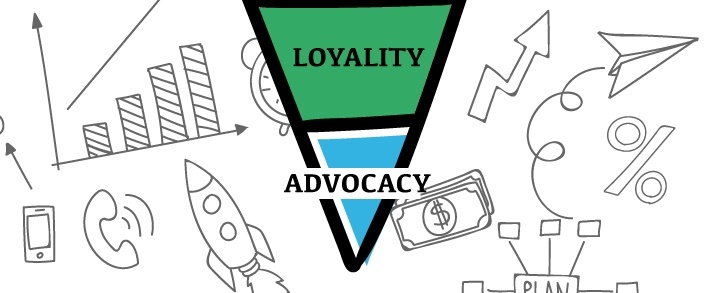
After you have acquired new customers the relationship with them has not come to an end. You have to keep it alive because you have to encourage them to buy from you again.
How can you do that?
You can take Amazon as an example: after you have bought a book from its e-commerce Amazon sends you an email and asks you for feedback. Later Amazon sends you another e-mail with the suggestions of other books that you could be interested in; a choice based on your previous purchase.
At this stage a good practice is for you to send emails to your customers in order to:
- Ask for a feedback;
- Update them about new products;
- Invite them to take part at to your event;
- Reward them with a gift;
- Reward them with a discount on their birthdays.
Remember: you can invite them to share their feedback on your social channels. In this way you can convert your customers into ambassadors.
Tracking the progress
At this stage it is important to measure the number of email disclosures and the number of the subscribers that click on the link shown on the email, and the number of subscribers who decided to use the discount coupon or to take the gift.
The inbound methodology guides the customer step-by-step through their journey with useful and helpful contents. Customers don’t feel the pressure to buy a product or a service, they perceive your company like a valid ally that can help them in finding the right solution for their problems.
Each Inbound Marketing campaign starts once you analyzed your marketplace and your buyer personas. Are you ready? Begin designing your potential customers!

Search by posts
Recent posts.
- GITEX Africa in Marrakech: Unveiling Africa’s Tech Future and Digital Healthcare Revolution
- Influencer Marketing for Fashion Brands: What’s New in 2023
- Click Analytic Influencer Marketing: Interview with CEO Paul Boulet
- A Traditional Approach to a Modern Communication Plan
- Highlights at the GITEX 2022 Event
social media

- Company History
- Our Process
- HubSpot Certified Partners
- Are We The Right Fit?
- Giving Back
- Full List of Services
- Inbound Marketing
- SEO Services
- HubSpot Consulting
- Podcast Services
- Video & Photography Services
- Email Marketing Services
- Design Services
- Website Audits
- SEO Ultimate Guide
- Inbound Marketing Guide
- Digital Marketing FAQ
- Web Design FAQ
- Website & Marketing Glossary
- Core Web Vitals Guide
- Free Website Grader
- HubSpot ROI Calculator

Inbound Marketing Strategy: Mapping the Customer Journey

Today's buyer is more informed than ever before, thanks to the vast amount of information available at their fingertips. Because of this, the balance of power has shifted from the sales rep to the buyer in most sales conversations. This is why pushy sales tactics are no longer effective the way they used to be. Instead, to be successful in sales in today's day and age, sales reps must adapt their mindset from selling to helping. And the best way to start this process is becoming intimately familiar with who the buyer is and the journey they take on their path to purchase: The buyer's journey.
What is the buyer's journey?
The buyer’s journey is broken down into three stages: awareness , consideration , and decision . all three are essential to understanding how prospects eventually become buyers..
The buyer's journey describes a buyer's path to purchase. In other words, buyers don't wake up and decide to buy on a whim. They go through a process to become aware of, consider and evaluate, and decide to purchase a new product or service. By understanding the buyer's journey, the pains and problems they experience along that journey, and the influencing factors that shape their thinking, sales reps can better empathize with the buyer and position their product or service along that path. So let's dig in a little further.
What are the three stages of the buyer's journey?
The buyer's journey can be broken down into three steps or "stages" that describe how they advance along their path to purchase: the awareness stage, the consideration stage, and the decision stage. Here's how to conceptualize each stage:
- Awareness Stage: The buyer becomes aware that they have a problem.
- Consideration Stage : The buyer defines their problem and considers options to solve it.
- Decision Stage : The buyer evaluates and decides on the right provider to administer the solution.
Buyer Journey Mapping

Buyer journey mapping is the process of visualizing how a customer interacts with a business by mapping out the actions they take to achieve a goal. Customer journey mapping outlines key events, customer motivations, and areas of friction within their experience. Then, this information is combined into a comprehensive visual that describes a customer’s typical experience with your business.
By understanding this relationship, you can structure your touchpoints to create the most effective and efficient process for your customers. A customer journey map visualizes the current process customers take, from the first to final touchpoint, to see if they’re currently reaching their goals and, if not, how they can. A Buyer Journey Map will identify your clients overall buying process, actions, emotions, pain points and solutions. This can help you to identify how to engage with them throughout every stage of their buying process.
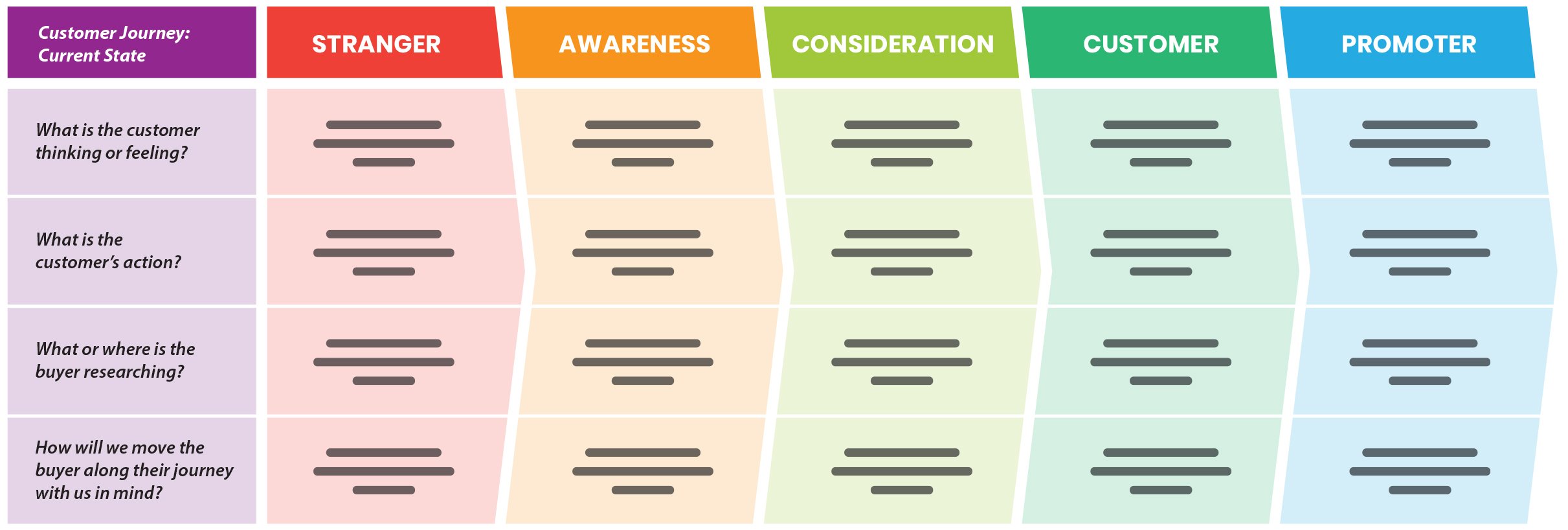
Now that the overall journey has been defined, let's take a look at each stage in greater detail, from the buyer's perspective:
What is the buyer doing during the awareness stage?
The buyer is experiencing a problem or symptoms of a pain, and their goal is to alleviate it. They may be looking for informational resources to more clearly understand, frame, and give a name to their problem.
- Example: "Why do my feet hurt all the time?"
What is the buyer doing the consideration stage?
The buyer will have clearly defined and given a name to their problem, and they are committed to researching and understanding all of the available approaches and/or methods to solving the defined problem or opportunity.
- Example: "How do you treat arch pain?"
What is the buyer doing during the decision stage?
The buyer has decided on their solution strategy, method, or approach. Their goal now is to compile a list of available vendors, make a short list, and ultimately make a final purchase decision.
- Example: "Where can I get custom orthotics? How much will they cost?"
If you don't have an intimate understanding of your buyers, it may be difficult to map out the buyer's journey in a way that will be helpful from a sales perspective. In this case, be sure to conduct a few interviews with customers, prospects, and other salespeople at your company to get a sense of the buying journey.
Tailoring Your Sales Process to the Buyer's Journey
With all of this in mind, buyers don't want to be prospected, or demoed, or closed when they're not ready. These steps add zero value, from their perspective, when offered at the wrong time. However, where a sales rep can shine is in the instances when buyers are looking for additional information about your product that can't be found online.
Awareness Stage
Buyers are identifying the challenge or opportunity they want to pursue. They are also deciding whether or not the goal or challenge should be a priority. WHAT WE SHOULD BE ASKING
- How do buyers describe their goals or challenges in the context of our business?
- How are our buyers educating themselves on these goals or challenges?
- What are the consequences of inaction by the buyer?
- Are there common misconceptions buyers have about addressing the goal or challenge?
- How do buyers decide whether the goal or challenge should be prioritized?
ACTIONS WE SHOULD BE TAKING
- Creating informational, not salesy, sales collateral that educates them along their path to purchase.
- Providing them with resources to help them define the problem.
- Helping, helping, helping.
Consideration Stage
Buyers have clearly defined the goal or challenge and have committed to addressing it. They are now evaluating different approaches or methods available to pursue the goal or solve their challenge.
WHAT WE SHOULD BE ASKING
- What categories of solutions do buyers investigate?
- How do buyers educate themselves on the various categories?
- How do buyers perceive the pros and cons of each category?
- How do buyers decide which category is right for them?
- Understanding exactly how our product or service solves their problem compared to both our direct and indirect competitors.
- Considering how our direct and indirect competitors are showing up in the marketplace and how they influence perception.
- Providing the buyer with resources to help them determine the solution that's right for them.
Decision Stage
Buyers have already decided on a solution category and are now evaluating providers. For example, they may have written a pro/con list of specific offerings to decide on the one that best meets their needs.
- What criteria do buyers use to evaluate the available offerings?
- When buyers investigate our company's offering, what do they like about it compared to alternatives? What concerns do they have with it?
- Who needs to be involved in the decision? For each person involved, how does their perspective on the decision differ?
- Do buyers have expectations around trying the offering before they purchase it?
- Outside of purchasing, do buyers need to make additional preparations, such as implementation plans or training strategies?
- Understanding what objections they might have prior to the sales process so that you can adequately handle them.
- Ensuring that you have a unique selling proposition that provides value to the buyer and sets you apart from competitors.
Some of these considerations may fall more under the marketing umbrella than the sales umbrella, but ultimately the answers to these questions will provide a robust foundation for your buyer's journey. The process of getting to know how your buyers buy is invaluable as you create or refine your sales process. You'll be better able to empathize with prospects, handle objections, and provide the right information at the right time, helping you close more deals and win more business.
Create content that's relevant to your audience at every stage.
Creating relevant, valuable content is a major tenet of inbound marketing . The content you're creating should be in line with the goals and challenges of specific segments of your audience. It all boils down to creating the right content for the right people at the right time. And the best way to do that? Through mapping out your content according to buyer persona and lifecycle stage.

Latest Posts

Website Accessibility Lawsuits: What Every Business Needs to Know

Hubspot's New Content Hub: Everything You Need to Know
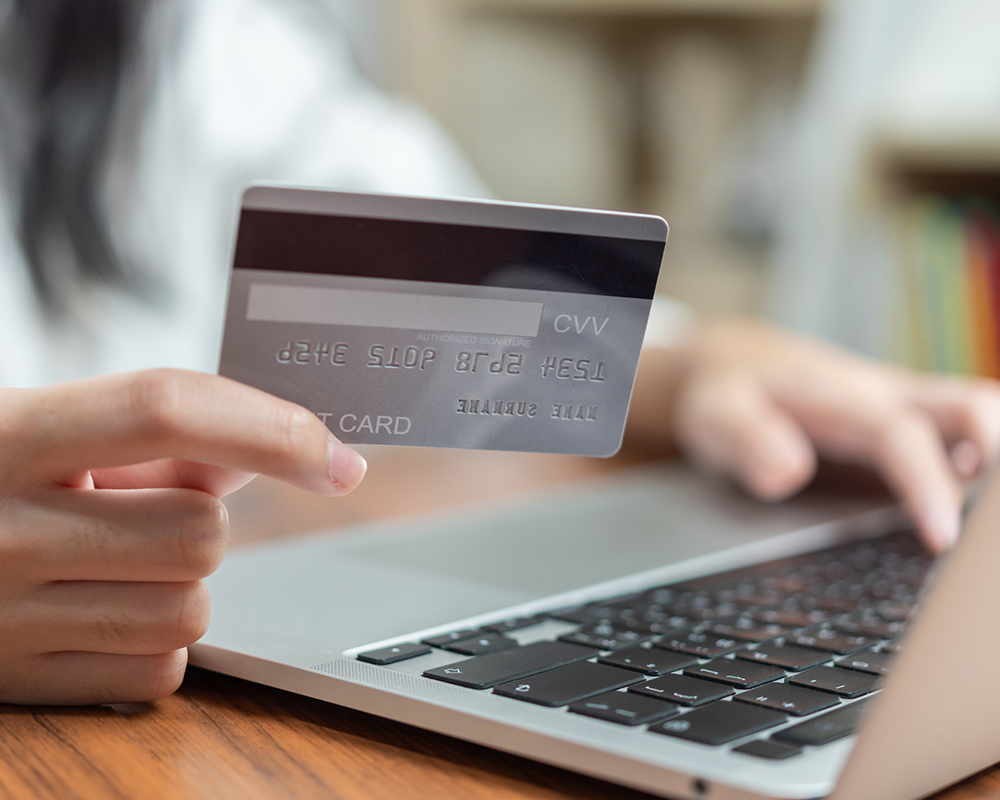
Ultimate Guide to HubSpot Payments
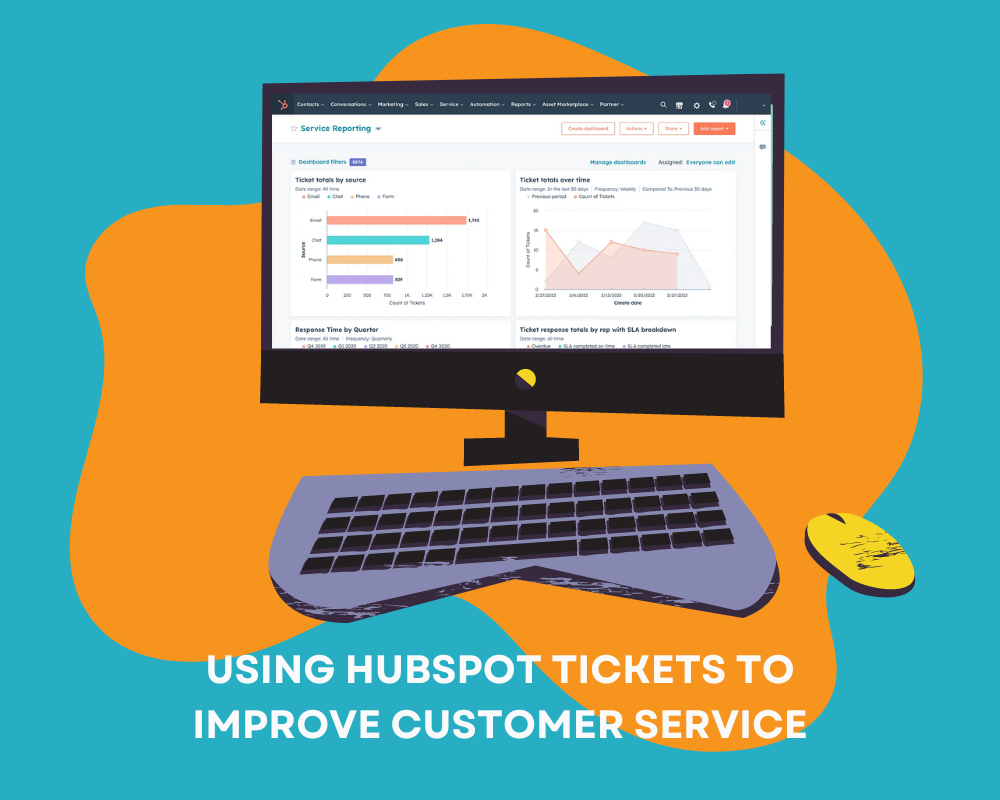
Using HubSpot Tickets to Improve Customer Service
- Web Design (52)
- Inbound Marketing (50)
- Digital Marketing (39)
- Marketing (37)
- HubSpot (31)
- Search Engine Optimization (SEO) (27)
- Social Media (26)
- Content Marketing (21)
- Small Business (19)
- Strategy (19)
- Blogging (16)
- Digital Ads (12)
- Lead Generation (11)
- WorldLight Media News (11)
- Web Maintenance (10)
- Automation (9)
- Branding (9)
- Digital Marketing Funnels (9)
- Lead Nurturing (9)
- Mobile Web Design (9)
- AI marketing (7)
- Email Marketing (7)
- Facebook (7)
- Sales Automation (7)
- Design & Artwork (6)
- Driving Traffic (6)
- Google Ads (6)
- Pay Per Click (PPC) (6)
- User Experience (6)
- Conversion Rate Optimization (CRO) (5)
- Instagram (5)
- Landing Pages (5)
- WordPress (5)
- Conversion Rate (4)
- Customer Journey (4)
- Customer Relationship (4)
- Engagement (4)
- Fresno Chamber of Commerce (4)
- Video Podcasting (4)
- ADA Compliance (3)
- Ecommerce (3)
- Growth-Driven Design (3)
- Performance Reports (3)
- Personalization (3)
- Twitter (3)
- Accessibility (2)
- Buyer Personas (2)
- Convert (2)
- Customer Journey Map (2)
- Email Marketing Campaigns (2)
- LinkedIn (2)
- Sales Enablement (2)
- YouTube (2)
- Buyer Profile (1)
- Data Laws (1)
- Data Protection (1)
- Discounts (1)
- Lead Scoring (1)
- Martech (1)
- Pinterest (1)
- Storybranding (1)
- Testing (1)
- Threads (1)
- Webflow (1)

What Is Inbound Marketing? (How To Build a Profitable Strategy)
Aug 16, 2022 | Read time: 10 min.
Jonas Sickler , Digital Marketing Analyst
Contents Jump to
If your team primarily uses outbound marketing tactics, then you’ve probably noticed how hard it is to grab a slice of audience attention these days. It turns out, folks don’t like disruptive marketing techniques such as cold outreach and programmatic advertising.
Fortunately, inbound marketing is the exact opposite. An inbound strategy helps you attract potential customers when they’re ready to act , nurtures the relationship, and delivers exceptional value through content marketing.
In this article, I’ll define what inbound marketing is, and how it works, so you can create a more diversified and sustainable sales pipeline.
MARKETING TERM DEFINITION What is inbound marketing? Inbound marketing refers to the strategic creation of valuable content to attract, engage, and delight customers. The inbound marketing methodology is a form of pull marketing that was introduced by HubSpot in 2006.
Inbound marketing vs outbound marketing
It’s easy to get turned around when trying to understand the concept of inbound marketing because some channels fit into both columns depending on how you use them.
For example, if you use email marketing for cold outreach, then it’s an outbound channel. However, if you use marketing automation to deliver personalized email content to subscribers, then you’re using it as an inbound channel to nurture leads.
In short, outbound marketing pushes a generic message out to a broad audience that didn’t raise their hand and ask for it. Think of commercials and telemarketing, for example. In contrast, inbound marketing focuses on attracting and engaging a specific audience by creating valuable content they want.
Examples of inbound marketing content
Inbound strategies use several different types of content marketing and formats, including a mix of informational, gated, and promotional content. The idea is to generate brand awareness and develop strong relationships while also baiting the hook to capture contact information, and ultimately close the deal.
So, while you develop your plan, think about how you can attract potential customers throughout the entire content marketing funnel .
Top-of-funnel (TOFU)
- Social media campaigns
- Public relations
- Byline articles
- Infographics
Middle-of-funnel (MOFU)
- White papers
- Email campaigns
Bottom-of-funnel (BOFU)
- Case studies
- Pricing pages
- Product comparison pages
- Sell sheets
- Testimonials
If you want to learn more about funnels, then read our article, “ What the Heck is TOFU, MOFU, and BOFU? ”
4 stages of inbound marketing
Inbound marketing is about much more than website traffic. It’s a full-funnel marketing strategy that activates your audience at each stage of the journey. Let’s look at the four phases of the inbound methodology.
The first inbound phase is attraction marketing . Your objective is to introduce your brand to new audiences and drive traffic to your website. Content that works best in this stage include social media posts, bylines, public relations articles, and blog articles.
Blog posts based on the topic cluster framework are ideal because they cover many related themes from different angles.
Helpful software in this stage includes tools for keyword research, content optimization, social media monitoring and scheduling, as well as email outreach tools.
In the second inbound marketing stage, you need to engage your audience and convert interest into action. This phase is all about lead generation.
Your goal is to entice potential customers to exchange their contact information for valuable insights. Then, you can nurture them with drip campaigns until they’re ready to speak to a sales rep. The best types of content for this phase include white papers, market reports, e-books, and webinars.
Tools to consider here include landing page generators, conversion optimization tools, and email marketing software.
The third inbound marketing stage is closing the deal. Your objective is to clarify your value proposition, reduce fears, and demonstrate dependability. The best content marketing examples to include here are website solution pages, case studies, sell sheets, online reviews , calculators, and testimonials.
Valuable tools to close deals include a customer relationship management (CRM) platform, pitch decks, and sell sheets.
Delight & upsell
The fourth stage of inbound marketing is about delivering exceptional value to customers so they can’t function without you. In other words: help them see why they can’t live without you.
Your goal in this phase is to strengthen your relationship and highlight your results so they keep asking for more. Content that works best includes slide decks, quarterly business review (QBR) reports, social media posts, direct emails to POCs, video testimonials, and case studies.
It’s harder to nail down specific tools in this stage, but your CRM would be valuable to track data about your POC, as well as performance dashboards and data visualization tools.
Content Strategy Playbook
The Fortune 500 CMO’s guide to content strategy.
How to develop an inbound marketing strategy
Traditional outbound marketing techniques like cold calling aren’t enough to fill your sales funnel. If you want to flood your sales team with qualified leads that convert into new customers, then you also need an effective inbound marketing plan.
Here’s how to create one.
Research your target audience
Inbound marketing is about attracting and engaging your target audience with relevant content. So, if you want to be effective, then you need to understand your customer segments.
Gather data from your sales and product teams about your existing customers to understand your customer lifetime value (CLV) and customer lifecycles . Which segments stay with you the longest, and which ones are most profitable? On the other hand, do some customers cause friction, drain your customer support resources, and eat away at your margins?
The more data you have, the easier it is to segment them into groups so you can create customer personas.
Develop buyer personas
Market research is an invaluable step in the inbound marketing process, but it’s not very user-friendly. To develop effective marketing campaigns that resonate, you need to distill that research into something more actionable. In other words, you need a buyer persona that represents your ideal customer.
Customer personas should include vital information to help you understand how each audience segment thinks and behaves.
It’s a good idea to create several buyer persona examples based on each of your customer segments to personalize your marketing efforts.
Map the buyer’s journey
One of the strengths of inbound marketing is that it reaches potential customers throughout the funnel. To ensure you don’t miss key decision-making moments, map the customer journey from awareness to conversion.
Include every inbound digital marketing channel where you can interact with your target audience as well as friction points to overcome and opportunities to move prospects through the funnel.
Build trust with content marketing
High-quality content is the pillar of your inbound marketing strategy because it positions your brand as the ultimate authority in your space. Each piece of content you create should target a specific audience’s need at a key moment during their journey.
However, don’t just create separate, disjointed pieces of content or you’ll end up with a fragmented digital customer experience . Instead, develop a cohesive content strategy that guides customers along their journey.
Think of all the questions they have, and how you can use content marketing to provide the best answer.
Create lead generation landing pages
Salesforce and HubSpot stand out as some of the best examples of inbound marketing because they have massive content libraries. Although they give it all away for free, you still need to part with your contact information to get it.
However, content creation is just the first step in lead generation . You also need to promote the content across your website as well as other marketing channels. This can include paid advertising, strategic partnerships, influencer marketing, and of course calls-to-action (CTAs) within your own content.
The main objective is to direct traffic to lead generation landing pages where you collect contact information through forms. As a result, you’ll be able to market directly to users who opt into emails with highly targeted content.
Amplify inbound marketing with SEO
Your content marketing efforts will be wasted if your audience never sees what you publish. That’s why search engine optimization (SEO) is absolutely critical to an effective inbound marketing strategy.
In order to be visible in the search engine results pages (SERPs) when customers search for keywords that are relevant to your brand, your SEO strategy must be rock solid.
You need to consider search intent, on-page optimization, technical SEO, link building, E-E-A-T , user experience, and so much more. It’s not something you can do by hiring one person. You either need a complete in-house team, or you need to outsource SEO services to a trusted partner like Terakeet.
Use word-of-mouth for inbound marketing
Any small business owner will tell you word-of-mouth is their most valuable marketing asset. When happy customers share their experiences with a company, it builds trust, improves conversions, and drives revenue.
Therefore, it’s no surprise that successful inbound marketing campaigns also leverage social proof. In fact, most digital marketing strategies should include a Voice of the Customer program to collect and promote customer testimonials and online reviews.
Positive feedback helps you close more deals. And negative feedback is valuable because it can reveal problems that might cause brand reputation issues down the road.
In addition to sharing word-of-mouth feedback on your website, you can also include it in emails to potential customers who are on the verge of making a purchase.
Consumer Connections Newsletter
Exclusive insights, trends, and actionable brand strategy, direct to your inbox.
Leverage social media marketing
Social media marketing is an incredibly powerful inbound marketing tactic for growing brand awareness. When you share great content on social networks, you’ll earn more followers, which means greater brand exposure.
Platforms like Twitter and Linkedin are excellent for content discovery tools, so you can introduce your audience to problems they might not know they had. Your social profiles will drive qualified traffic to your website where they can learn more about your company.
In addition, your audience may begin doing research in Google where they’ll discover your brand again. Multiple customer touchpoints like this reinforce your brand’s expertise and authority in your industry.
Nurture inbound marketing leads with email marketing
Unlike traditional marketing methods such as commercials, print ads, and billboards, email marketing gives you access to detailed metrics to measure your audience’s engagement. Furthermore, you can set up customizable automations that run based on user interactions and interests.
For example, you can customize your drip campaigns for each new lead that enters your database so they only see highly relevant content based on what they downloaded or subscribed to. Then, as users continue to engage with your emails, you can test new subject lines, links, and CTAs within the emails to improve conversion rates.
Boost efficiency with marketing automation workflows
Marketing automation is another pillar of inbound marketing because it allows you to automatically deliver more personalized experiences in real time.
Imagine this scenario: A potential customer searches Google to learn about something related to your services. This visitor clicks your website and reads half your article before an automated CTA pops up that offers a downloadable white paper.
The user fills out the form to get the download, then they begin to receive an email drip campaign with related articles, case studies, and testimonials. You may even set up conditional rules in the sequence to deliver unopened emails again with a different subject line.
Each time the user interacts with a piece of marketing collateral, your marketing automation software scores give the contact a few points. And when they reach a certain score, you get an alert to invite them to a sales call.
That scenario just scratches the surface of how marketing automation can support your inbound strategy. You can also leverage social media sharing software, chatbots, and even fully customizable landing pages for your top leads.
Test and optimize your inbound marketing strategy
The most important thing to understand about inbound marketing is that it’s an iterative process. You must constantly test, measure, and optimize everything.
Micro improvements in conversion rates on one end can ripple through your entire strategy and drive millions in incremental revenue. If you build a working model with formulas to track conversions from traffic, to lead, to customer, then you’ll see the compounding value of improving every element within your strategy.
The reason why inbound marketing works so well is because it delivers efficiency, personalization, and unique value. You might be able to reach a larger audience with outbound marketing, but it won’t be as targeted. Furthermore, you can’t provide personalized value with generic messaging that leads to trust, engagement, and sales.
Inbound Marketing FAQs
Inbound marketing refers to the strategic creation of valuable content to attract, engage, and delight customers. The inbound marketing methodology is a form of pull marketing that was introduced by HubSpot in 2006.
The most common types of inbound marketing include: -Social media posts -Third-party articles -Blog posts -Infographics -Webinars & podcasts -White papers -Targeted email campaigns
OAO Resources
Level up your marketing with these powerful OAO resources!
Read Next...

Responding to RSV: How Pharma Brands Can Help 131 Million People
Mar 29, 2024

Terakeet Appoints Industry Veteran and Fortune 50 Adviser David Minifie as Chief Marketing Officer
Mar 14, 2024

Learn how consumer insights can drive consumer connection
CMO-level insights, digital trends, and thought leadership sent to your inbox.
Unlock instant access to 25+ digital marketing resources and the OAO 101 introductory email course to kick start your strategy.
Terakeet uses cookies to enhance your experience and analyze traffic. By clicking accept you agree to our use of cookies.
- Inbound Marketing

Customer Journey Vs. Buyers’ Journeys: What’s the Difference?
There’s no doubt about it, marketing terms are confusing for us inside the industry - let alone those outside of it. While marketing terms and buzzwords are often used interchangeably, there’s generally vast differences in what they actually mean.
Two phrases that are commonly used interchangeably but are completely different are the buyers’ journey and the customer’s journey .
In this blog, The Brit Agency is going to explore what both of these phrases mean, why they are so important to your B2B Inbound Marketing strategy and how they are different from each other.
So, let’s get started with the buyers’ journey.
What is the buyers’ journey?
The buyers’ journey is the process that a customer goes through in order to purchase a product or service from your company. It’s their entire journey from researching their problem, finding potential solutions to solve it, and then choosing one of those solutions.
The buyer’s journey is broken down into three stages; awareness, consideration, and decision. Here’s what each of those stages mean.
Awareness : The buyer is experiencing a problem or pain point, and they are looking for information to understand and name their issue.
Consideration : Now that the buyer has a clearly defined name for their problem, they have started to research and understand all of the methods that could solve the problem.
Decision : The buyer has decided what solution they want to use to fix their issue, now they are comparing a list of available brands to make their final purchase decision.
Why is the buyers’ journey important?
The buyers’ journey gives your brand the information it needs to create the right content that helps prospects move through their buyers’ journey seamlessly. By mapping the buyers’ journey, your business will be able to understand the process that customers go through to select a product, helping you to better solve their problems by providing them with the right information.
By creating the right content at the right time, you can provide valuable resources that answer your potential customers' questions right when they have them.
Want to learn more about this process? Check out our blog, Content Mapping: Creating a Link Between Buyer Personas and the Buyer Journey .
What is the customer’s journey?
Unlike the buyers’ journey that focuses on prospects, the customer journey is a process that strengthens the relationship that your brand has with existing customers in an effort to ensure they are more loyal to your brand and to increase customer lifetime value (CLV).
The customer journey focuses on targeting existing customers with post-purchase content that enhances their experience as a customer of your brand. The aim is to improve customer retention rates.
By making all of the experiences a customer has with your brand delightful, even after they’ve made their purchase, and you will increase the likelihood that a customer will buy your products or use your services again in the future.
Why is the customer journey important?
Did you know that it costs up to five times more to acquire a new customer than retain an existing one? Meanwhile, increasing customer retention rates by just 5 percent can increase profits from anywhere between 25 percent and 95 percent ( Harvard Business Review ).
These figures show just how important it is for your business to think about the customer journey. If you don’t focus on the customer journey, your business is missing a huge opportunity to strengthen customer loyalty and grow revenues.
What’s the difference between the buyers’ journey and the customer’s journey?
So to summarize, the buyers’ journey is about the steps a prospect goes through to come to a purchasing decision, while the customer’s journey is a strategy used to retain customers after they have already made a purchase with your brand.
The buyers’ journey focuses on creating content that nurtures a prospect through their decision-making process - answering the questions they have at the exact moment that they have them.
Once they have gone through the buyer journey and have become a customer, your customer journey strategy will kick in. This is where you will focus on establishing customer loyalty and retention, ensuring your customers continue to buy your products or services in the future.
Both of these strategies focus on valuable content that genuinely help your prospect or customer with the answers they are looking for.
Want to learn more about how content can be used to improve your buyers’ journey and customer journey strategies? Get in touch with The Brit Agency today . Our team of Inbound Marketing and content specialists would love to help.
Topics: Inbound Marketing , Customer Experience
Subscribe Here!
Posts by tag.
- Inbound Marketing (70)
- Content Marketing (17)
- HubSpot (15)
- Inbound Sales (14)
- SEO & Keywords (10)
- Social Media (10)
- Lead Generation (9)
- B2B Inbound Marketing (8)
- Digital Marketing (8)
- Email Marketing (8)
- Marketing Automation (8)
- B2B Inbound (7)
- Inbound Website Design (7)
- Toronto HUG (6)
- Inbound (5)
- Inbound Sales & CRM (5)
- Website Development (4)
- B2B Sectors (3)
- Goal Setting (3)
- Inbound Website (3)
- Agency News (2)
- Analytics (2)
- Buyer Persona (2)
- Call-To-Action (2)
- Content Management System (2)
- Conversion Rates (2)
- Customer Experience (2)
- Lead Management (2)
- landing pages (2)
- "Manufacturing Marketing" (1)
- AI - Artificial Intelligence for Marketing & Sales (1)
- Blogging (1)
- Branding (1)
- Growth Model (1)
- Inbound Organization (1)
- Inbound18 (1)
- Keyword Strategy (1)
- Lead Nurturing (1)
- LinkedIn (1)
- Networking (1)
- Responsive Design (1)
Toronto | Ontario | Canada
Barrie | ontario | canada, quick links.
- Are We a Fit?

The Brit Agency is a B2B Inbound Marketing Agency, and HubSpot Solutions Partner, focused on HubSpot CMS Website Design & Development, Inbound Marketing, Content Marketing, Marketing Automation, and Lead Generation, leveraging the HubSpot CRM as a business growth platform.
CONNECT WITH US
Copyright © 2024 Powered by HubSpot . The Brit Agency , Suite 110, 132-K Commerce Park Road, Barrie, ON, L4N 0Z7, Canada | B2B Inbound Marketing Agency | Toronto, Ontario, Canada | Privacy Policy
Fewer Inbound Leads in 2024? 3 Things Sellers Should Do to Hit their Numbers.
Published: April 01, 2024
Welcome to "The Pipeline" — a weekly column from HubSpot, featuring actionable advice and insight from real sales leaders. This week's installment comes from Repvue's Founder and CEO, Ryan Walsh . Want more content like this? Subscribe to our newsletter.

Ask any salesperson if they get enough inbound leads. You can bet their answer will be “no.” It won’t matter who they work for or what industry they’re in. It’s kind of a running joke that no seller will ever get enough leads.
![customer journey inbound marketing Download Now: 2024 Sales Trends Report [New Data]](https://no-cache.hubspot.com/cta/default/53/9cdc68ed-d735-4161-8fea-0de2bab95cef.png)
Every seller wants a strong, steady stream of quality inbound leads. Preferably ones with a big budget and high intent to purchase. Lately, that’s unlikely to be the case.
So, let’s take a look at the trends sellers are reporting about inbound lead flow on RepVue , and three things you can do to still hit your targets.
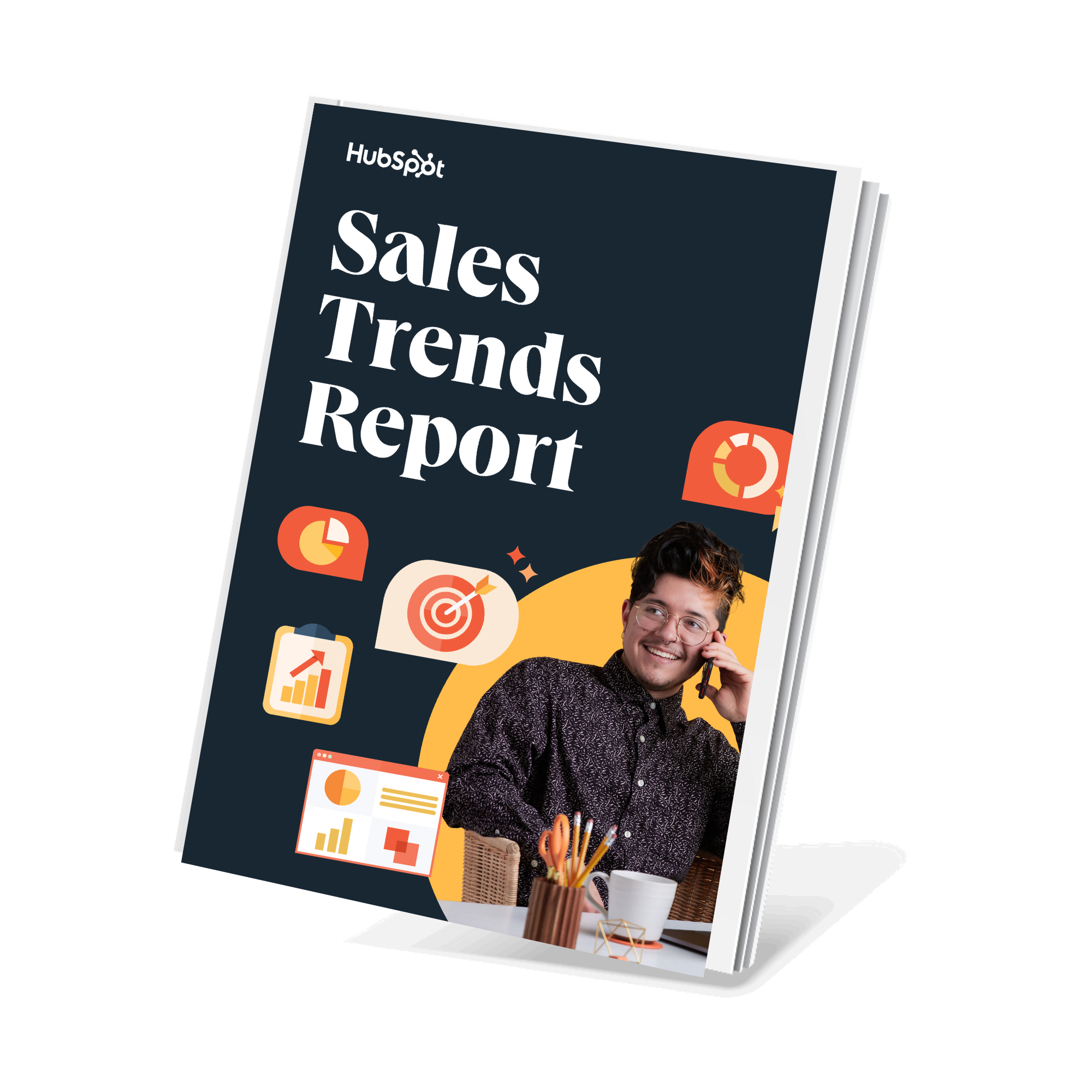
HubSpot's 2024 Sales Trends Report
This in-depth report includes sections, covering:
- How buyers are becoming more self-informed
- How sales teams are using AI and automation
- Adapting to tighter budgets
You're all set!
Click this link to access this resource at any time.
Seller Sentiments About Inbound Lead Flow Fell Year-Over-Year
Here’s some data we were looking at recently that shows the difference in seller sentiments for inbound lead flow comparing Q4-2023 to Q4-2022.
When salespeople rate their sales organizations on our site, we ask them to rate how they feel about inbound lead flow on a scale from 1–5.
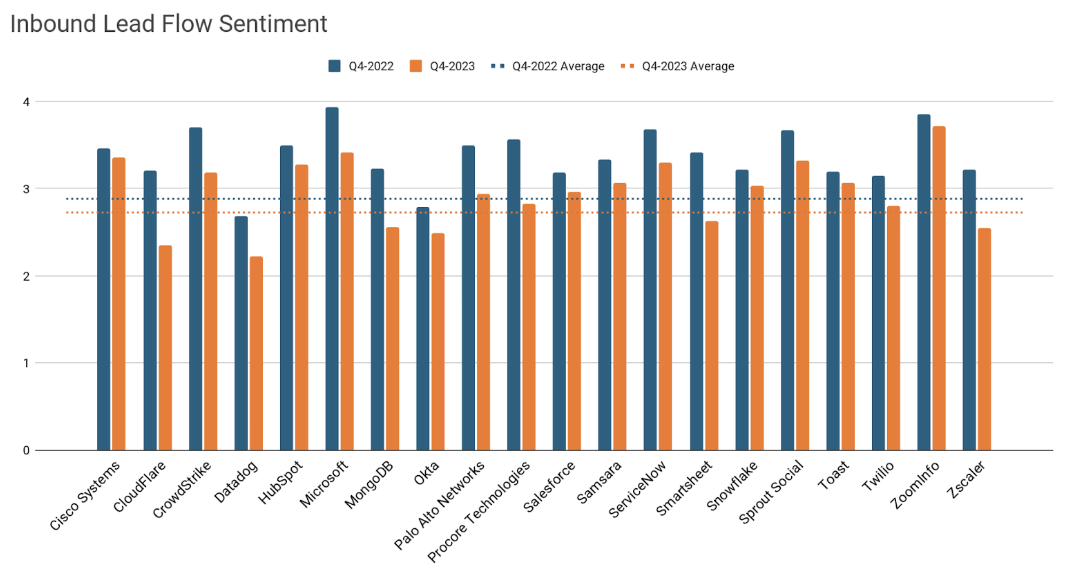
Don't forget to share this post!
Related articles.

Forging a Career in Insurance Sales — The Complete Guide

Generating Real Estate Leads in 2023: 27 Tried and True Methods

Lead Generation Specialists — What They Are and How to Become One
![customer journey inbound marketing How to Get Into Sales Without a Degree [+ 7 Expert Tips]](https://blog.hubspot.com/hubfs/sales-job-degree%20%281%29.jpg)
How to Get Into Sales Without a Degree [+ 7 Expert Tips]

How Salespeople Can Rebound Their Career After a Layoff (Tips from Reps Who’ve Done It)
Sales Lead Tracking: The HubSpot Guide to Automatically Tracking and Reporting Leads

How to Kick Off Your SaaS Sales Career

Sales Cadence Made Simple: The Top Habits That Make Money

Direct Mail Marketing: Advantages and How to Use It for Your Business

Sales Prospecting on Quora: 8 Easy Steps to Get Started
Find data and insights across B2B and B2C sales to power your 2024 sales strategy.
Powerful and easy-to-use sales software that drives productivity, enables customer connection, and supports growing sales orgs
How Your CRM and Email Marketing Program Drive Engagement, Sales and More

Think of your business like a rocking party and your customers as the VIP guests. You wouldn’t just blast a megaphone to get their attention; no, you’d mingle, offer them their favorite drinks — personalized service, right?
That’s where customer relationship management (CRM) and email marketing strut onto the dance floor. Just like an imaginative party planner, an email marketing tool helps you communicate with your audience smoothly. It keeps track of their likes and dislikes and makes sure you’re sending them personalized invitations (read: targeted emails) that get them riled up about your event.
So, you’ve got a bunch of email addresses — hooray for you! But the real magic happens when you integrate those with the customer data inside your CRM system. This combo is about as harmonious as peanut butter and jelly. It’s all about sending the right email campaign to the right person at the right time in their customer journey. As marketing automation joins forces with your CRM tool, every email newsletter feels like it’s been handcrafted by a master artisan — or your marketing team, because they’re awesome.
And let’s not forget the latest buzzword — omnichannel . It doesn’t necessarily describe one particular CRM feature. Rather, it’s when you go beyond the mass email approach and coordinate those messages with your activities on social media or your website. A cold email here, a video there and perhaps a sweet SMS to top it off. CRM email marketing makes sure your communication game is stronger than ever, creating a symphony of personalized emails that sing to each customer. And who doesn’t like a serenade?
What Is CRM Email Marketing?
Picture this: You’re juggling a bazillion emails, trying to give your customers that warm, fuzzy, ‘they-really-get-me’ feeling. Enter CRM email marketing, the trusty team here to save the day!
This dynamic duo lets you store precious customer data in a database tailored for email marketing bliss. Think of your CRM platform as the secret recipe and your email marketing tools as the whisk. Sure, you can make a delicious meal without them, but when they meet, you’re faster and see happy faces around the table.
What do they both bring to the party? On one side, you’ve got your email analytics, a campaign monitor or even an email template which you update based on engagement. On the other hand, you’ve got your contact management, recent customer support statistics and your sales team’s extensive knowledge base and marketing hub with current product information. Throw them both together and you’ll instantly become more effective in your messaging.
After all, nobody will get your clients the way you do — because, unlike your competitors, you and your email marketing CRM will keep learning about them. What’s more, it helps you manage and nurture these relationships. Just consider all those transactional emails you know you could send if only you had the time, be it for lead generation or to boost customer retention . Well, with CRM email marketing, there’s no more excuses (sorry).
Help yourself to a big scoop of automation and wave goodbye to the tedium of manually working on a marketing campaign. CRM email automation means setting up detailed drip campaigns that run on autopilot, delivering the right message at just the right time. And with artificial intelligence getting in on the action, it’s like having a little brain that knows exactly who needs a nudge and when.
Your email marketing tool could already tell you that Susan from Oklahoma opened 3 out of 4 emails. But with a CRM tool, you can combine insights from two databases. Now you understand that Susan recently purchased your entry-level product and that she’s obsessed with cats.
So, if you’re serious about hitting the email marketing jackpot, peppering your strategy with some CRM finesse might just be what you need. You’ll not only keep your audience engaged but also laugh all the way to your ‘favorite customer’ leaderboard. Better start warming up those typing fingers; your email integration journey awaits!
Benefits of Using CRM Software for Email Marketing
Granted, we’re obviously biased. Asking a content marketing agency about the benefits of inbound marketing tools is like asking an ultramarathoner about their favorite running shoe. It just makes life so much easier. Let us give you an idea of the benefits you can hope for if you join Club CRM:
- Enhanced Personalization: You know those birthday wishes from companies that come out of the blue? An email campaign like that makes you feel appreciated and seen. Well, with a CRM tool, your email content can give that same cozy vibe to every single customer. By dialing into your customer preferences, behaviors and past interactions, tailored email marketing automation feels like a high-five in their inbox.
- Improved Segmentation: Gone are the days of email blasts to every Tom, Dick and Harry. A CRM is your new BFF for cutting through the noise. Your email marketing platform already gave you their behavior, but using both tools, you can break down your audience into neat little segments based on demographics , purchase history or whether they prefer chocolate to vanilla. That way, your email marketing campaign will hit the bullseye, every single time — because nobody likes receiving steakhouse vouchers when they’re vegan.
- Increased Efficiency: Brace yourself; the best CRM feature lies in organizing all your customer data in one place. Say goodbye to the mess of spreadsheets and hello to slick, efficient management. Your CRM is like the ultimate email marketing command center — without the overly tight jumpsuits. You’ll cut down on double-ups and watch your campaign performance shoot through the roof.
- Scalability and Automation: Ever wished you could clone yourself during a massive email campaign? With a CRM, it’s almost like you have. Automation tools let you manage your email list and create targeted messages that trigger based on specific actions or data — think marketing on autopilot. As your business grows, your email marketing scales up without needing a time-turner.
Subscribe to The Content Marketer
Get weekly insights, advice and opinions about all things digital marketing.
Thanks for subscribing! Keep an eye out for a Welcome email from us shortly. If you don’t see it come through, check your spam folder and mark the email as “not spam.”
When Is a Sales CRM System Worth the Investment?
OK, let’s pump the brakes and see if you truly need a CRM system or if email marketing software alone might do. Excited as we may be about it, it’s a hefty investment, especially if you run a small business . And we wouldn’t want you to jump all over it if you couldn’t realize any value. Time to run through our little symptom checklist and find out if CRM software would bulk up your wallet or put it on a diet.
First, consider your sales pipeline. As your business blooms like a spring flower, a CRM might just be the nurturing soil it requires. It’s a fact that managing more clients without mixing up Mr. Smith with Mrs. Smythe gets trickier. A CRM can sort, tag and follow up without any hassle, unlike your Excel sheets that look like a modern art piece gone wrong.
Moving on, are your sales straightforward? Or are they as complex as that 1,000-piece puzzle you never finished? If so, a CRM can make lead scoring easy. It’ll help you differentiate Aunty Ethel, who’s been eyeing your product for ages but probably just likes the thought of it, from Sara, who recently revisited your site after conducting her own research. No email marketing feature alone can give you that level of insight. With the right CRM data, you’ll know where to invest more time for a future return on investment.
Speaking of ROI, don’t even get us started on forecasting. A CRM doesn’t just juggle numbers; it helps you make sense of them, so they become actionable. From bidding prices for online ad placements and profit-and-loss data for individual customer segments to sales forecasts — most CRMs have the brainpower to show you whether your latest marketing stunt was genius or just as effective as a chocolate teapot.
And let’s face it, pricing can be as puzzling as understanding why kids eat glue. But no matter if you’re a small operation or the next big thing, there are CRM plans to fit your budget .
If being bogged down in data sheets isn’t your style (and we wouldn’t blame you), remember that a CRM can help you charm your customers while you count the wins and sip your latte.
Features To Look for in Email Automation and CRM Software
Of course, every CRM provider will tell you they’ve got the best solution. Dogs bark, cats purr and sales reps have “the best.” The question is, will it be the best for your business? Answering that requires some soul searching, a pinch of internal research on current pain points and a general idea of common features in most CRM tools. You’ll need to cover the first two, but we can help you out with the third.
Automations
Prepare to get wowed! Many CRM applications let you implement automated workflows, turning your email marketing into a well-oiled machine. Think of it as hiring a robot that works 24/7, sending out targeted campaigns whenever your customers as much as sneeze in the right direction, without annoying them, of course.
Contact Management
Just hoarding contacts won’t get you anywhere. After all, most providers charge you for a sizable list. A solid contact management system will provide segmentation, tagging and various integrations, allowing you to transform a jumbled mess into an orderly paradise where every contact feels like the guest of honor. Not only will that avoid those pesky repeated emails; it’ll also let you automate messages based on your customers’ actions, which become increasingly valuable as your business grows.
Reporting and Analytics
Ever wanted a crystal ball for your campaigns? Well, reporting features in your CRM are the next best thing. A/B testing and email sequences’ success are no longer a guessing game, as analytics will spill the beans on the who, what, when and why of customer engagements.
Integrations
Having a CRM that plays nicely with other tools, like social media platforms, is like hosting the coolest party on the block. It ensures all your apps are not just showing up but bringing their A-game to your marketing campaigns.
Get your hands on a treasure trove of pre-made email templates or show off your style with custom uploads from your design team. Creating campaigns becomes easy, deliciously simple and infinitely satisfying.
Segmentation
Slice and dice your audience like a ninja with segmentation tools. Sending targeted campaigns to groups based on their behavior, preferences or your secret marketing sauce means better engagement and fewer chances of landing in the dreaded spam folder.
User-Friendly Interface
You won’t need a Ph.D. in Email-ology with a user-friendly interface at your side. Plus, if you read up on your provider’s customer service offerings, you don’t need to worry when you hit a snag.
It’s time to embrace the power of CRM systems to boost your efficiency. Fancy analytics? You bet. Customer feedback straight into your campaign tweaking process? Like a digital suggestion box, but actually useful.
If you’re looking to charm your customers and keep them coming back for more, you need to provide a tailored customer experience. And the key to that lies in the right tool. Remember, with great data comes great retention. Go forth and conquer those inboxes with a personal touch that makes your customers feel like they hit the jackpot.
Florian Fuehren
Share this article
Get our weekly newsletter

Florian Fuehren is a Content Writer at Brafton in Germany. Before becoming one of Brafton's first German writers, Florian has worked as a ghostwriter, editor, and lecturer. When he's not brooding over puns for the SaaS or Web3 niche, he likes to go jogging or maltreat his drum kit.
Recommended Reading
Think of your business like a rocking party and your customers as the VIP guests. You wouldn’t just blast a megaphone to get their attention; no, you’d mingle, offer them their favorite drinks — personalized service, right? That’s where customer relationship management (CRM) and email marketing strut onto the dance floor. Just like an imaginative… Read more »

Best Font for Email: Navigating the Good, the Bad and the Ugly (Infographic + Video)
Your email font selection means more than you think. Read on to learn the best and worst style choices for email.
The Content Marketer
Get the latest content marketing updates delivered directly to your inbox with our weekly newsletter.


Clickstream Data: Definition, Use Cases, and More

- April 15, 2024
Gaining a deeper understanding of user behaviour — customers’ different paths, digital footprints, and engagement patterns — is crucial for providing a personalised experience and making informed marketing decisions.
In that sense, clickstream data, or a comprehensive record of a user’s online activities, is one of the most valuable sources of actionable insights into users’ behavioural patterns.
This article will cover everything marketing teams need to know about clickstream data, from the basic definition and examples to benefits, use cases, and best practices.
What is clickstream data?
As a form of web analytics, clickstream data focuses on tracking and analysing a user’s online activity. These digital breadcrumbs offer insights into the websites the user has visited, the pages they viewed, how much time they spent on a page, and where they went next.

Your clickstream pipeline can be viewed as a “roadmap” that can help you recognise consistent patterns in how users navigate your website.
With that said, you won’t be able to learn much by analysing clickstream data collected from one user’s session. However, a proper analysis of large clickstream datasets can provide a wealth of information about consumers’ online behaviours and trends — which marketing teams can use to make informed decisions and optimise their digital marketing strategy.
Clickstream data collection can serve numerous purposes, but the main goal remains the same — gaining valuable insights into visitors’ behaviours and online activities to deliver a better user experience and improve conversion likelihood.
Depending on the specific events you’re tracking, clickstream data can reveal the following:
- How visitors reach your website
- The terms they type into the search engine
- The first page they land on
- The most popular pages and sections of your website
- The amount of time they spend on a page
- Which elements of the page they interact with, and in what sequence
- The click path they take
- When they convert, cancel, or abandon their cart
- Where the user goes once they leave your website
As you can tell, once you start collecting this type of data, you’ll learn quite a bit about the user’s online journey and the different ways they engage with your website — all without including any personal details about your visitors.
Types of clickstream data
While all clickstream data keeps a record of the interactions that occur while the user is navigating a website or a mobile application — or any other digital platform — it can be divided into two types:
- Aggregated (web traffic) data provides comprehensive insights into the total number of visits and user interactions on a digital platform — such as your website — within a given timeframe
- Unaggregated data is broken up into smaller segments, focusing on an individual user’s online behaviour and website interactions
One thing to remember is that to gain valuable insights into user behaviour and uncover sequential patterns, you need a powerful tool and access to full clickstream datasets. Matomo’s Event Tracking can provide a comprehensive view of user interactions on your website or mobile app — everything from clicking a button and completing a form to adding (or removing) products from their cart.
On that note, based on the specific events you’re tracking when a user visits your website, clickstream data can include:
- Web navigation data: referring URL, visited pages, click path, and exit page
- User interaction data: mouse movements, click rate, scroll depth, and button clicks
- Conversion data: form submissions, sign-ups, and transactions
- Temporal data: page load time, timestamps, and the date and time of day of the user’s last login
- Session data: duration, start, and end times and number of pages viewed per session
- Error data: 404 errors and network or server response issues
Try Matomo for Free
Get the web insights you need, without compromising data accuracy.
No credit card required
Clickstream data benefits and use cases
Given the actionable insights that clickstream data collection provides, it can serve a wide range of use cases — from identifying behavioural patterns and trends and examining competitors’ performance to helping marketing teams map out customer journeys and improve ROI.

According to the global Clickstream Analytics Market Report 2024 , some key applications of clickstream analytics include click-path optimisation, website and app optimisation, customer analysis, basket analysis, personalisation, and traffic analysis.

The behavioural patterns and user preferences revealed by clickstream analytics data can have many applications — we’ve outlined the prominent use cases below.
Customer journey mapping
Clickstream data allows you to analyse the e-commerce customer’s online journey and provides insights into how they navigate your website. With such a comprehensive view of their click path, it becomes easier to understand user behaviour at each stage — from initial awareness to conversion — identify the most effective touchpoints and fine-tune that journey to improve their conversion likelihood.
Identifying customer trends
Clickstream data analytics can also help you identify trends and behavioural patterns — the most common sequences and similarities in how users reached your website and interacted with it — especially when you can access data from many website visitors.
Think about it — there are many ways in which you can use these insights into the sequence of clicks and interactions and recurring patterns to your team’s advantage.
Here’s an example:
It can reveal that some pieces of content and CTAs are performing well in encouraging visitors to take action — which shows how you should optimise other pages and what you should strive to create in the future, too.
Preventing site abandonment
Cart abandonment remains a serious issue for online retailers:
According to a recent report, the global cart abandonment rate in the fourth quarter of 2023 was at 83%.
That means that roughly eight out of ten e-commerce customers will abandon their shopping carts — most commonly due to additional costs, slow website loading times and the requirement to create an account before purchasing.
In addition to cart abandonment predictions, clickstream data analytics can reveal the pages where most visitors tend to leave your website. These drop-off points are clear indicators that something’s not working as it should — and once you can pinpoint them, you’ll be able to address the issue and increase conversion likelihood.
Improving marketing campaign ROI
As previously mentioned, clickstream data analysis provides insights into the customer journey. Still, you may not realise that you can also use this data to keep track of your marketing effectiveness .
Global digital ad spending continues to grow — and is expected to reach $836 billion by 2026 . It’s easy to see why relying on accurate data is crucial when deciding which marketing channels to invest in.
You want to ensure you’re allocating your digital marketing and advertising budget to the channels — be it SEO, pay-per-click (PPC) ads, or social media campaigns — that impact driving conversions.
When you combine clickstream e-commerce data with conversion rates, you’ll find the latter in Matomo’s goal reports and have a solid, data-driven foundation for making better marketing decisions.
Delivering a better user experience (UX)
Clickstream data analysis allows you to identify specific “pain points” — areas of the website that are difficult to use and may cause customer frustration.
It’s clear how this would be beneficial to your business:
Once you’ve identified these pain points, you can make the necessary changes to your website’s layout and address any technical issues that users might face, improving usability and delivering a smoother experience to potential customers.
Collecting clickstream data: Tools and legal implications
Your team will need a powerful tool capable of handling clickstream analytics to reap the benefits we’ve discussed previously. But at the same time, you need to respect users’ online privacy throughout clickstream data collection.

Generally speaking, there are two ways to collect data about users’ online activity — web analytics tools and server log files.
Web analytics tools are the more commonly used solution. Specifically designed to collect and analyse website data, these tools rely on JavaScript tags that run in the browser, providing actionable insights about user behaviour. Server log files can be a gold mine of data, too — but that data is raw and unfiltered, making it much more challenging to interpret and analyse.
That brings us to one of the major clickstream challenges to keep in mind as you move forward — compliance.
While Google remains a dominant player in the web analytics market, there’s one area where Matomo has a significant advantage — user privacy.
Matomo operates according to privacy laws — including the General Data Protection Regulation ( GDPR ) and California Consumer Privacy Act ( CCPA ), making it an ethical alternative to Google Analytics.
It should go without saying, but compliance with data privacy laws — the most talked-about one being the GDPR framework introduced by the EU — isn’t something you can afford to overlook.
The GDPR was first implemented in the EU in 2018. Since then, several fines have been issued for non-compliance — including the record fine of €1.2 billion that Meta Platforms, Inc. received in 2023 for transferring personal data of EU-based users to the US.
Clickstream analytics data best practices

As valuable as it might be, processing large amounts of clickstream analytics data can be a complex — and, at times, overwhelming — process.
Here are some best practices to keep in mind when it comes to clickstream analysis:
Define your goals
It’s essential to take the time to define your goals and objectives.
Once you have a clear idea of what you want to learn from a given clickstream dataset and the outcomes you hope to see, it’ll be easier to narrow down your scope — rather than trying to tackle everything at once — before moving further down the clickstream pipeline.
Here are a few examples of goals and objectives you can set for clickstream analysis:
- Understanding and predicting users’ behavioural patterns
- Optimising marketing campaigns and ROI
- Attributing conversions to specific marketing touchpoints and channels
Analyse your data
Collecting clickstream analytics data is only part of the equation; what you do with raw data and how you analyse it matters. You can have the most comprehensive dataset at your disposal — but it’ll be practically worthless if you don’t have the skill set to analyse and interpret it.
In short, this is the stage of your clickstream pipeline where you uncover common sequences and consistent patterns in user behaviour.
Clickstream data analytics can extract actionable insights from large datasets using various approaches, models, and techniques.
Here are a few examples:
- If you’re working with clickstream e-commerce data, you should perform funnel or conversion analyses to track conversion rates as users move through your sales funnel.
- If you want to group and analyse users based on shared characteristics, you can use Matomo for cohort analysis .
- If your goal is to predict future trends and outcomes — conversion and cart abandonment prediction, for example — based on available data, prioritise predictive analytics.
Organise and visualise your data
As you reach the end of your clickstream pipeline, you need to start thinking about how you will present and communicate your data. And what better way to do that than to transform that data into easy-to-understand visualisations?
Here are a few examples of easily digestible formats that facilitate quick decision-making:
- User journey maps, which illustrate the exact sequence of interactions and user flow through your website
- Heatmaps , which serve as graphical — and typically colour-coded — representations of a website visitor’s activity
- Funnel analysis , which are broader at the top but get increasingly narrower towards the bottom as users flow through and drop off at different stages of the pipeline
Collect clickstream data with Matomo
Clickstream data is hard to beat when tracking the website visitor’s journey — from first to last interaction — and understanding user behaviour. By providing real-time insights, your clickstream pipeline can help you see the big picture, stay ahead of the curve and make informed decisions about your marketing efforts.
Matomo accurate data and compliance with GDPR and other data privacy regulations — it’s an all-in-one, ethical platform that can meet all your web analytics needs. That’s why over 1 million websites use Matomo for their web analytics.
Try Matomo free for 21 days . No credit card required.
21 day free trial. No credit card required.
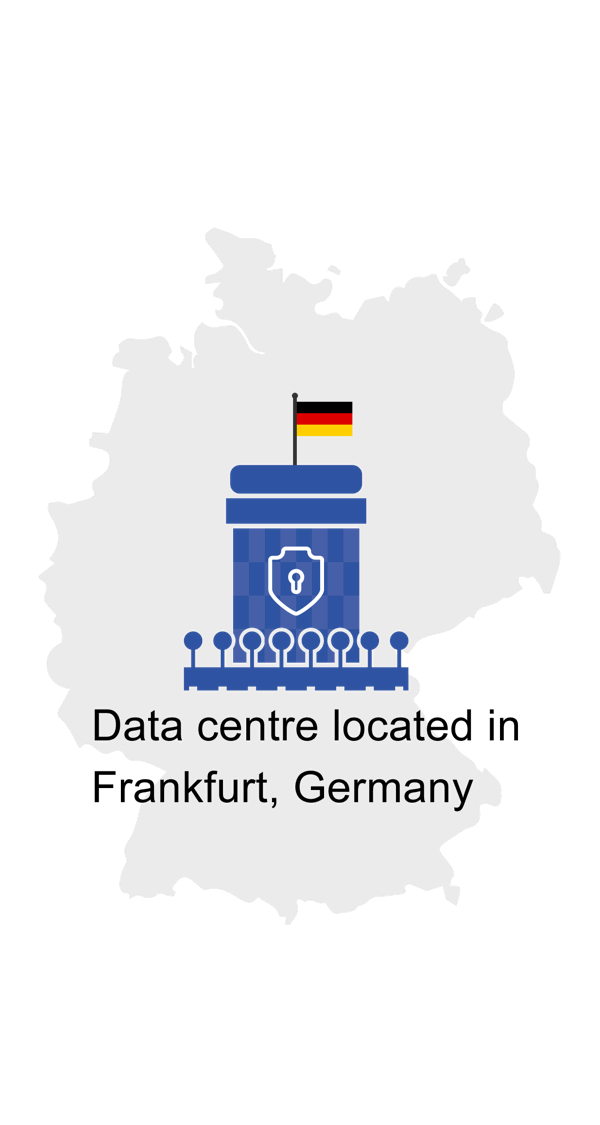
A Beginner’s Guide to Omnichannel Analytics

What is last click attribution? A beginner’s guide

Introducing the Matomo Connector for Looker Studio (Formerly Google Data Studio)
Subscribe to our newsletter to receive regular information about Matomo. You can unsubscribe at any time from it. This service uses MadMimi. Learn more about it within our privacy Policy page.
A powerful web analytics platform that gives you and your business 100% data ownership and user privacy protection.
No credit card required.
Free forever.
Newsletter Subscription - English

IMAGES
VIDEO
COMMENTS
The customer journey map template can also help you discover areas of improvement in your product, marketing, and support processes. Download a free, editable customer journey map template. Types of Customer Journey Maps and Examples. There are 4 types of customer journey maps, each with unique benefits. Pick the one that makes the most sense ...
The Customer Value Journey is a roadmap that enhances our inbound marketing strategies by building authentic and meaningful customer relationships, turning them into our biggest fans and advocates. It consists of six key steps: Awareness, Engagement, Conversion, Experience, Loyalty Loop, and Advocacy, each utilizing unique Digital Marketing ...
Everything You Ever Wanted to Know About Inbound Marketing - Why Inbound? Inbound Marketing 101: Customer Personas and Business Use Cases; And, if you want to map your customers' journeys but need some assistance or advice, the inbound marketing team at VONT will be glad to help you out, so give us a shout! About VONT Performance Digital ...
Inbound marketing is an effective methodology for grabbing the attention of customers, making your company easy to find and drawing people in to find out more. Using inbound marketing strategies ...
6. Smaply. Smaply is a visual customer experience management software mostly used for customer journey mapping, visualizing buyer personas, and creating stakeholder maps. The tool consists of features like storyboards, persona editor, channels, live data for KPI monitoring, backstage processes, and many more.
Defining the Three Stages of the Customer Journey. The Buyer's Journey Example via Hubspot. Inbound marketing leverages awareness of the customer journey in its four-step methodology: The Hubspot Inbound Methodology via Hubspot. Knowing where your contacts and clients are in the customer journey helps you send the right messages to the right ...
Inbound marketing is a great way to draw customers to your business. Learn the inbound marketing definition and how to get started with this guide. ... and email tools, you can generate more engagement and revenue. Plus, our Customer Journey Builder allows you to easily create trigger emails based on where people are in your sales funnel ...
An inbound marketing methodology is a customer-centric approach to attracting, engaging, and delighting customers. ... In the context of inbound, the flywheel represents the entire customer journey, from the moment a potential customer is attracted to your business through relevant and valuable content, to the point where they become a ...
She's earned certifications in inbound marketing, content marketing, Google Analytics, and PR. Her favorite topics include digital marketing, social media, and AI. ... biking, or playing with her dogs. Customer journey map definition: A customer journey map is a visual representation of the stages customers go through when interacting with ...
Inbound marketing implemented gingerly into the stages of a customer journey is the perfect combination to ensure customer satisfaction and retention. For starters, it is essential to realize that connecting with your customers on a single point during the purchase is not enough and that you need to invest more of yourself to make the whole ...
It helps organisations look at all the important touchpoints in that journey that can help or hinder progress towards the end goal. As an inbound marketing agency we focus on communication with the primary goal of generating leads. We also look at keeping customers once we have converted them. The inbound journey focuses on attracting attention ...
Step 6: Regularly Evaluate Your Journey Map Against Real-World Data and Trends. The final step in customer journey mapping begins when the map is complete. Customer experience strategy is an ongoing process, and much of it depends on making sure that your map remains both accurate and optimized.
Inbound marketing is a strategic approach focused on attracting customers through relevant and helpful content, adding value at every stage in the customer's buying journey. With the digital landscape shifting how consumers interact with businesses, inbound marketing channels have become essential in a company's strategy.
An outbound journey usually starts by sending out marketing emails to the members of a segment.) Though messaging and promotion strategies are typically different for inbound versus outbound campaigns, you design inbound customer journeys in Dynamics 365 Customer Insights - Journeys using the same tools as with an outbound customer journey.
Inbound marketing is when you attract leads by creating valuable online content to draw customers. A customer journey map (CJM) is a tool you use to walk in your customer's shoes from need identification to post-purchase support. An effective inbound strategy considers each buyer phase as well as buyer activity, feeling, and experience.
2. Convert. After you have attracted your visitors, the second stage of the funnel is to "convert" them into leads. In order to convert them, you have to give them a good reason to leave you their contacts. Once again it is the content that can help you with this goal.
Inbound Marketing In Action There isn't one single way to set up an effective inbound marketing campaign, as each must be customized for your specific sales journey, goals and capabilities.
Blogging, Inbound Marketing, Marketing, Customer Journey, Customer Journey Map Today's buyer is more informed than ever before, thanks to the vast amount of information available at their fingertips. Because of this, the balance of power has shifted from the sales rep to the buyer in most sales conversations.
4 stages of inbound marketing. Inbound marketing is about much more than website traffic. It's a full-funnel marketing strategy that activates your audience at each stage of the journey. Let's look at the four phases of the inbound methodology. Attract. The first inbound phase is attraction marketing. Your objective is to introduce your ...
The inbound marketing journey. Inbound marketing covers a lot of ground—both in terms of its many components and the range of media that can be used in an inbound campaign. ... Deliver more personalized customer experiences using Dynamics 365 Customer Insights—a customer journey orchestration and data platform that lets you build lasting ...
Two phrases that are commonly used interchangeably but are completely different are the buyers' journey and the customer's journey. In this blog, The Brit Agency is going to explore what both of these phrases mean, why they are so important to your B2B Inbound Marketing strategy and how they are different from each other.
A Beginner's Guide to Omnichannel Analytics. Erin. April 14, 2024. Linear customer journeys are as obsolete as dial-up internet and floppy disks. As a marketing manager, you know better than anyone that customers interact with your brand hundreds of times across dozens of channels before purchasing. That can make tracking them a nightmare ...
1. Boosting Active Prospecting, Outbound Efforts, and Social Selling. Inbound leads are not the only way to generate new business. Active prospecting and outbound efforts are still effective. You'll have to put in more effort up front, but it's going to be an important way to make up for a lack of inbound leads.
Enter CRM email marketing, the trusty team here to save the day! This dynamic duo lets you store precious customer data in a database tailored for email marketing bliss. Think of your CRM platform as the secret recipe and your email marketing tools as the whisk. Sure, you can make a delicious meal without them, but when they meet, you're ...
Improving marketing campaign ROI As previously mentioned, clickstream data analysis provides insights into the customer journey. Still, you may not realise that you can also use this data to keep track of your marketing effectiveness. Global digital ad spending continues to grow — and is expected to reach $836 billion by 2026. It's easy to ...